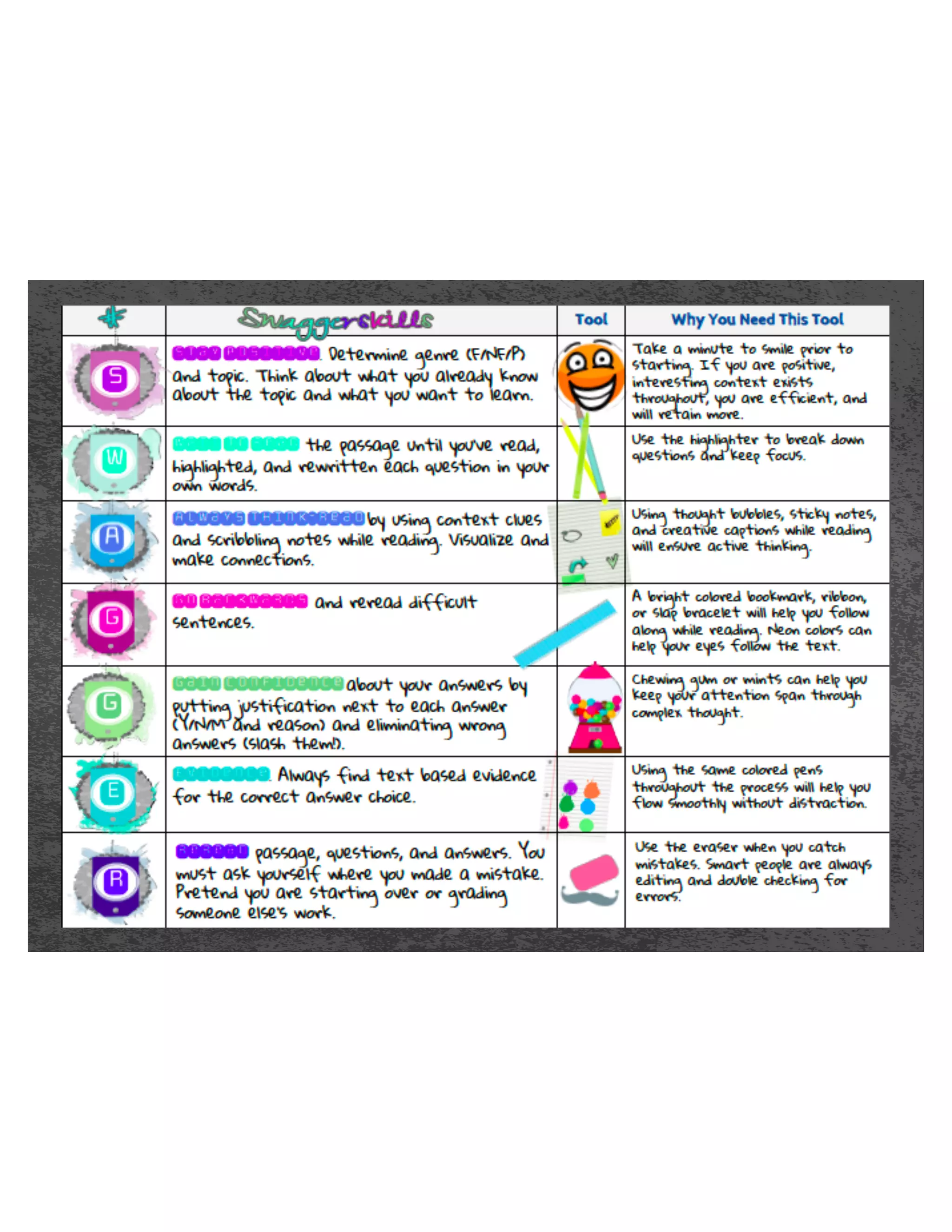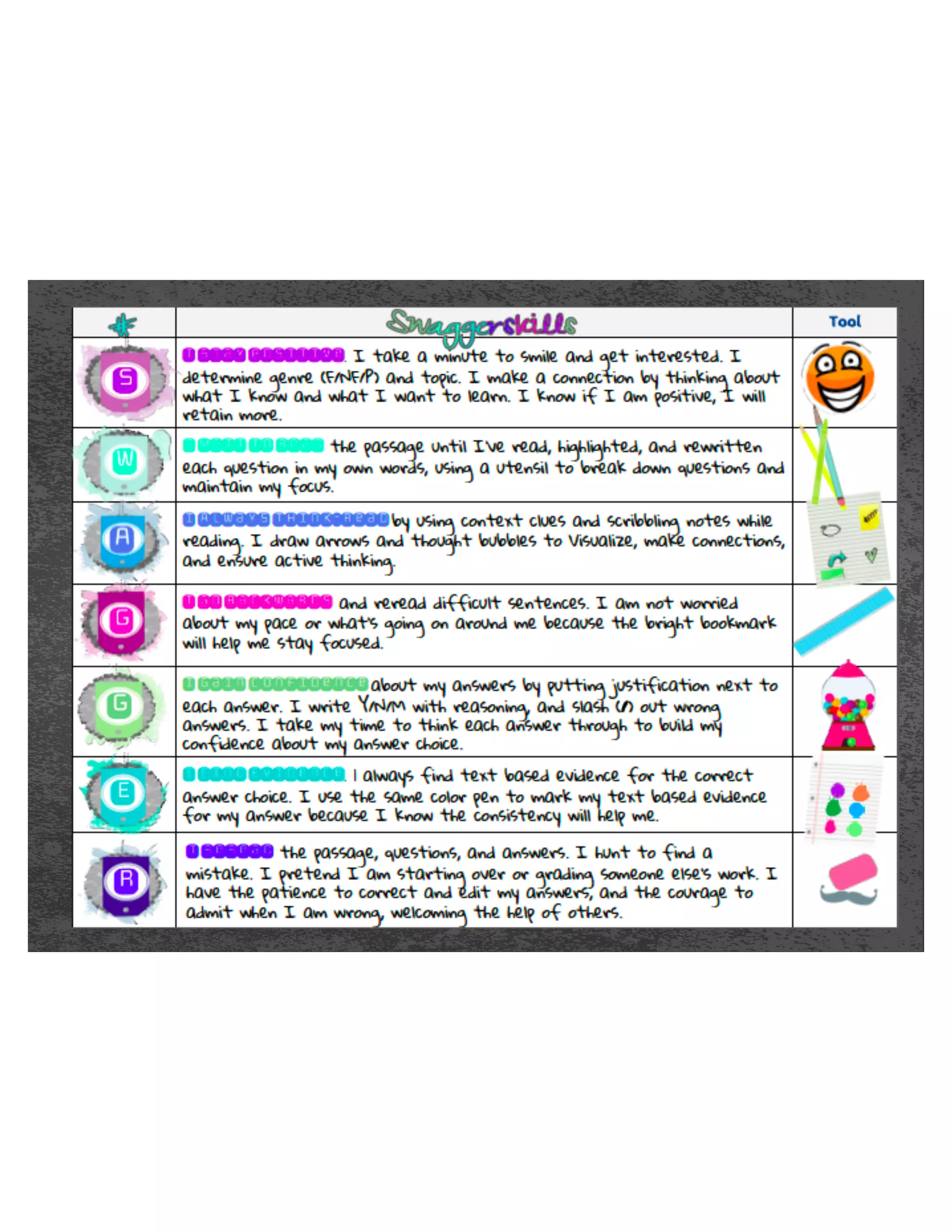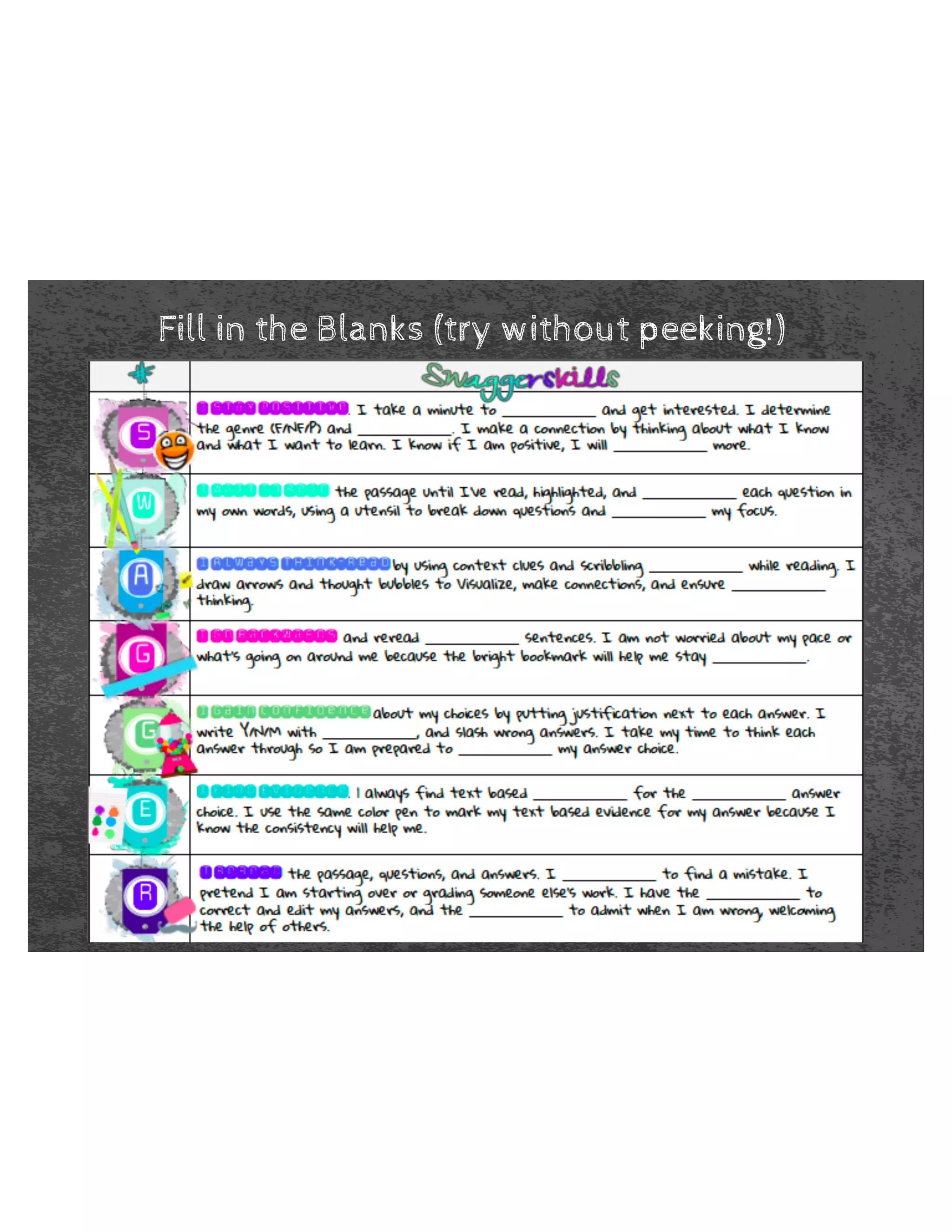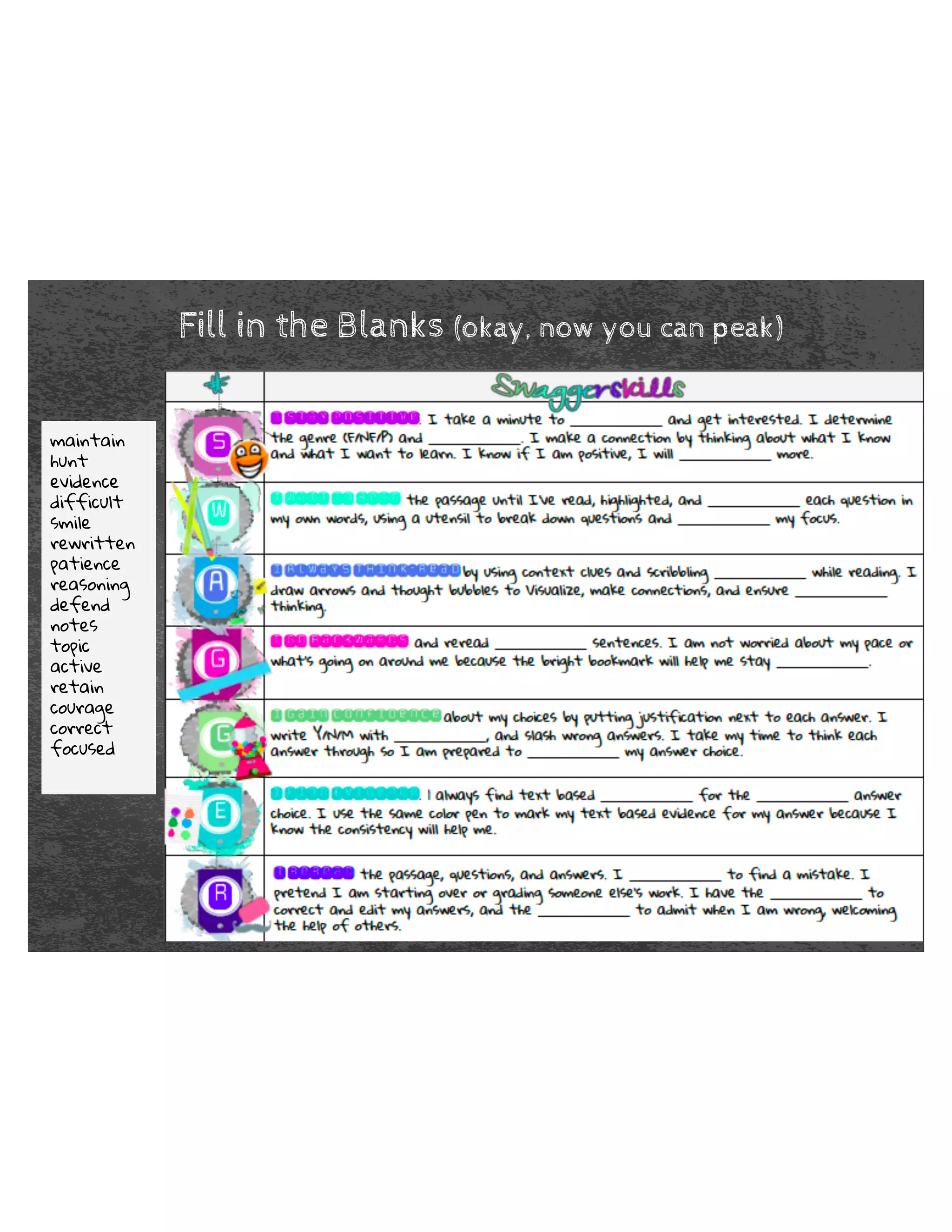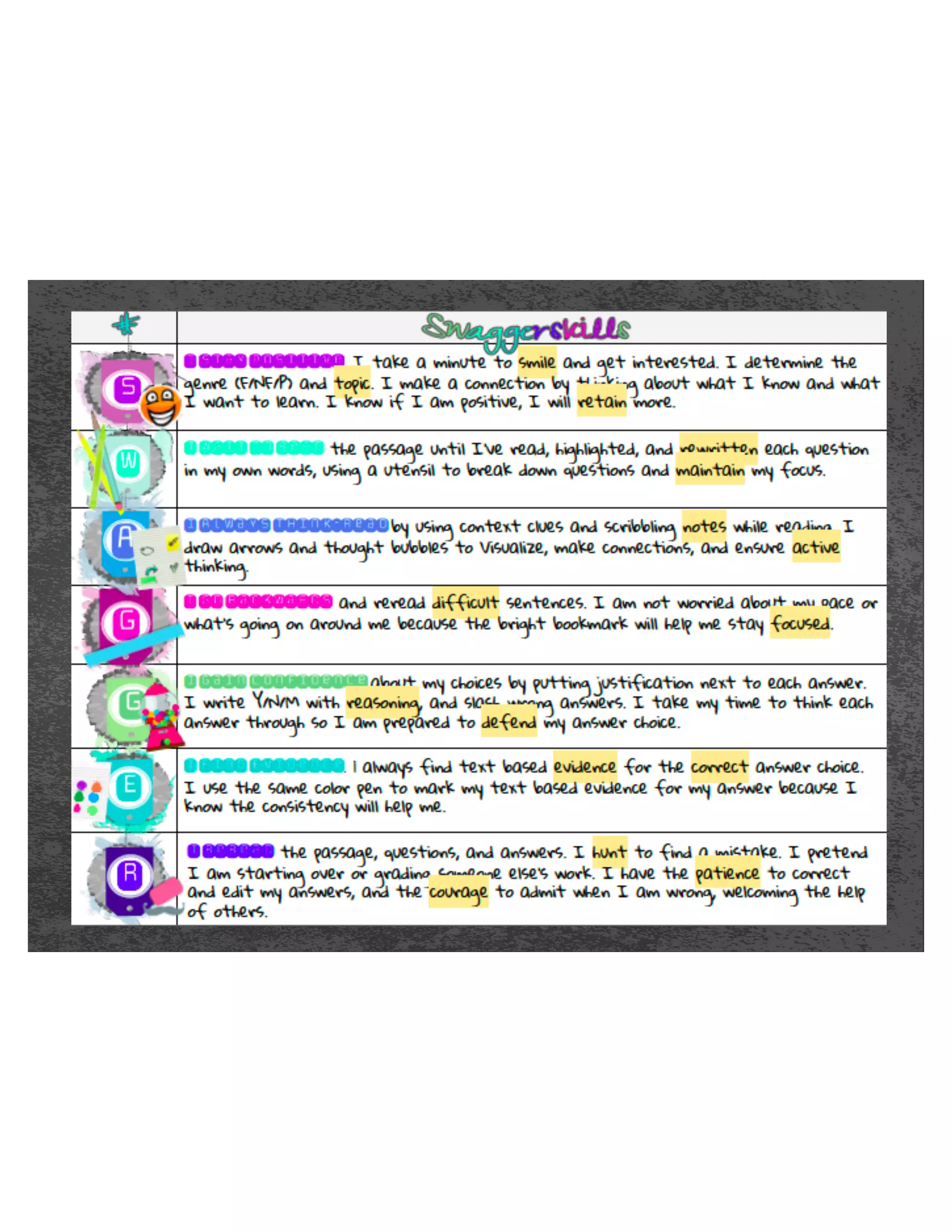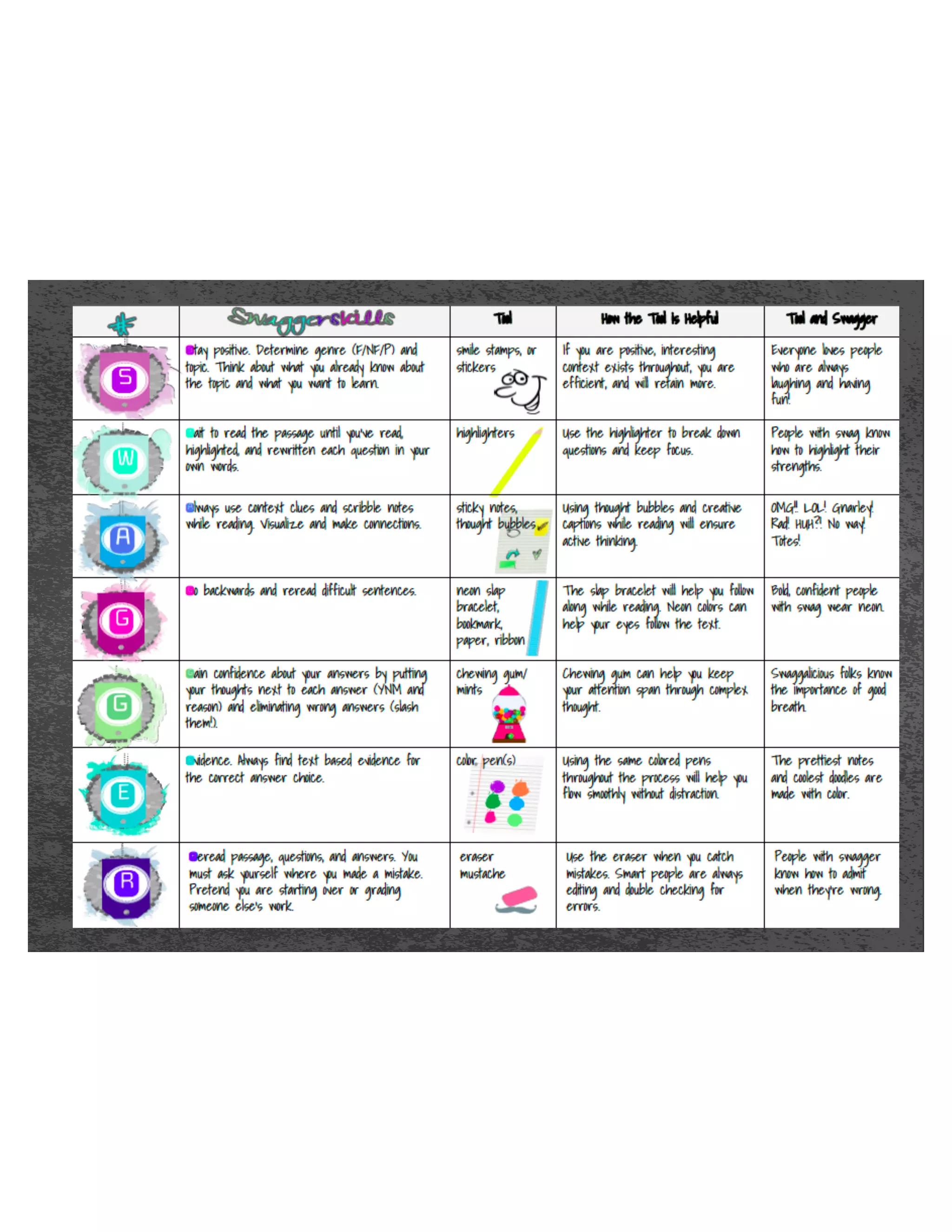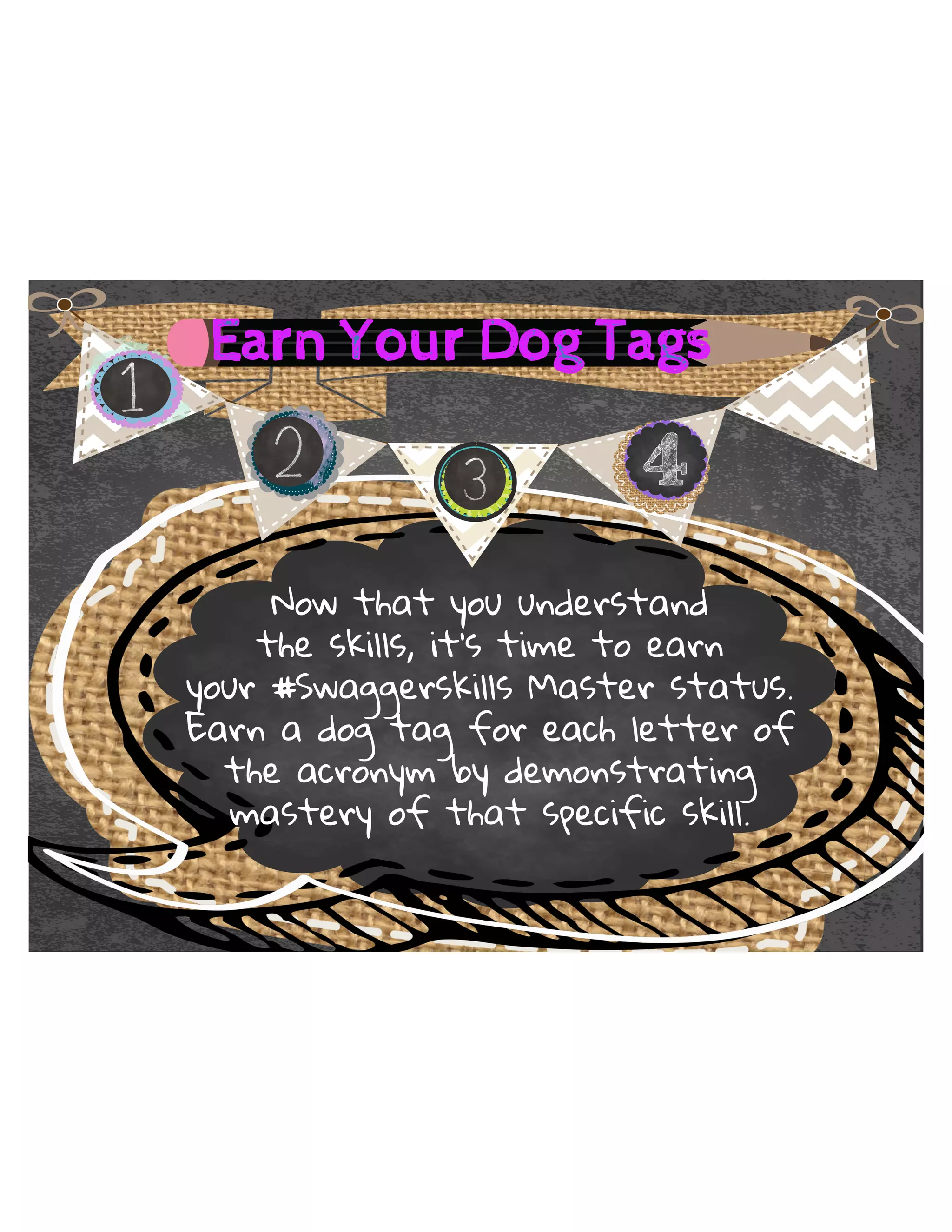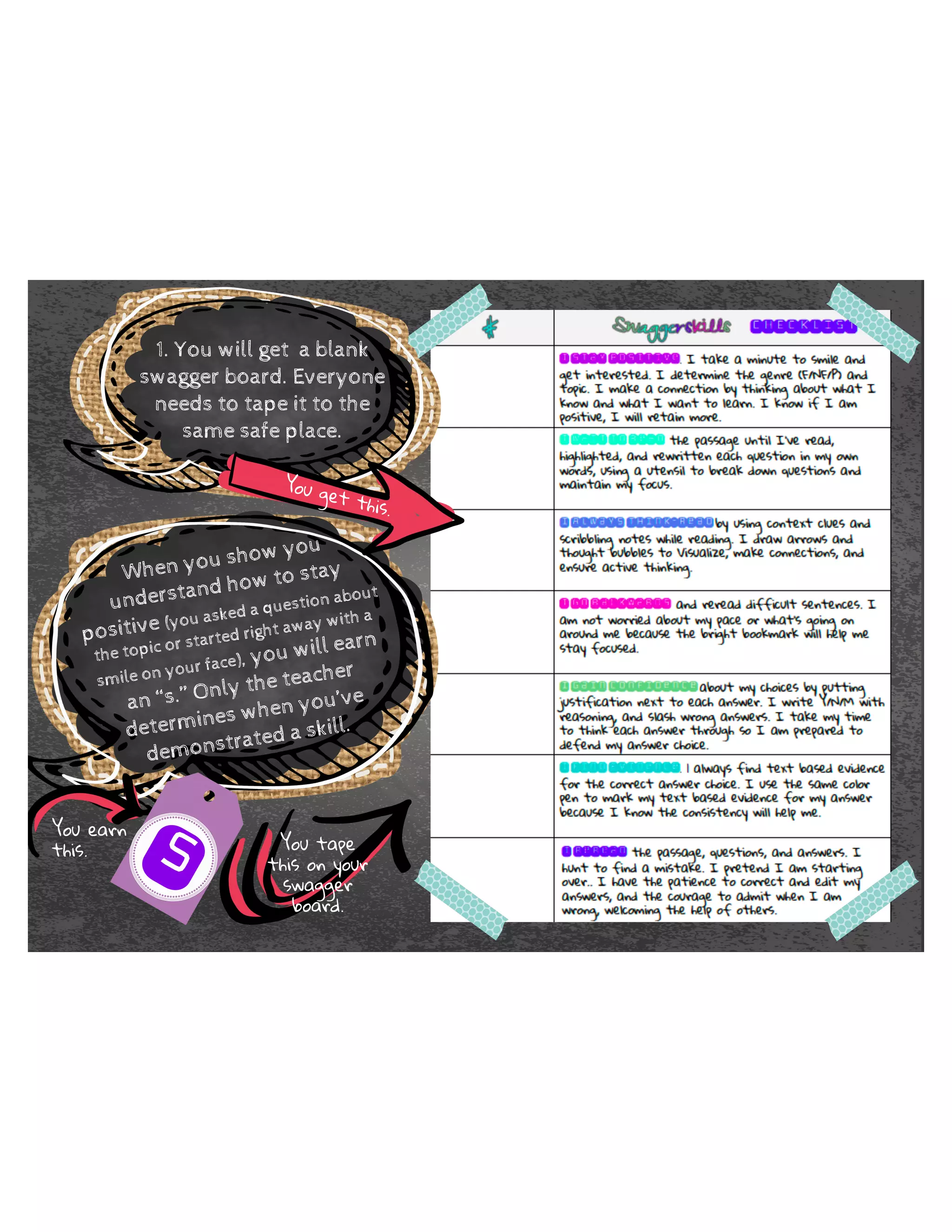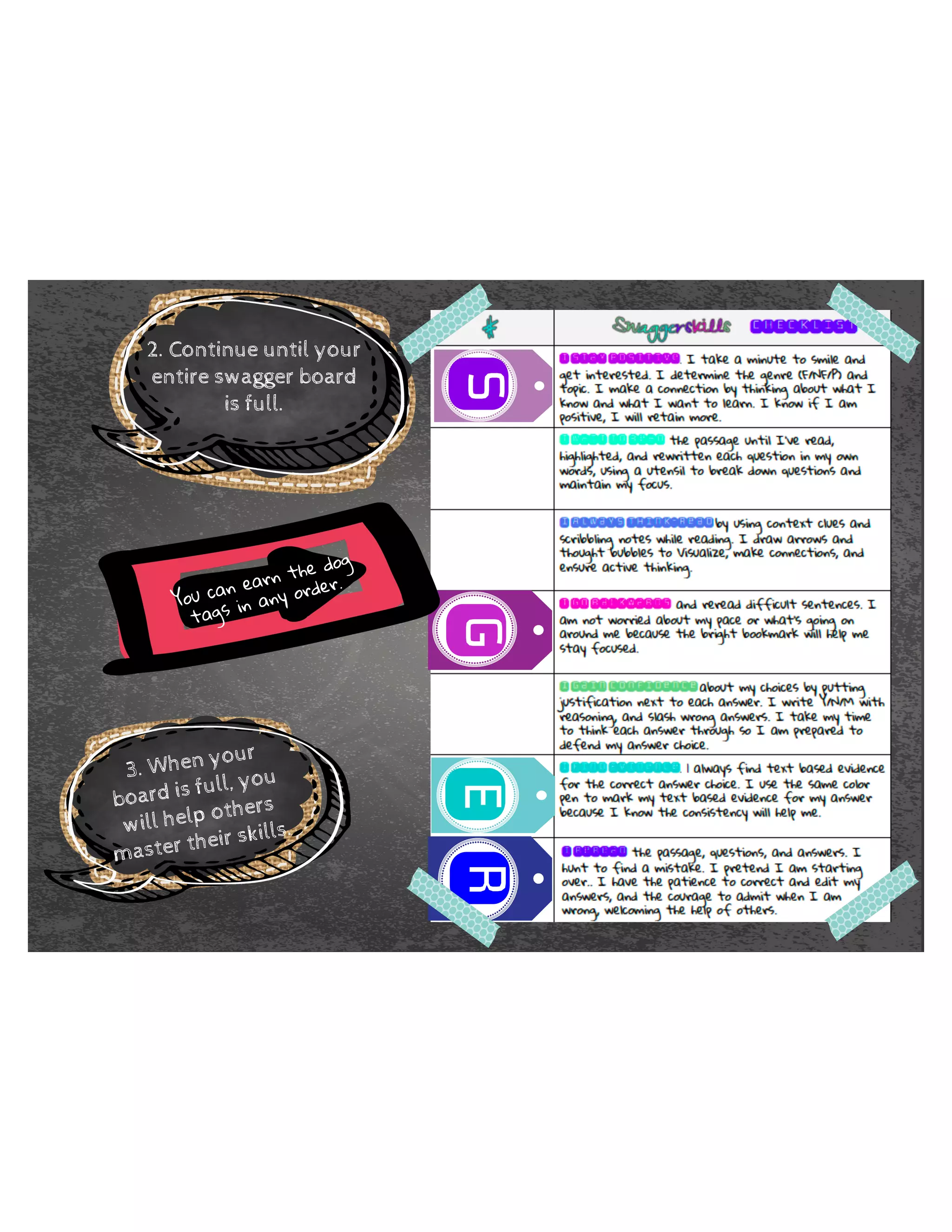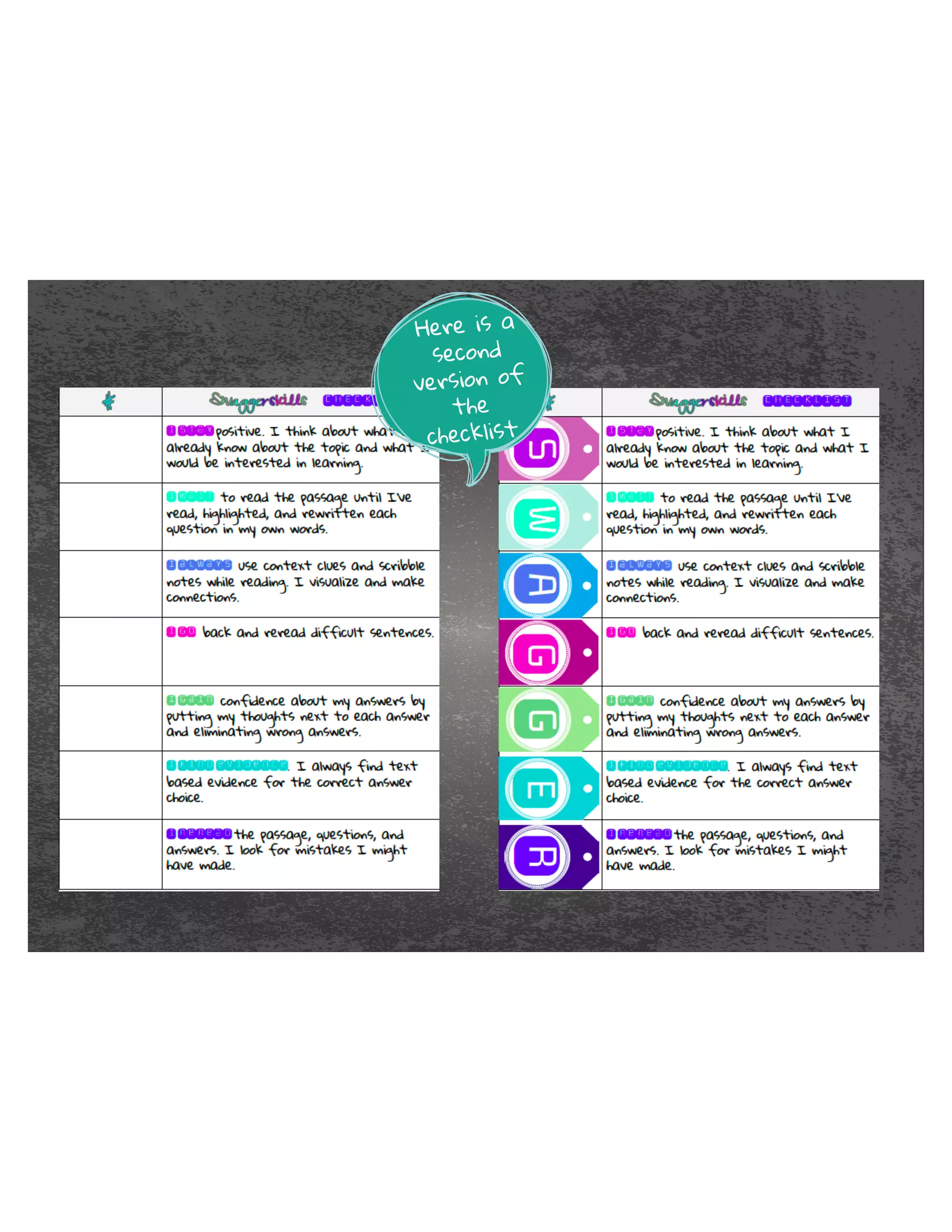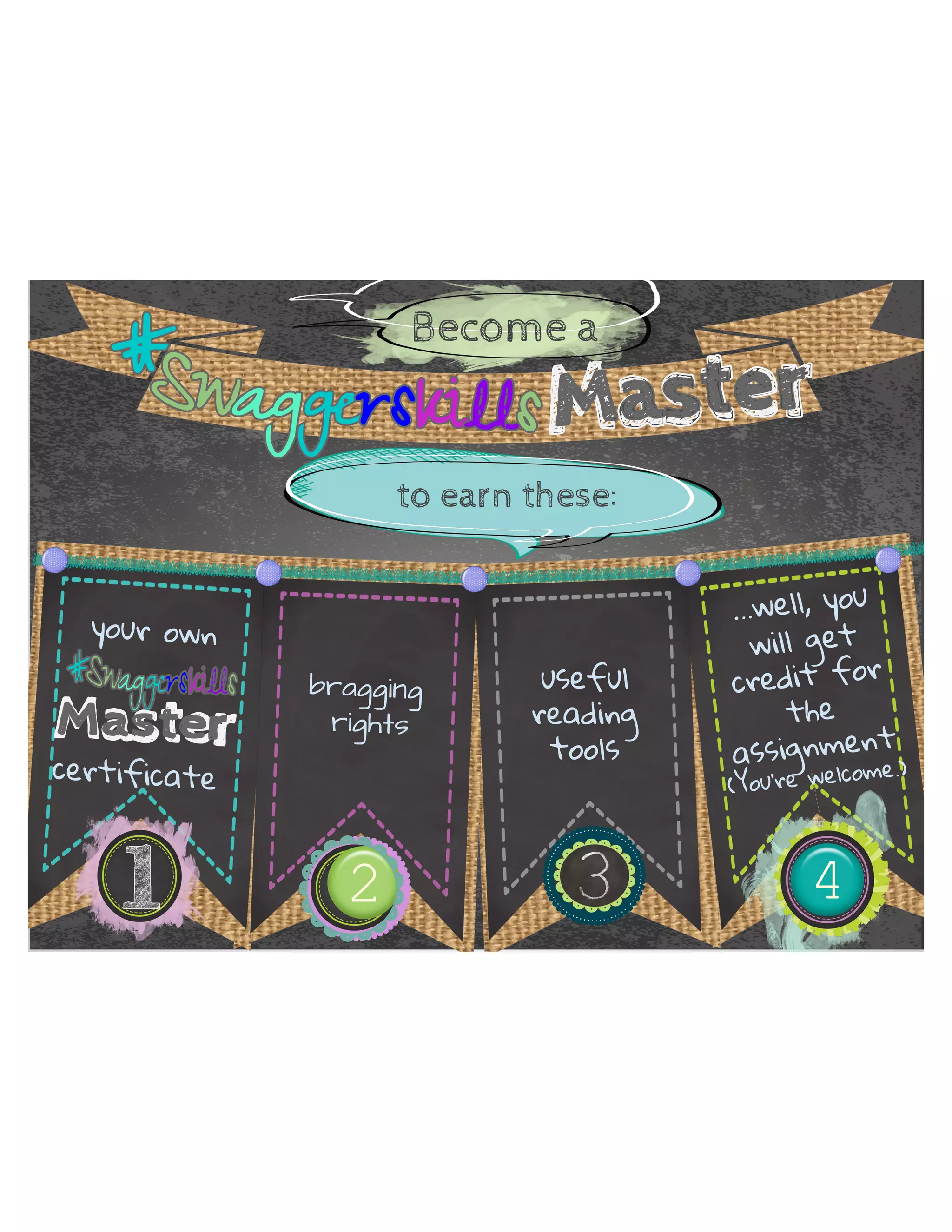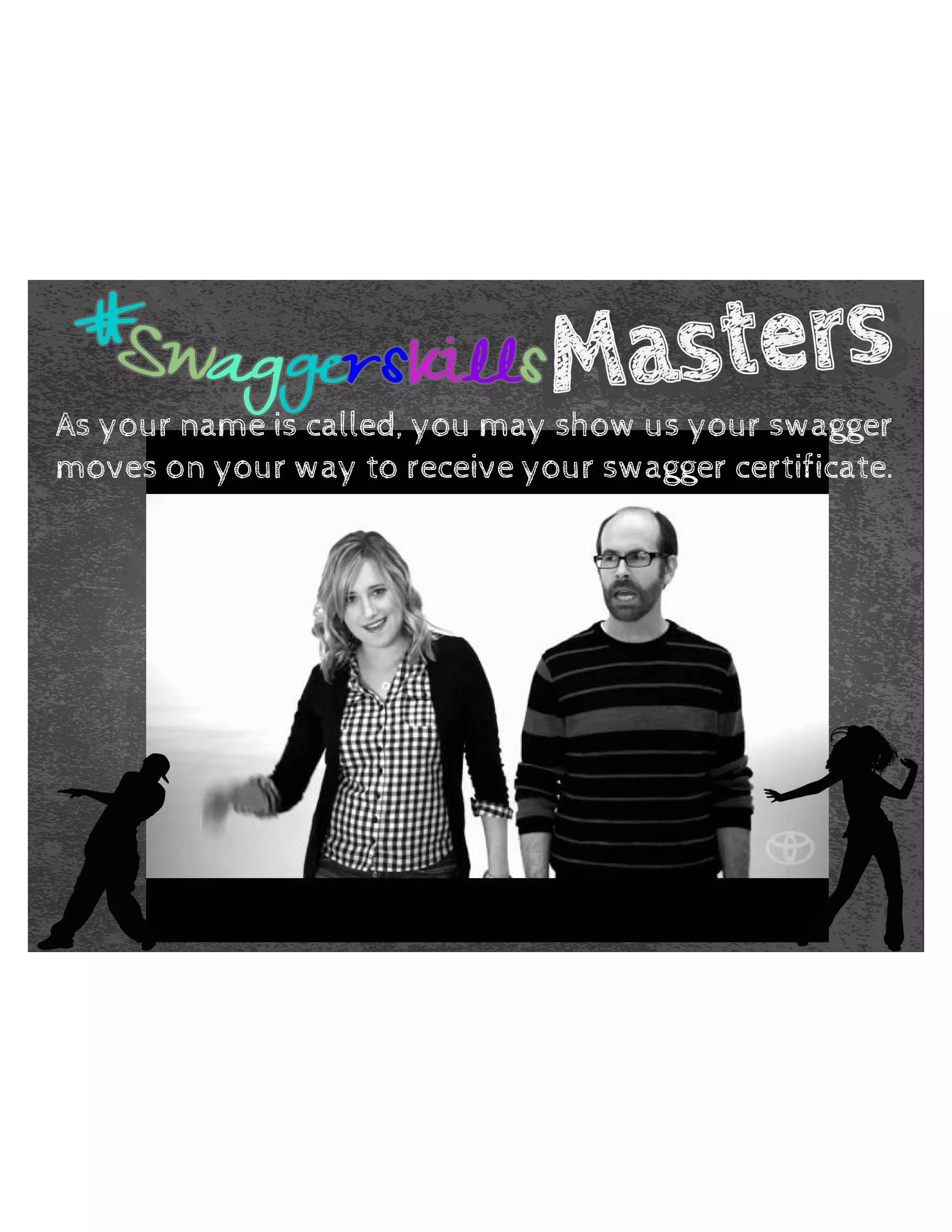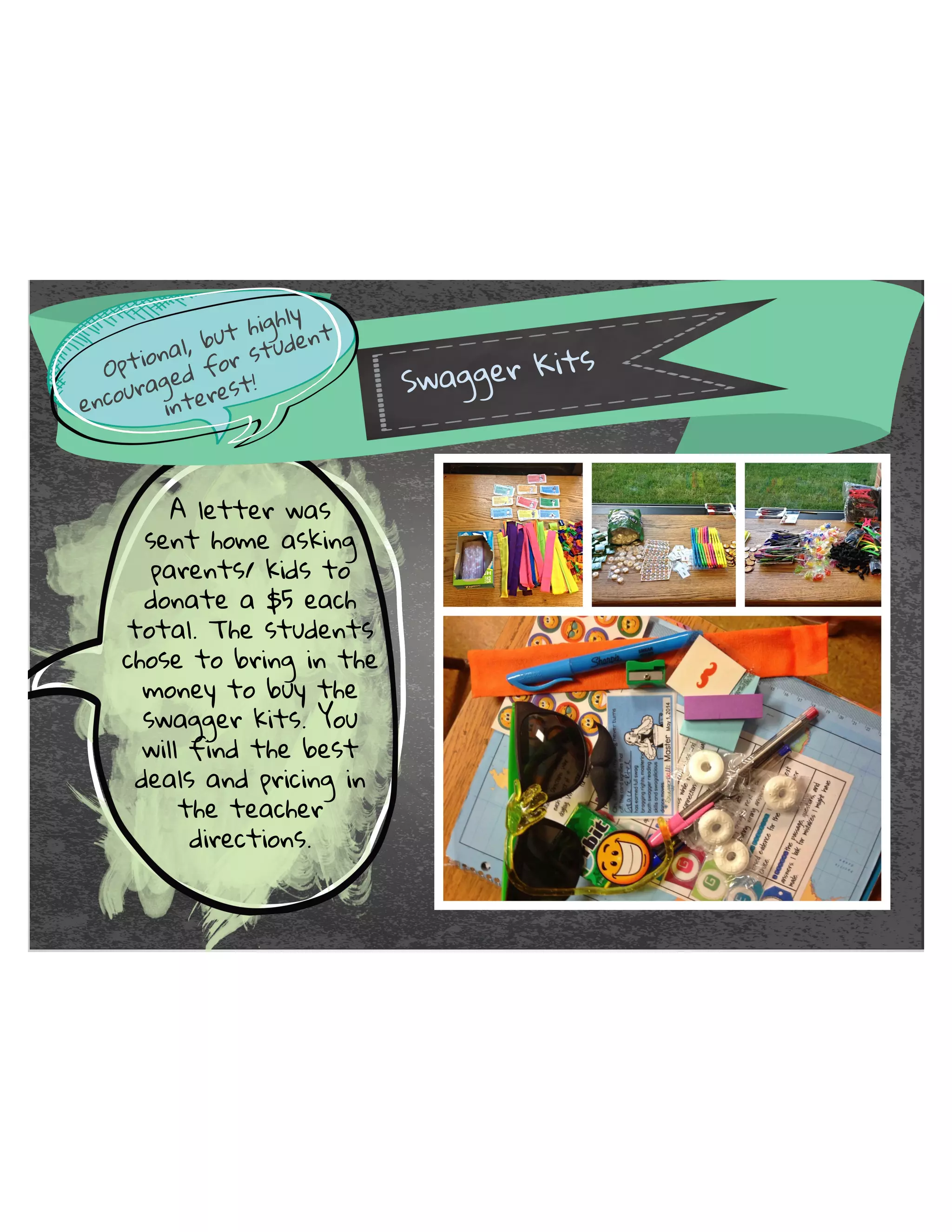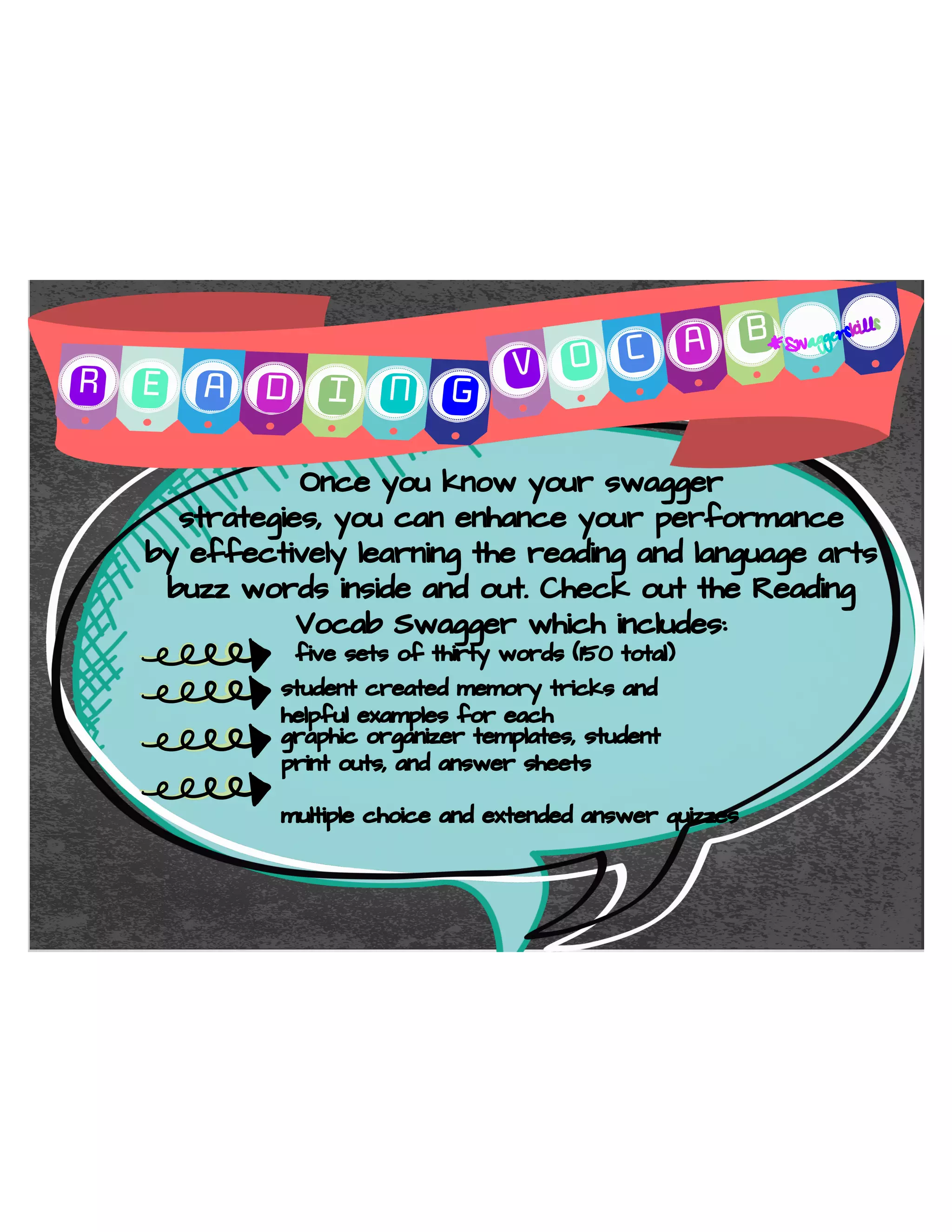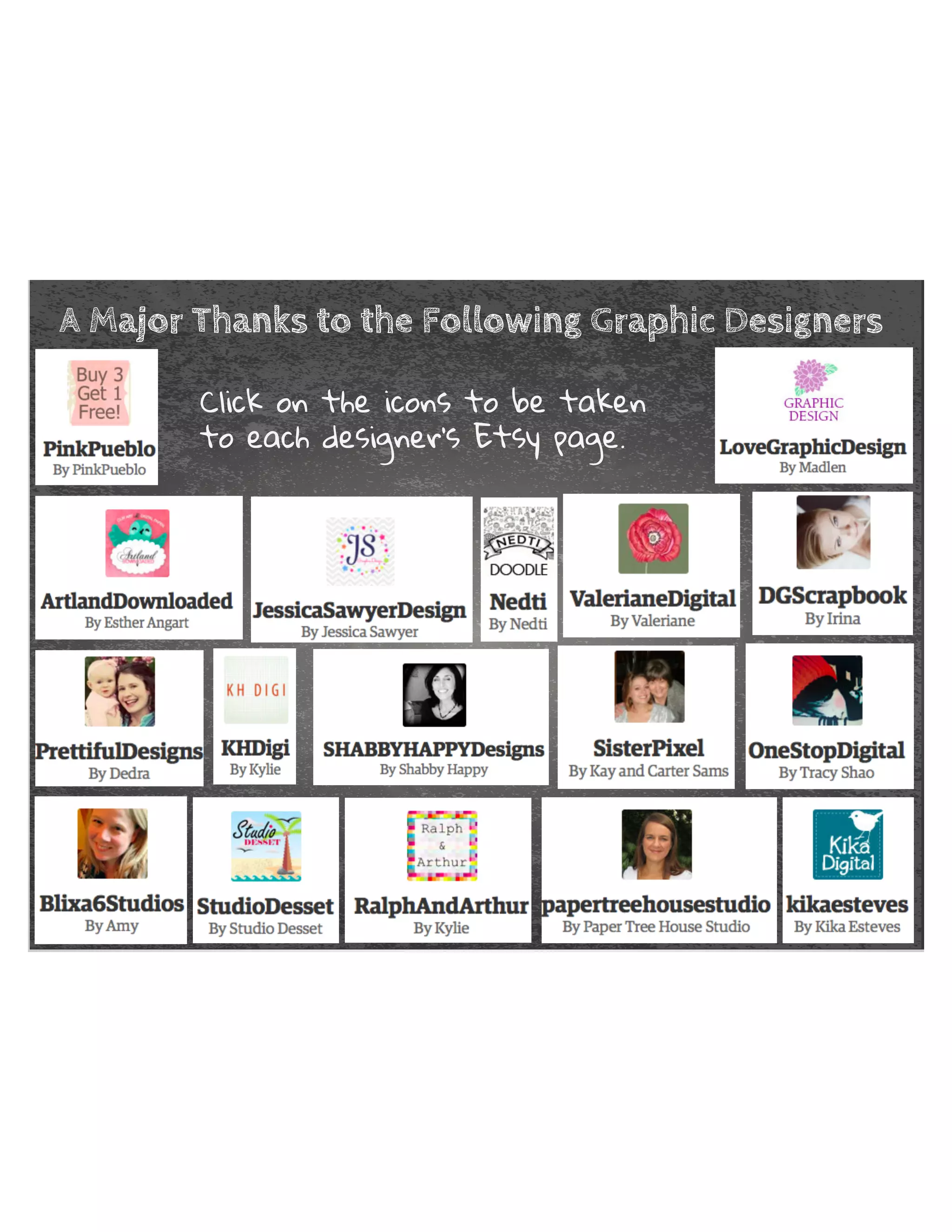The document outlines an interactive unit designed to teach students assessment strategies through a fun and engaging 'swagger' theme, applicable for various grade levels. It emphasizes building student confidence, reducing test anxiety, and enhancing engagement during test preparation by using creative tools and parent involvement. The unit includes a variety of materials and activities structured in a FAQ format to aid teachers in implementation while fostering a positive learning environment.
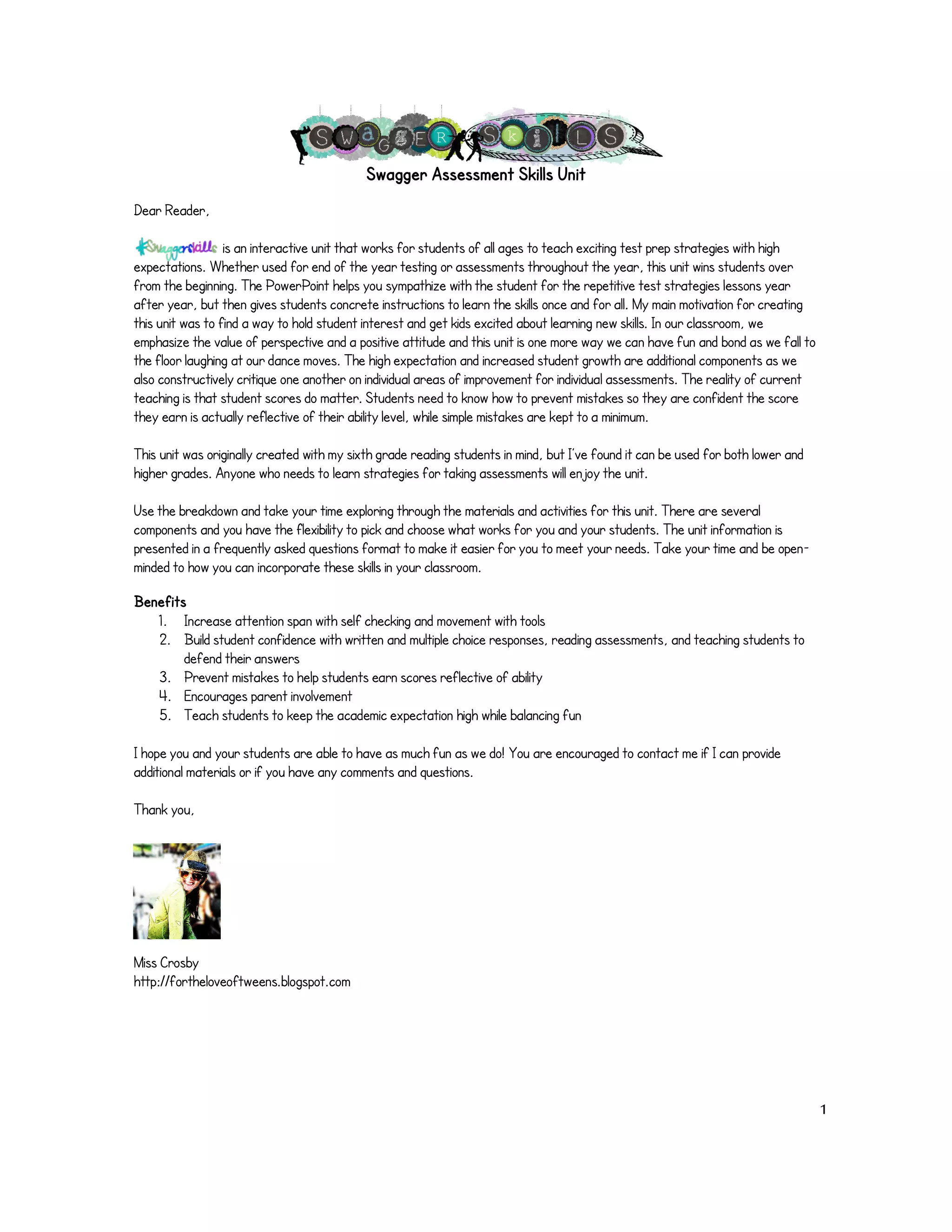
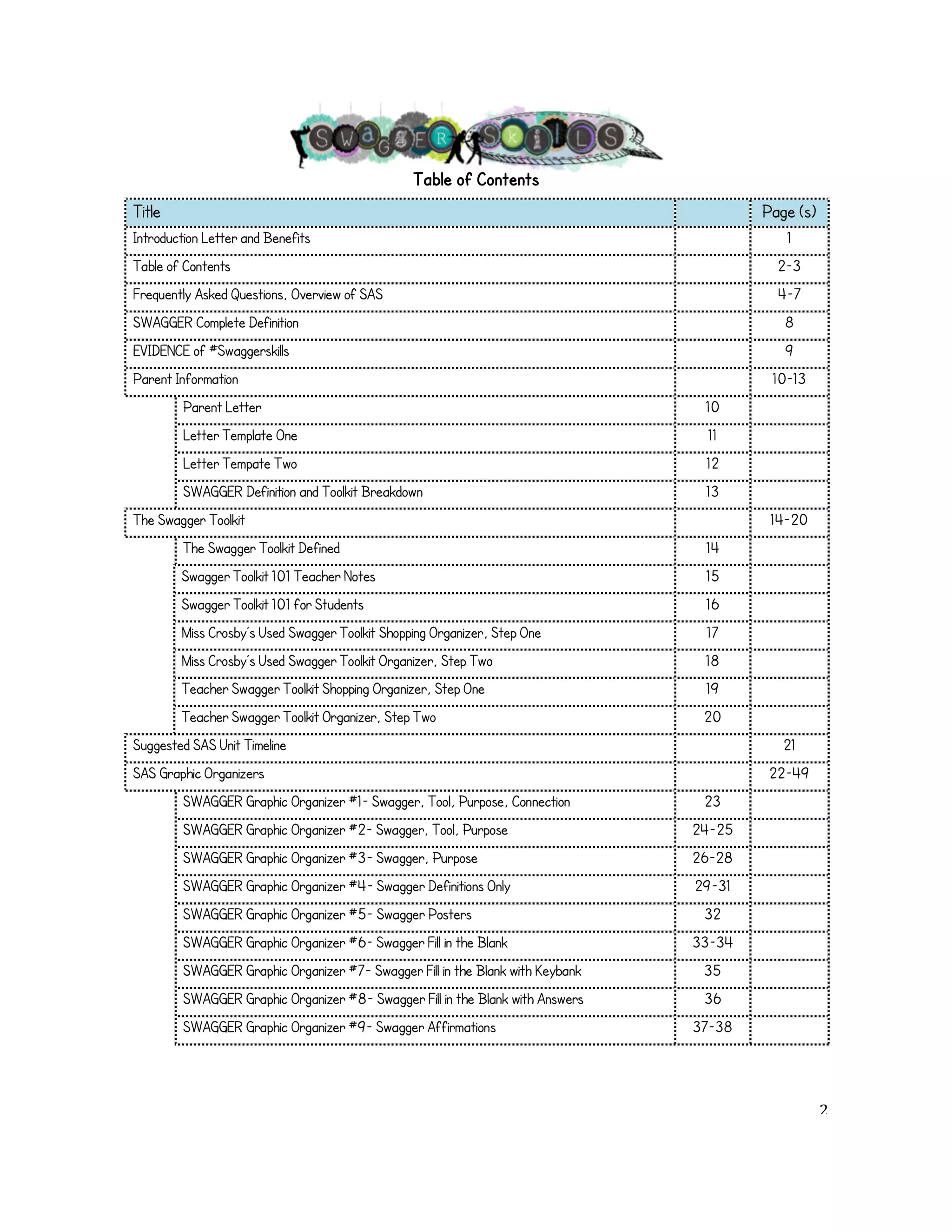
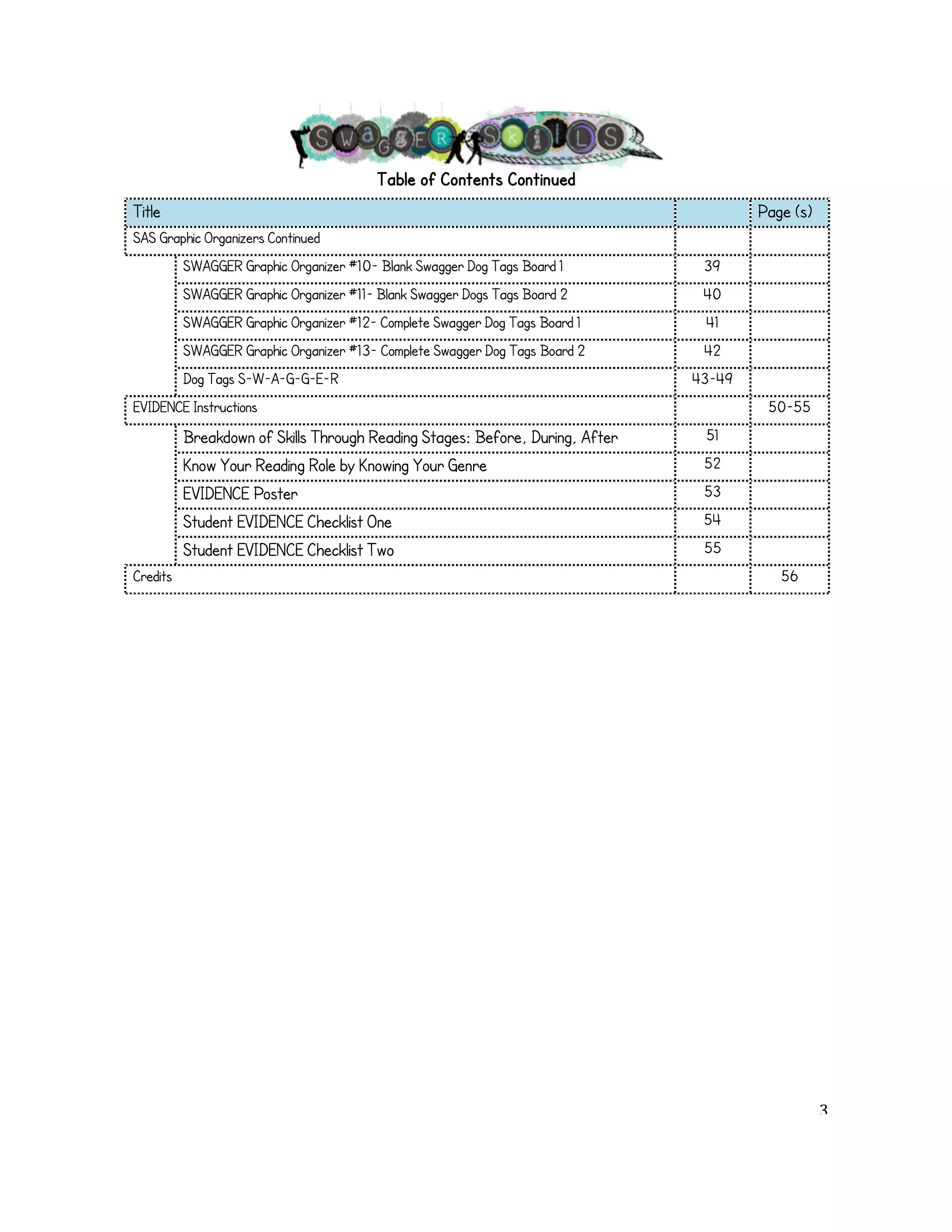
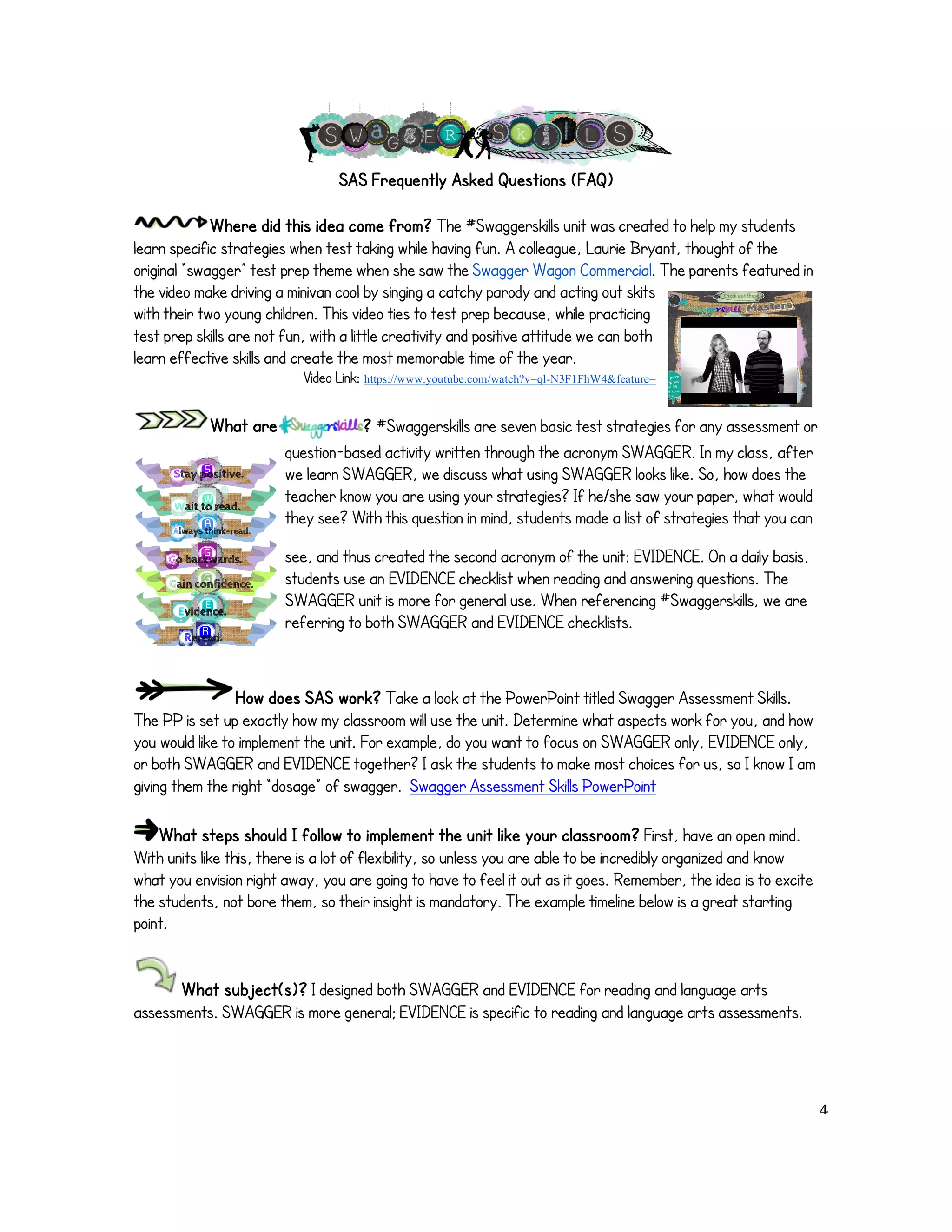
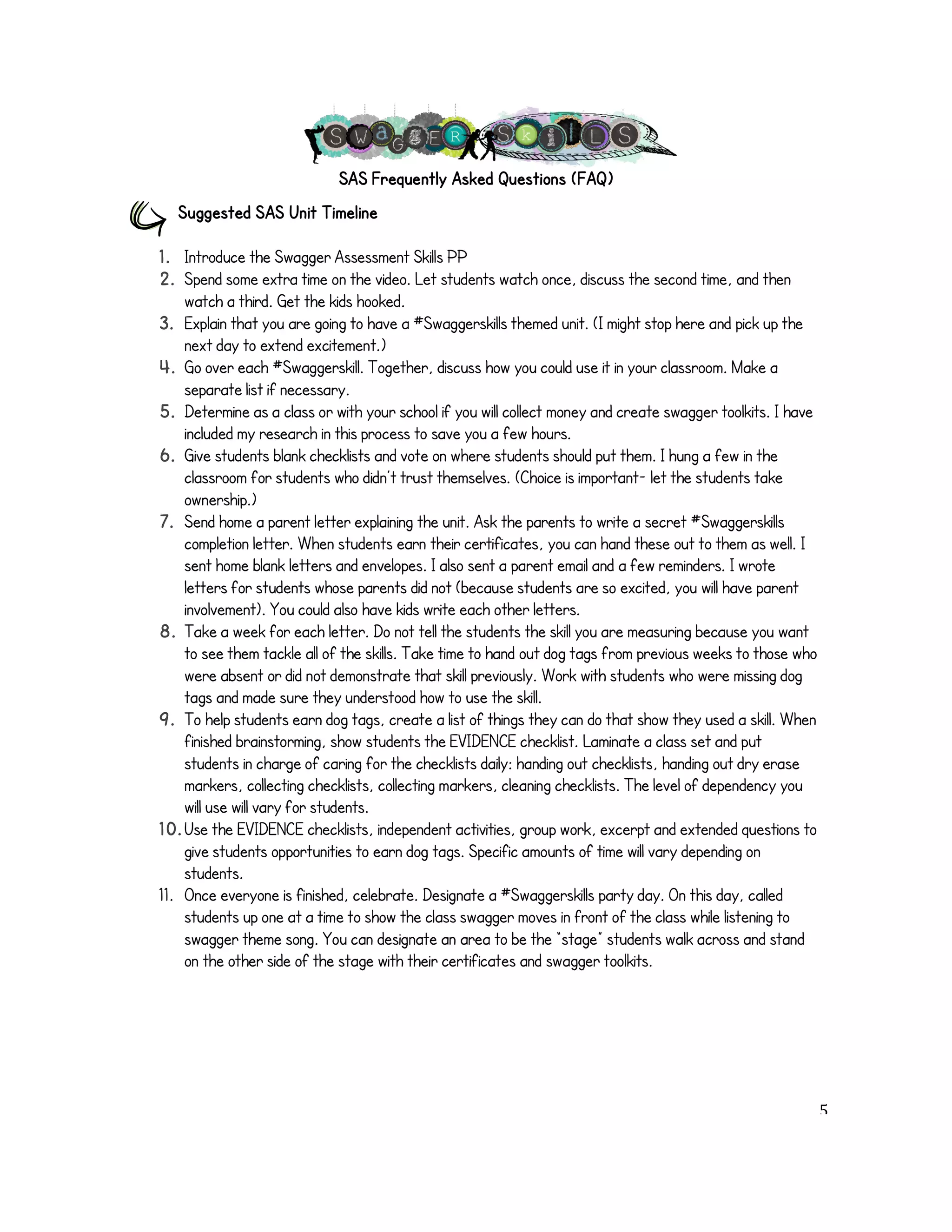
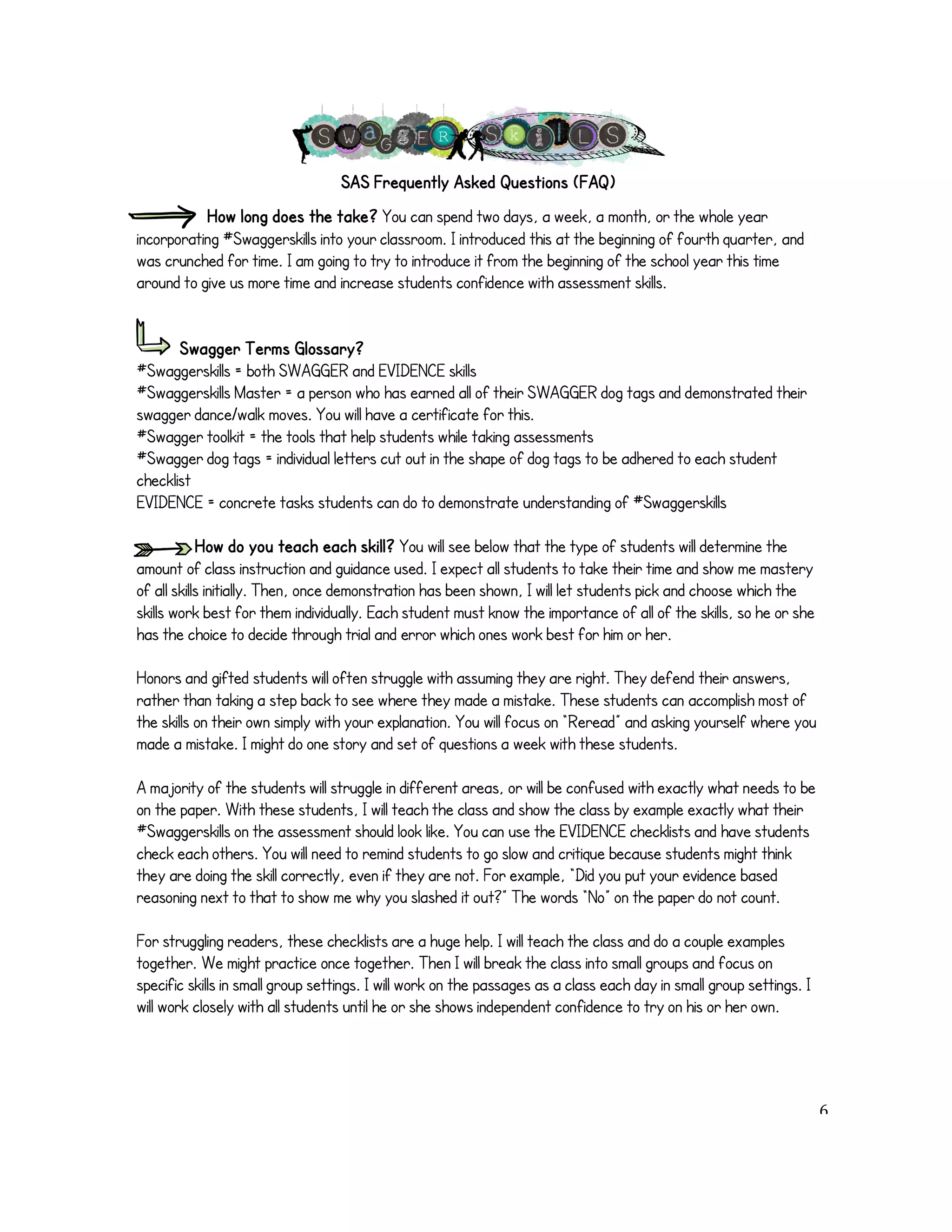
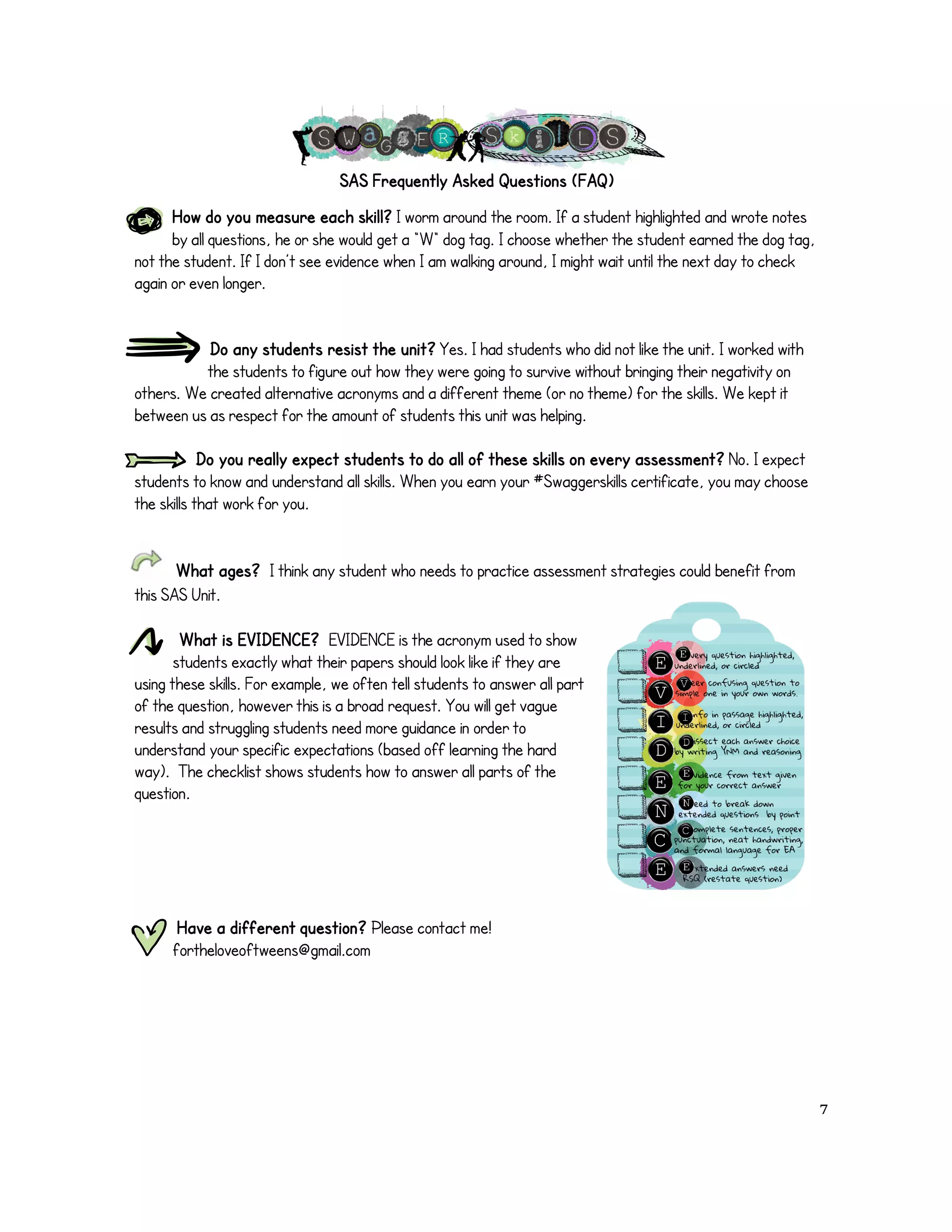

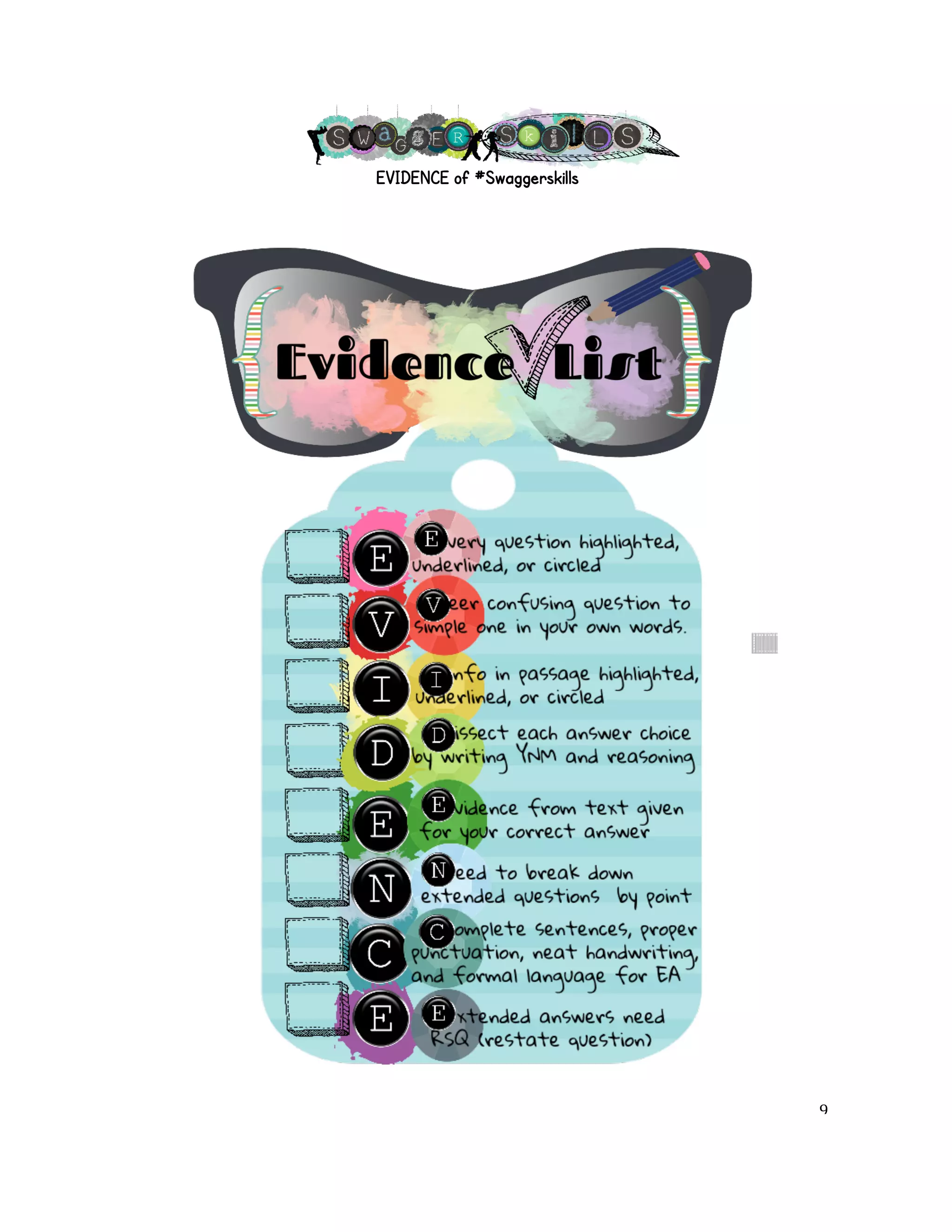
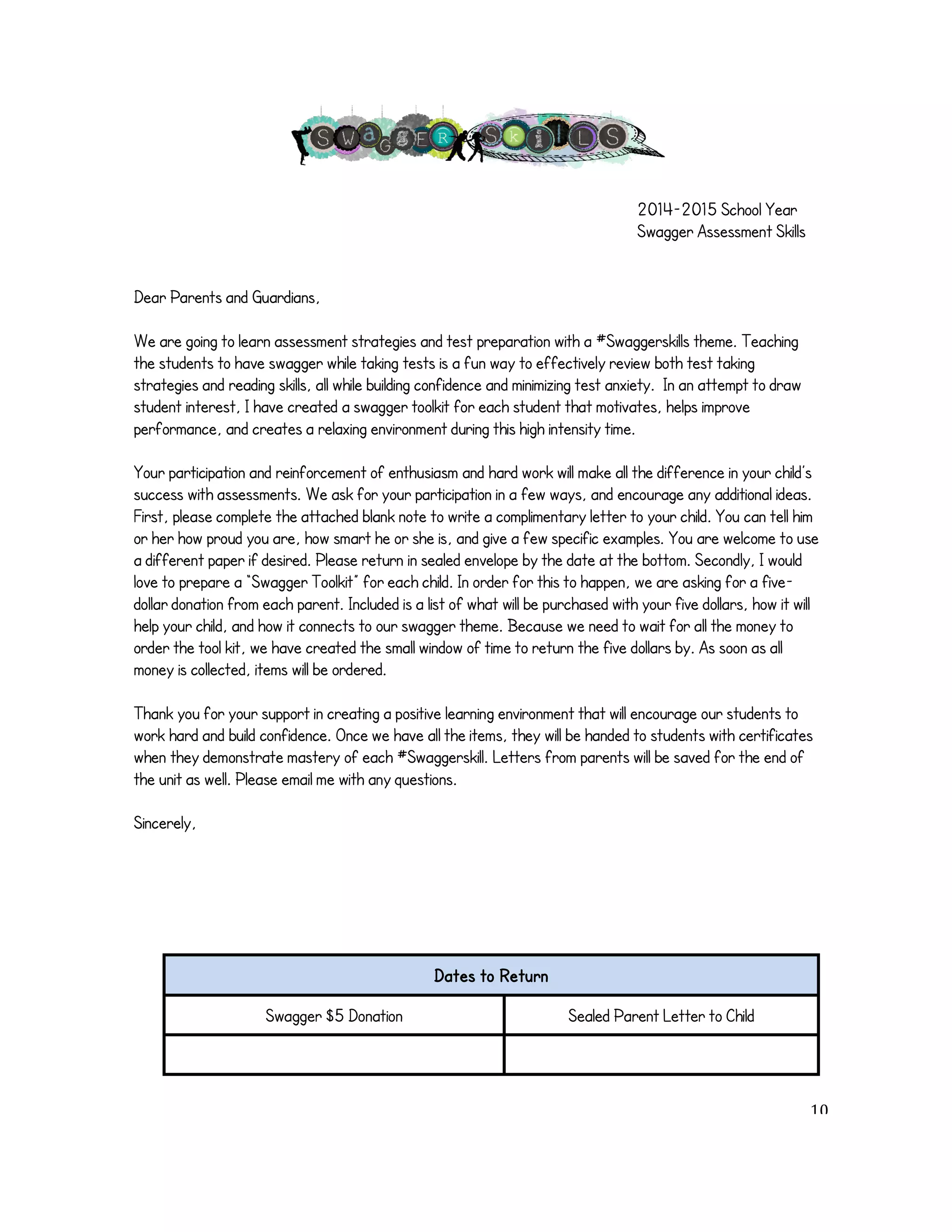
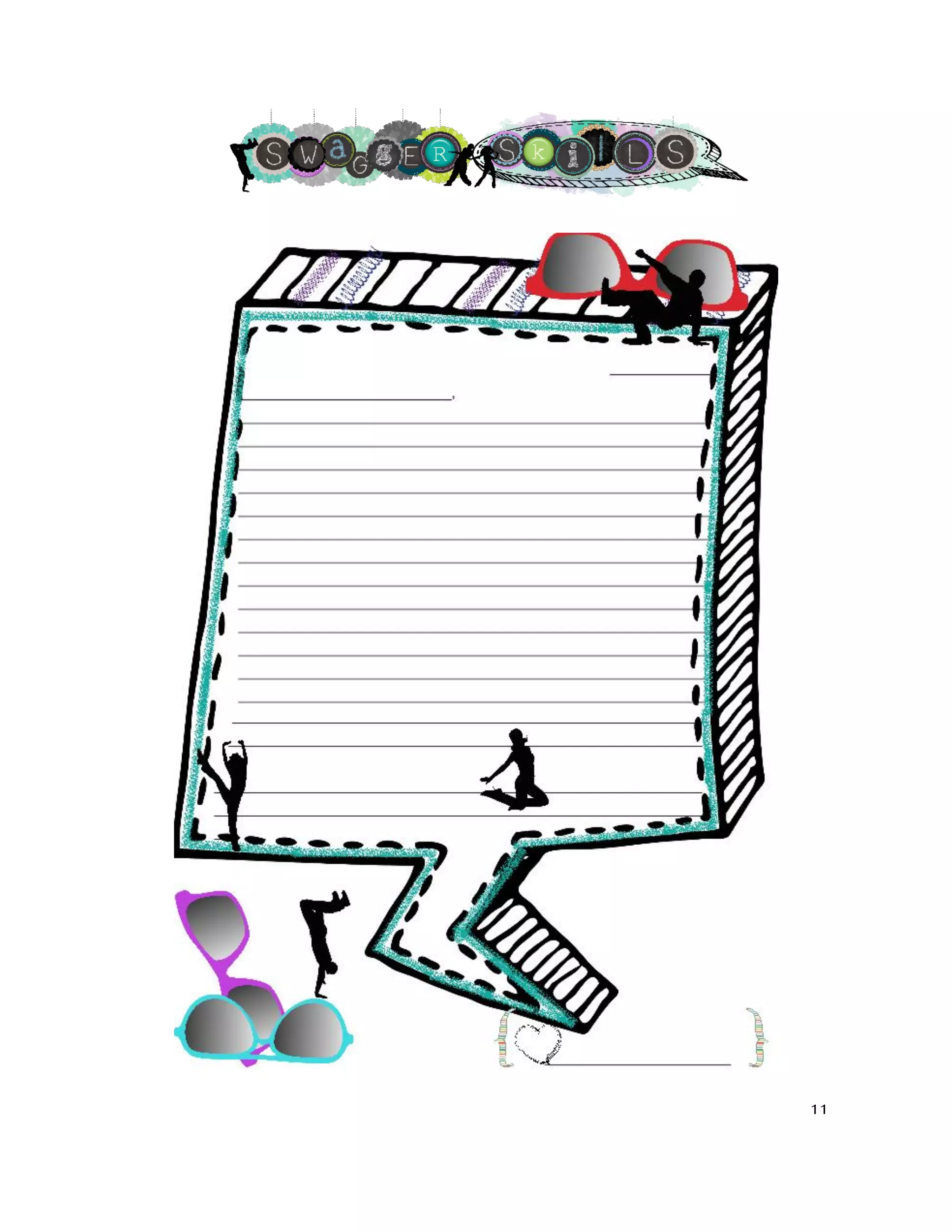
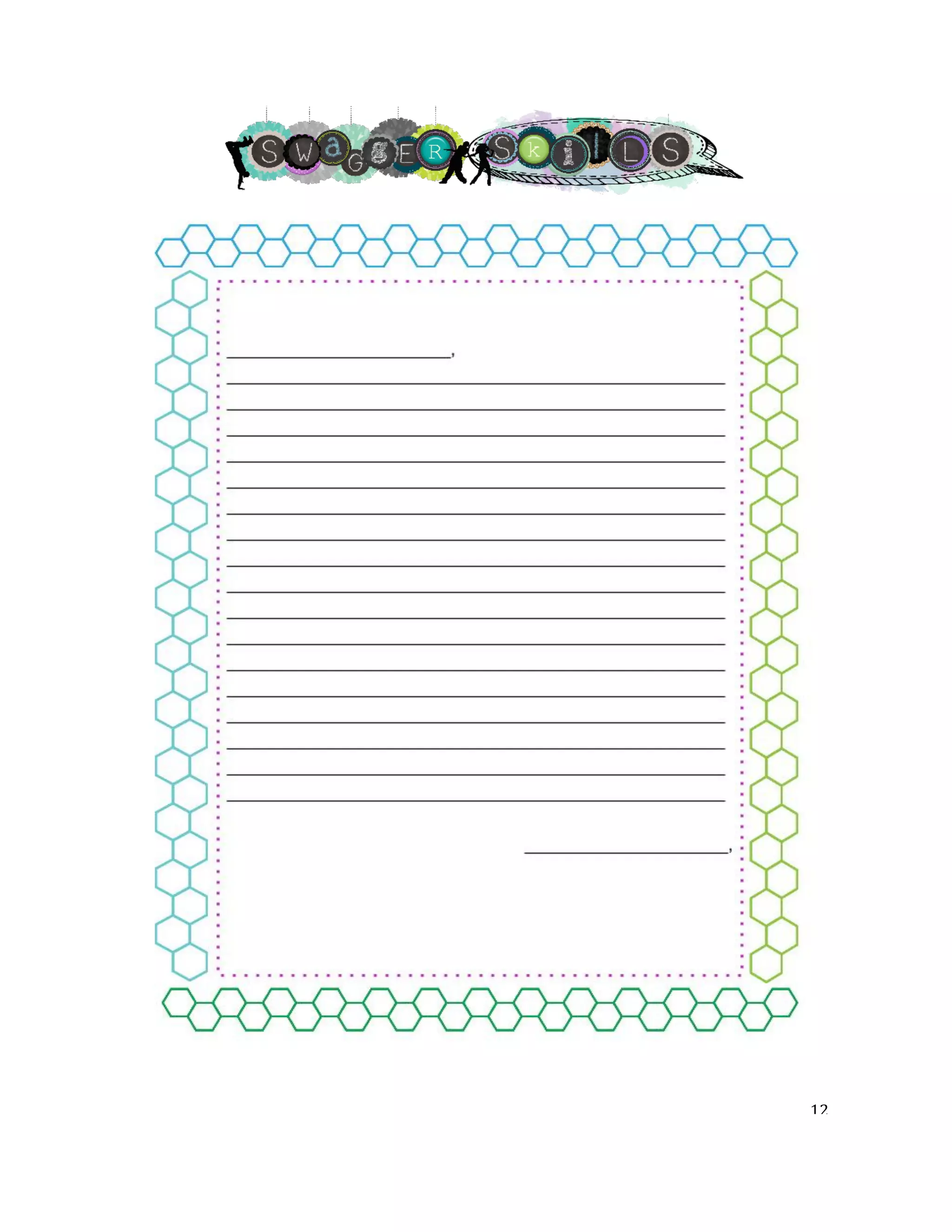
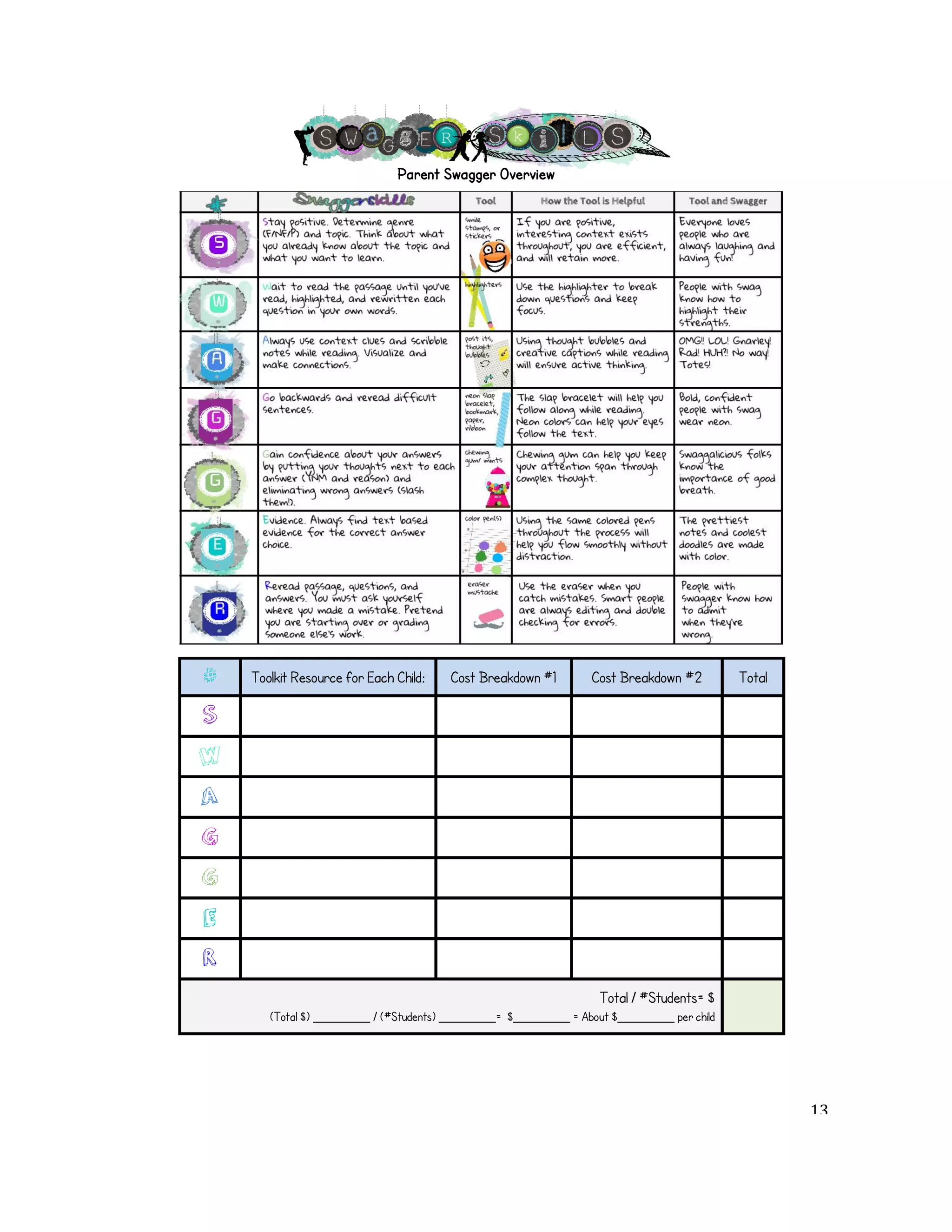
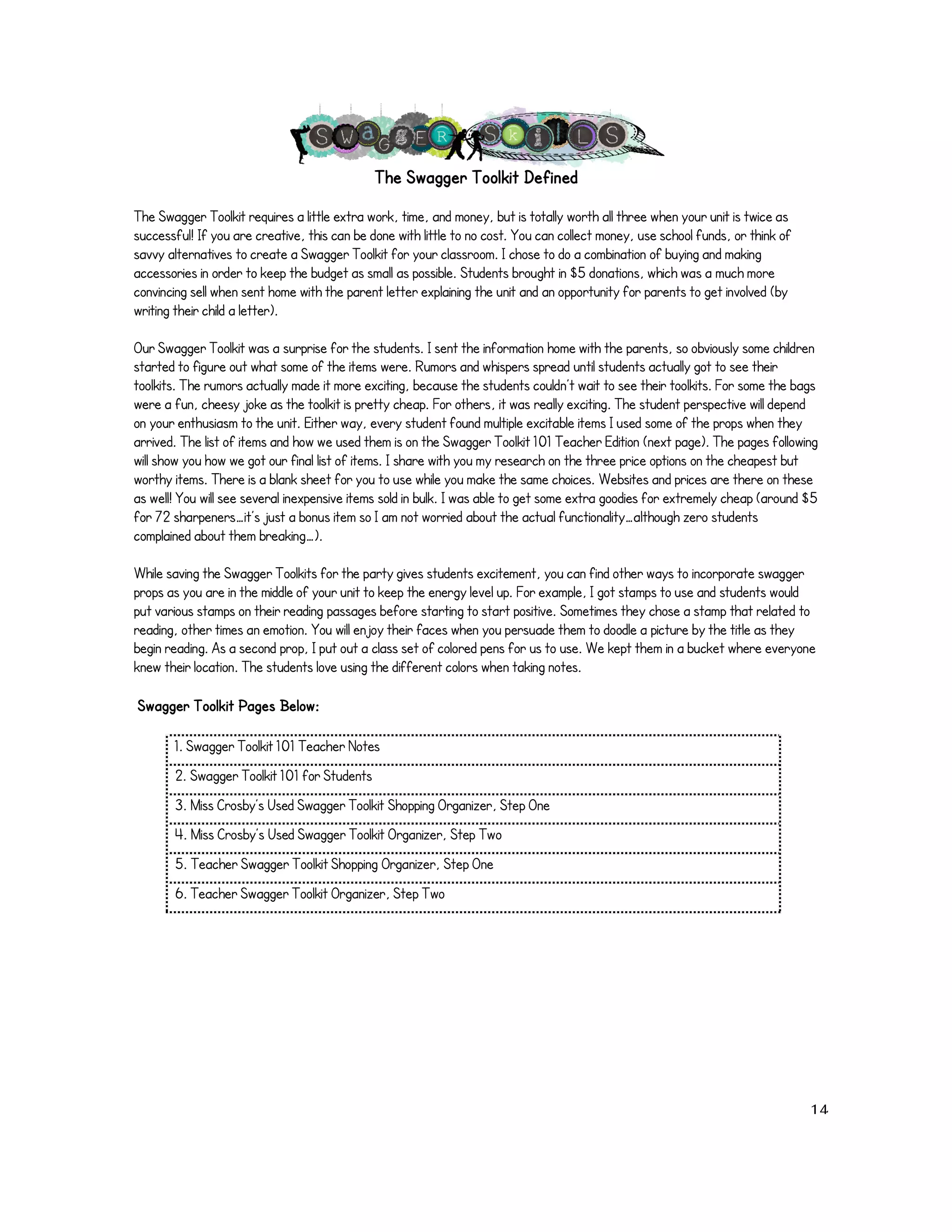
![Swagger Toolkit 101 Teacher Notes
Toolkit Item In Class Use? Expectations Consequences
Smiley Stickers Saved for party Stickers go on paper only. [Teacher eye stare] No more
stickers.
Class Set of
Stamps
I bought a large set at Oriental
Trading to stay in room. Three
students at a time could get a stamp
for paper.
Stamps go on paper only. No exceptions. No more stamping.
Highlighters Saved for party (used class set
prior)
You get the color you get. Sorry, some are
yellow. You’re welcome. Keep yo’ highlighters!
(Don’t leave them!)
I get more. !
Post-it Notes Saved for party (These were more
damage than helpful with our
purpose. Have fun showing and
drawing different doodled thought-clouds.)
You get the color you get. Keep yo’ post it
notes! (Don’t leave them!)
I get more. !
Neon Slap
Bracelet
Saved for party Use quietly so it maintains purpose. Wear on
wrist unless using for purpose. Outside of
class, it stays on wrist or goes in locker. You
can play swords at home.
No chances – if another teacher
complains once, you must keep it
at home.
Mints Saved for party (A fellow teacher
donated a pack for class use prior.)
During testing, you must unwrap prior and set
on your desk.
The rest of us are going to cringe
at your not quiet unwrapping, and
tomorrow we will eat your share
of mints.
Gum Saved for party (I bought extra with
my own money and used as an
incentive once a week for all things
swagger related. For example, I
would randomly give a piece of gum
or mint to students who got 100% on
a swagger quiz, did homework, or
helped a classmate find text based
evidence.)
If you are given gum, you may chew in class.
Be “cool” about it… chew quietly, mouth
closed, and don’t brag. When you are
finished, put it in the trash. When you leave
the classroom, throw the gum away. It’s
pretty cool of your teacher to allow you to do
this, so say thanks and don’t abuse it.
Do not ask another teacher to chew gum.
Then he/she is mad at me because I put
him/her in a bad spot.
No chances- I am not handing out
gum to anyone I don’t trust if any
gum is found or a teacher
mentions students asking. If it was
an obnoxious chomp or bubble, spit
out for the day [insert teacher
eye stare].
Not fair if I don’t trust you? Earn
trust then. This is my job!
Colored Pens Saved for party (Order extra for
class set to use in advance. Keep a
close eye on them!)
Choose a color on the first day. Use this color
every day (using the same color is the
purpose). Yes, you can choose black or blue
if you hate color. Stick to your pen color.
The rest of us don’t have our pen
if you take it, so we are going to
be upset.
Mustache
Tattoo
Saved for party Take turns to use restroom and put them on
at school before an assessment. We waited a
couple days for this. Put it on or put it away.
Mustache
Eraser
Saved for party
BONUS
SURPSISES
Neon
Sunglasses
Saved for party Wear in class or at recess as often as you
like. Put in locker otherwise. Do not ask
another teacher if you can wear them. Wear
them on head if I ask you to.
Keep at home.
Sharpeners Saved for party
Sticky Hands Saved for party Take home after party. It’s mine.
Smile Magnets Saved for party
! 15!](https://image.slidesharecdn.com/swaggerassessmentskills-141113213247-conversion-gate02/75/Swagger-Assessment-Skills-Instructions-15-2048.jpg)
![Swagger Toolkit 101 for Students
Toolkit Item In Class Use? Expectations Consequences
Smiley Stickers Yes! Stickers go on paper only. [Teacher eye stare] No more stickers.
Class Set of
Stamps
Three students at
a time can get a
stamp for paper.
Stamps go on paper only. No exceptions. No more stamping.
Highlighters Yes! You get the color you get. Sorry, some are
yellow. You’re welcome. Keep yo’ highlighters!
(Don’t leave them!)
I get more. !
Post-it Notes Yes! You get the color you get. Keep yo’ post it
notes! (Don’t leave them!)
I get more. !
Neon Slap
Bracelet
Yes, with a
purpose to help
you focus!
Use quietly so it maintains purpose. Wear on
wrist unless using for purpose. Outside of class,
it stays on wrist or goes in locker. You can play
swords at home.
No chances – if another teacher complains
once, you must keep it at home.
Mints Yes, with a
purpose to help
you focus!
During testing, you must unwrap prior and set on
your desk.
The rest of us are going to cringe at your not
quiet unwrapping, and tomorrow we will eat
your share.
Gum Yes, with a
purpose to help
you focus!
-If you are given gum, you may chew in class.
-Be “cool” about it… chew quietly, mouth closed,
and don’t brag.
-When you are finished, put it in the trash.
-When you leave the classroom, throw the gum
away.
-Do not ask another teacher to chew gum.
Then he/she is mad at me because I put him/her
in a bad spot.
*It’s pretty cool of your teacher to allow you to
do this, so say thanks and don’t abuse it.
No chances- I am not handing out gum to
anyone I don’t trust if any gum is found or a
teacher mentions students asking.
If it was an obnoxious chomp or bubble, spit
out for the day [insert teacher eye stare].
Not fair? Earn my trust then. !
Colored Pens Yes! Choose a color on the first day. Use this color
every day (using the same color is the purpose).
Yes, you can choose black or blue if you hate
color.
The rest of us don’t have our pen if you take
it, so we are going to be upset.
Mustache
Tattoo
Wait for
Permission
Put it on or put it away.
Mustache
Eraser
Yes!
BONUS
Neon
Sunglasses
Yes! (as long as
you are still
focused)
Wear in class or at recess as often as you like.
Put in locker otherwise. Wear them on head if I
ask you to.
Keep at home.
Sharpeners Yes!
Sticky Hands No! Take home after party. It’s mine.
Smile Magnets No!
! 16!](https://image.slidesharecdn.com/swaggerassessmentskills-141113213247-conversion-gate02/75/Swagger-Assessment-Skills-Instructions-16-2048.jpg)

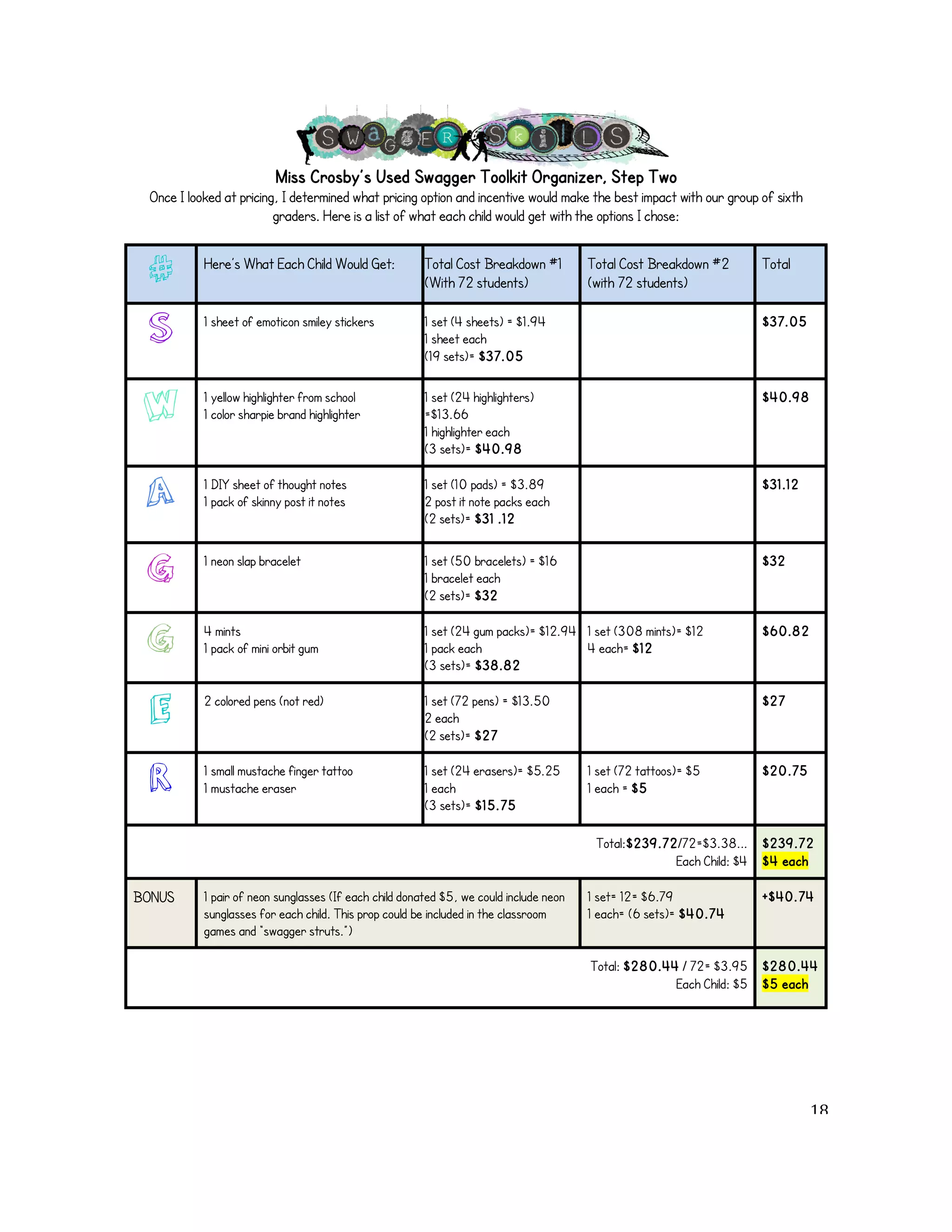
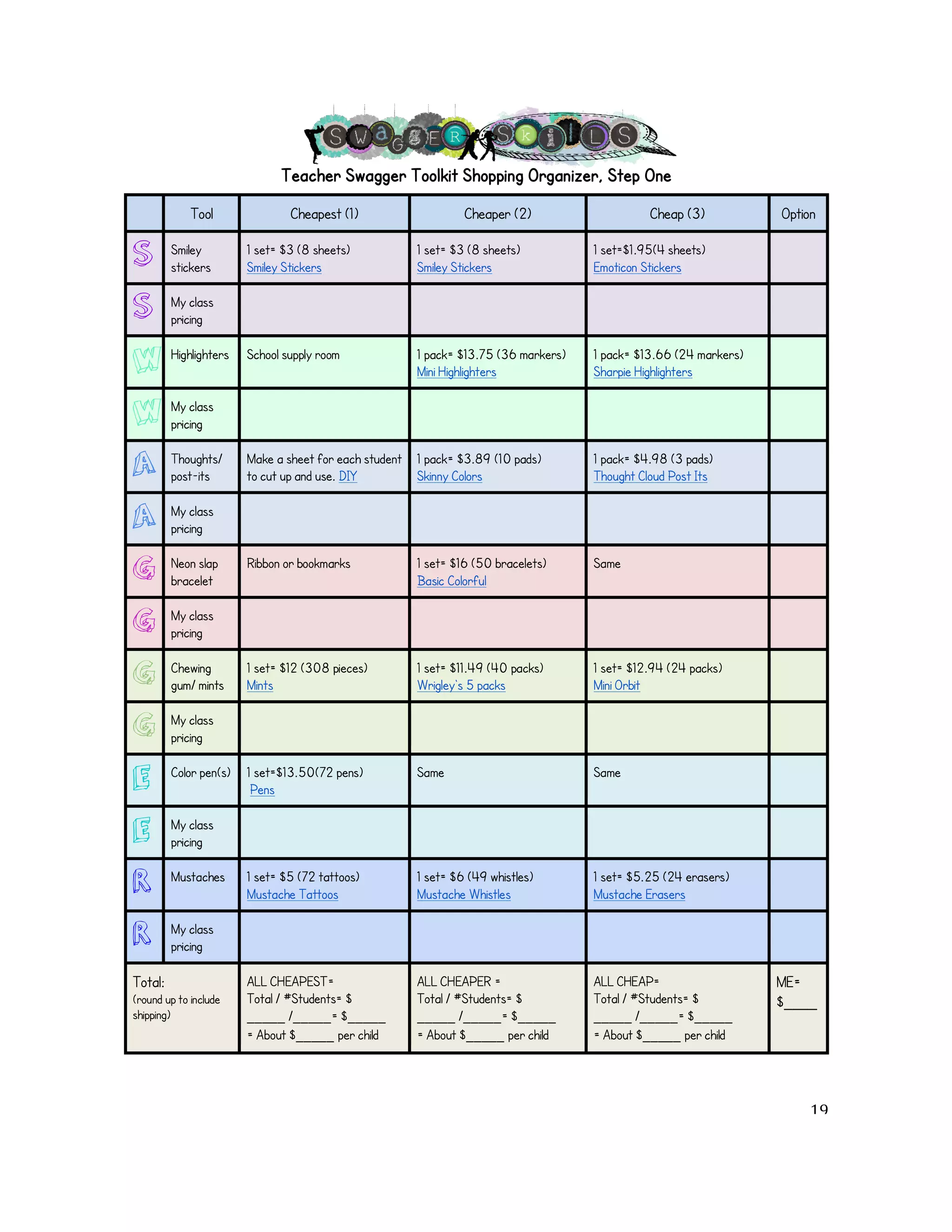
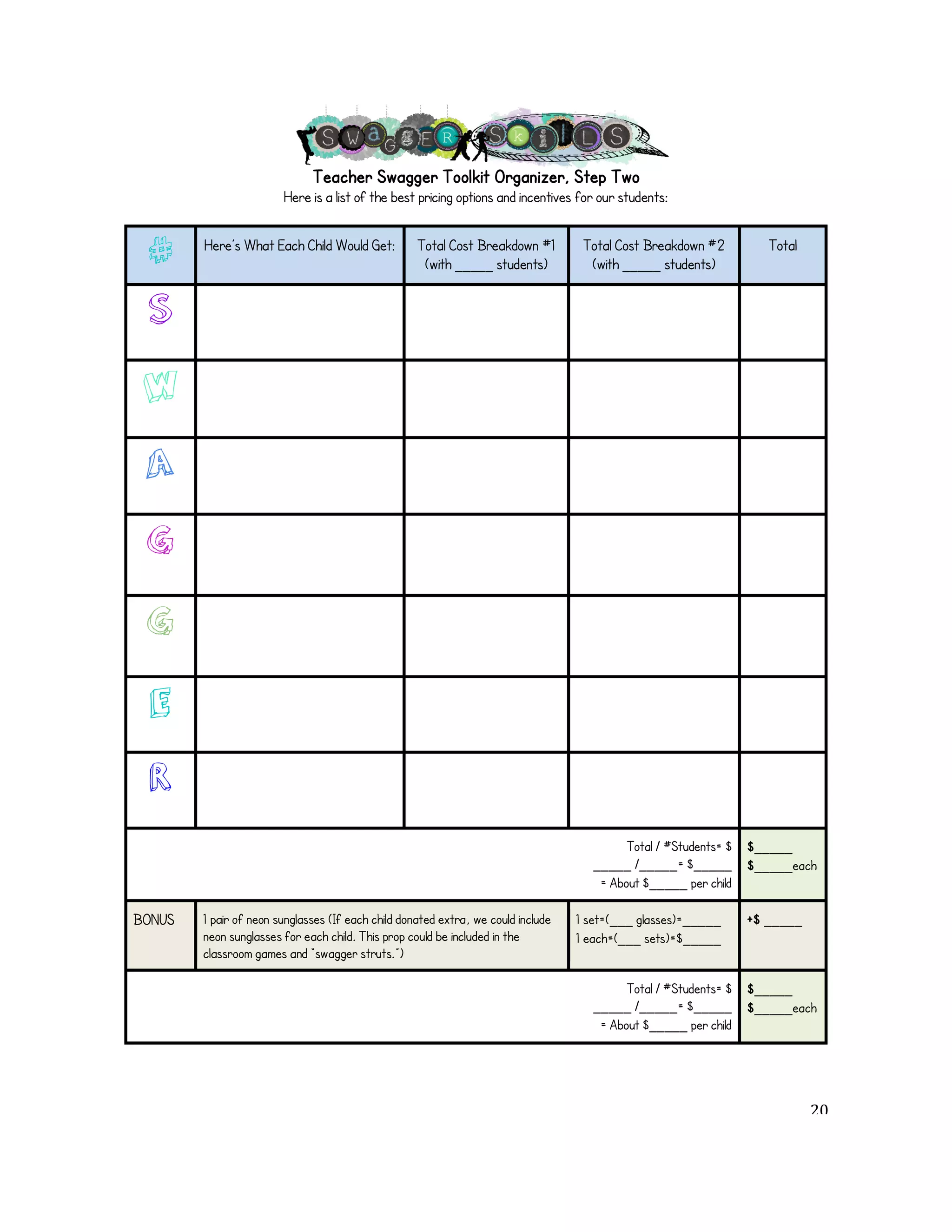
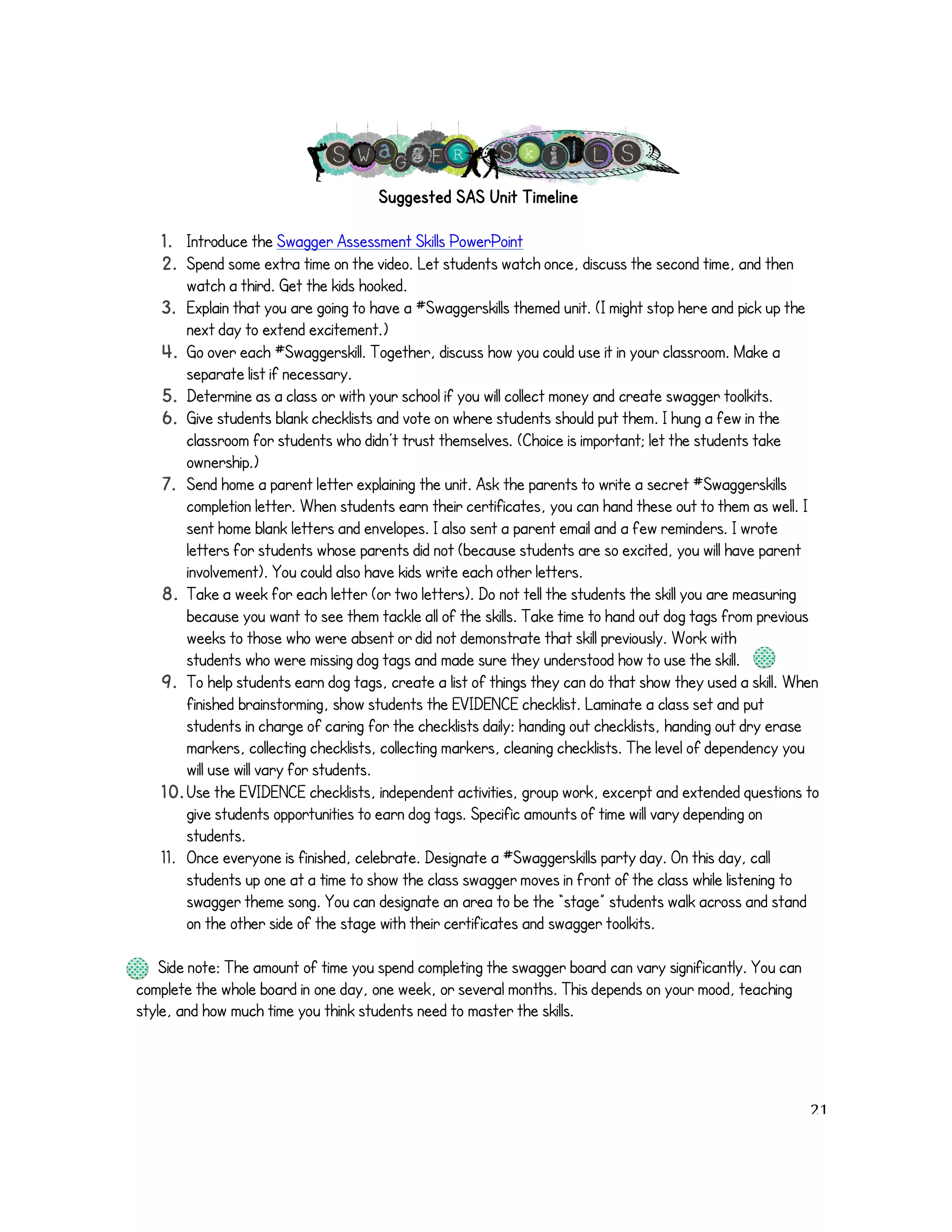

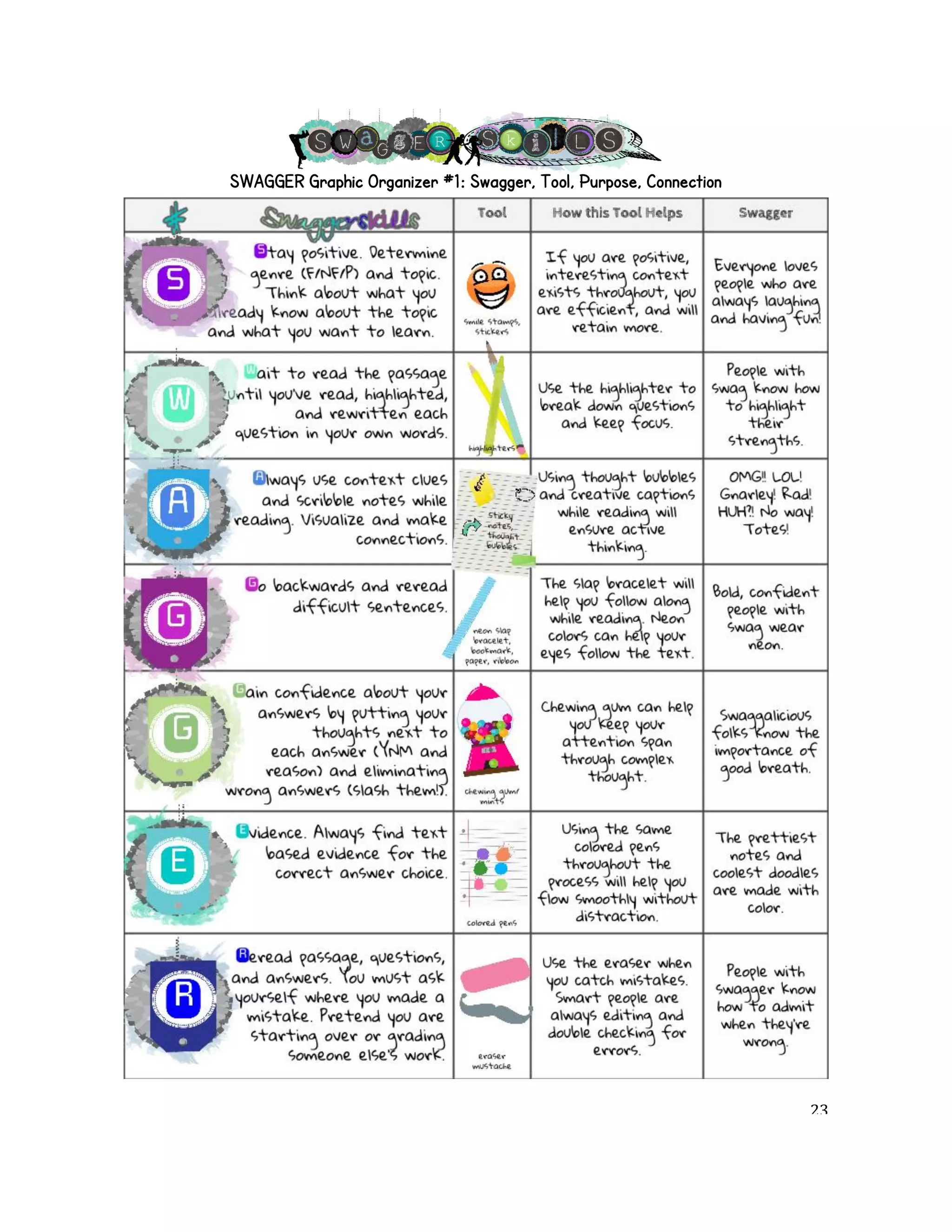
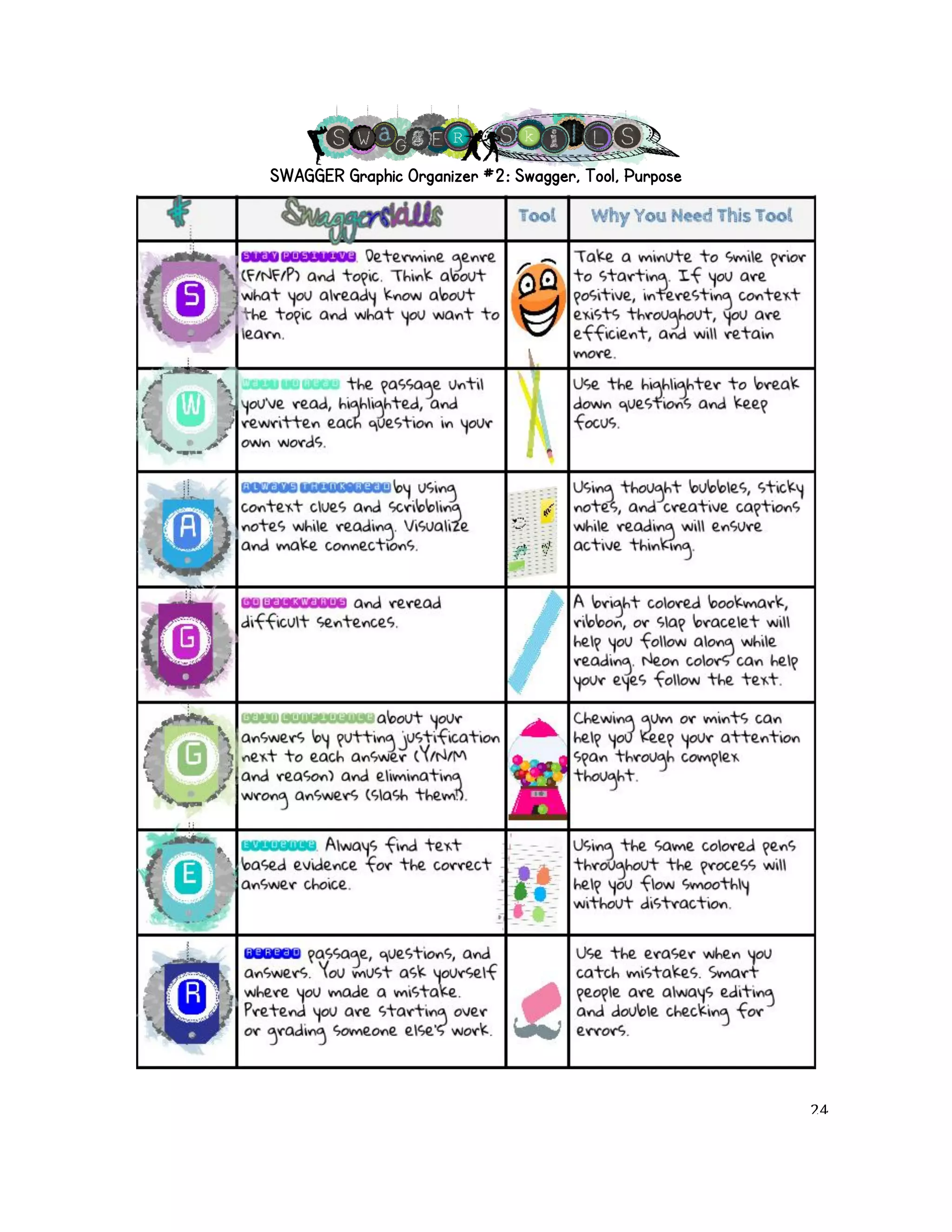
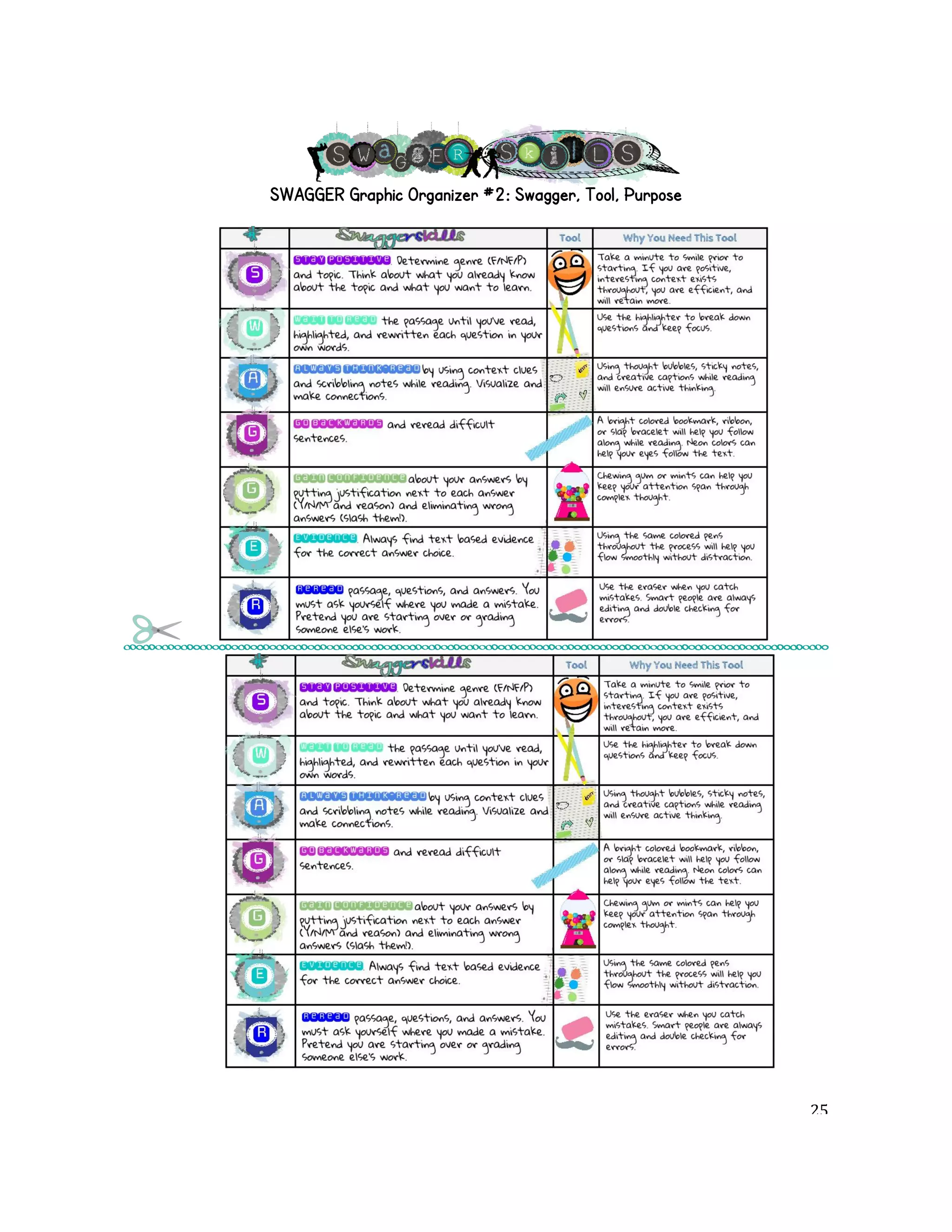
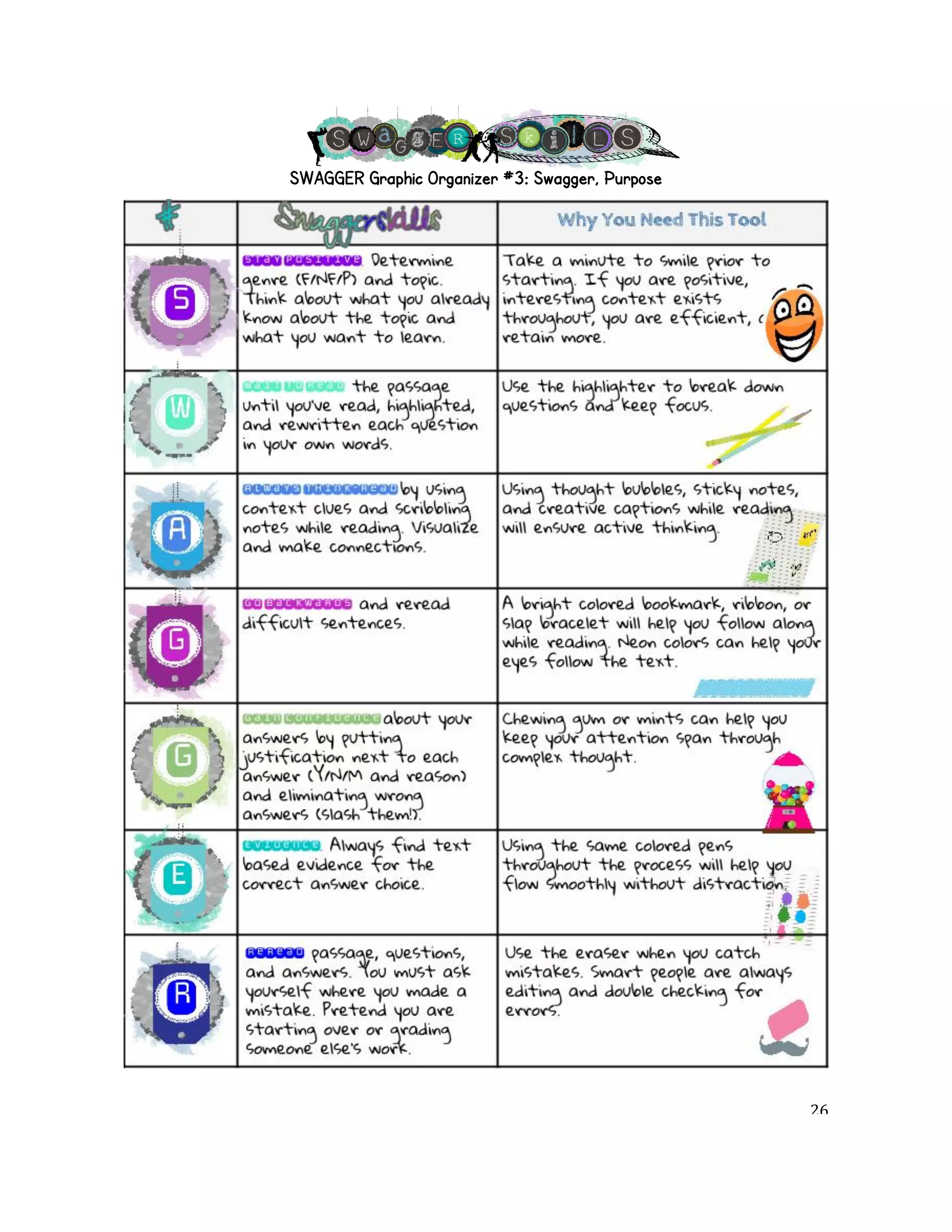
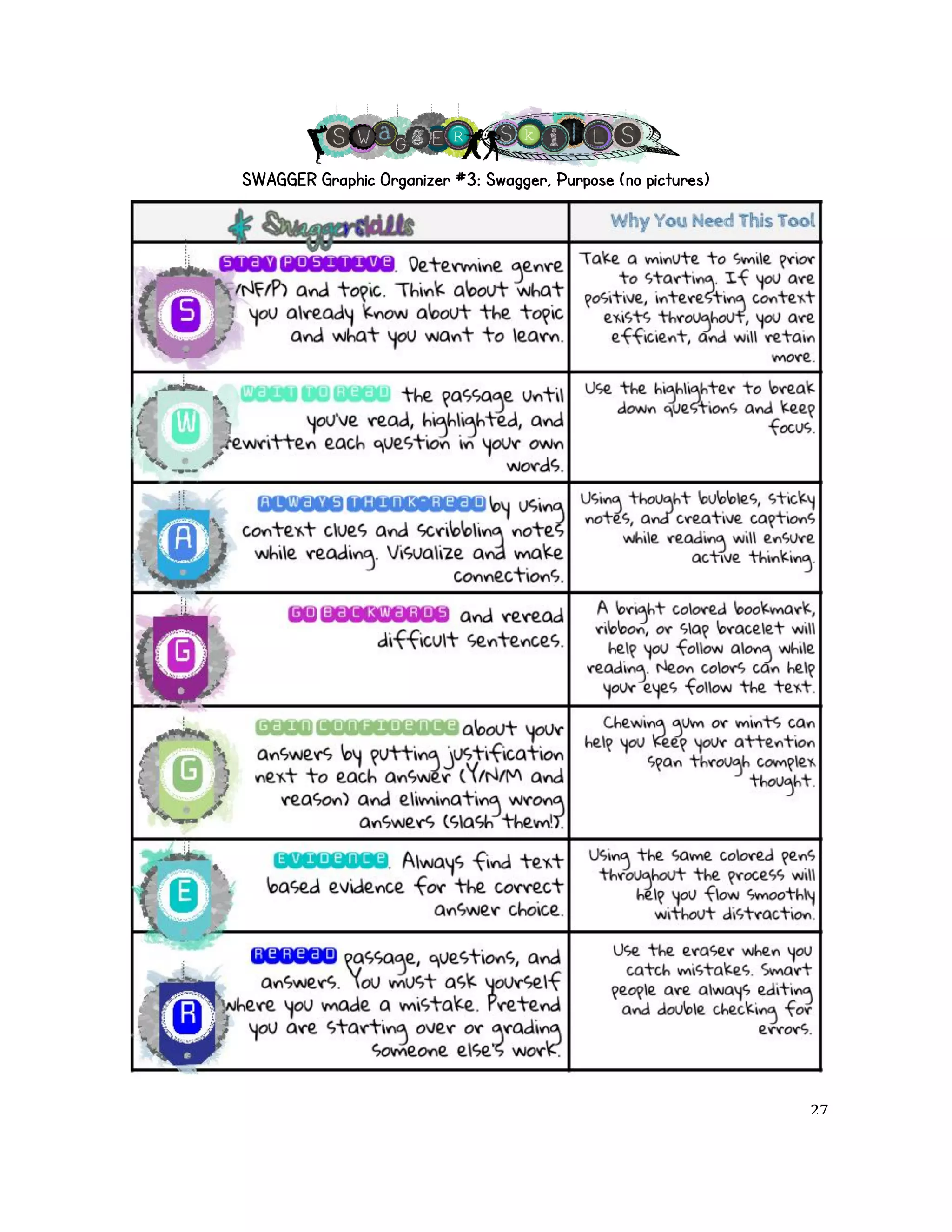
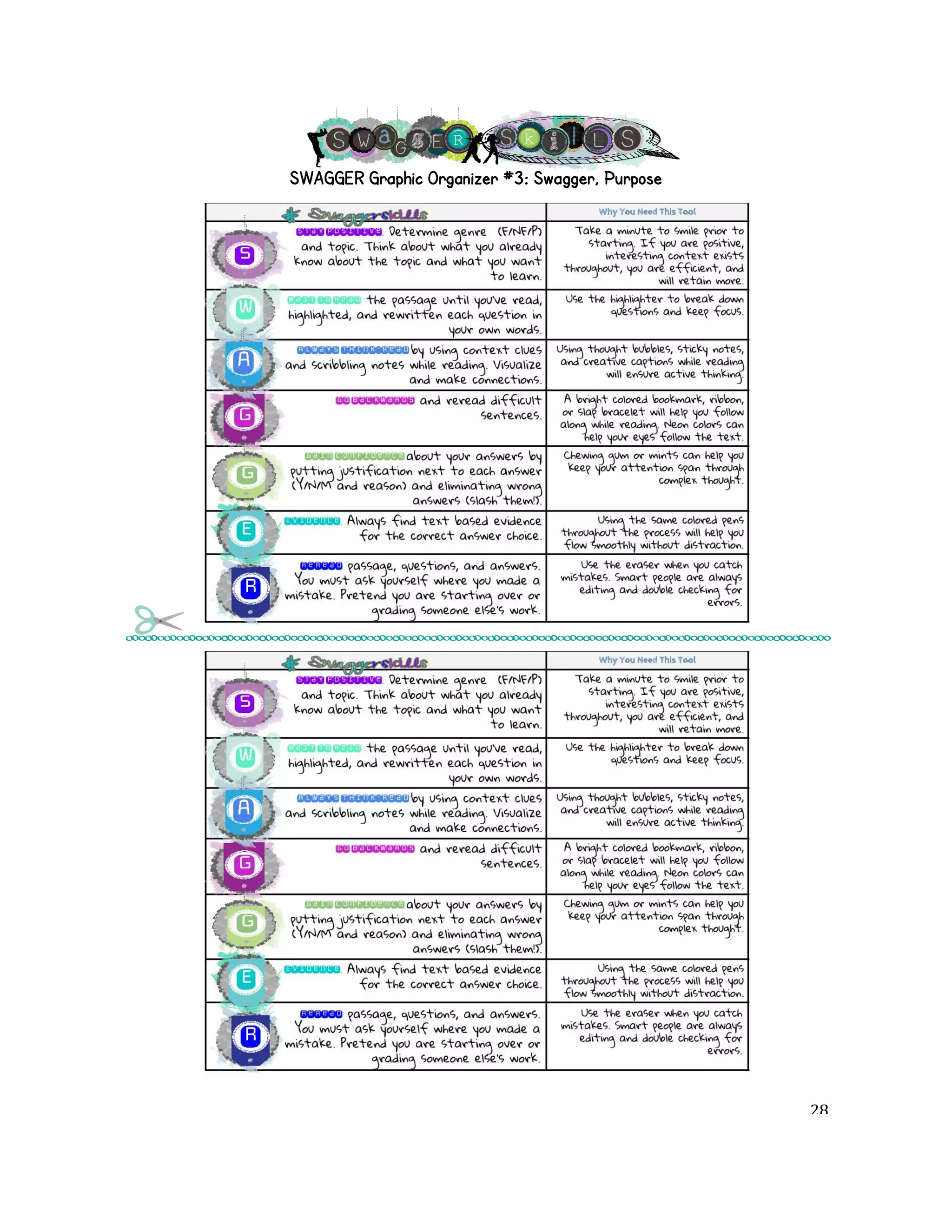
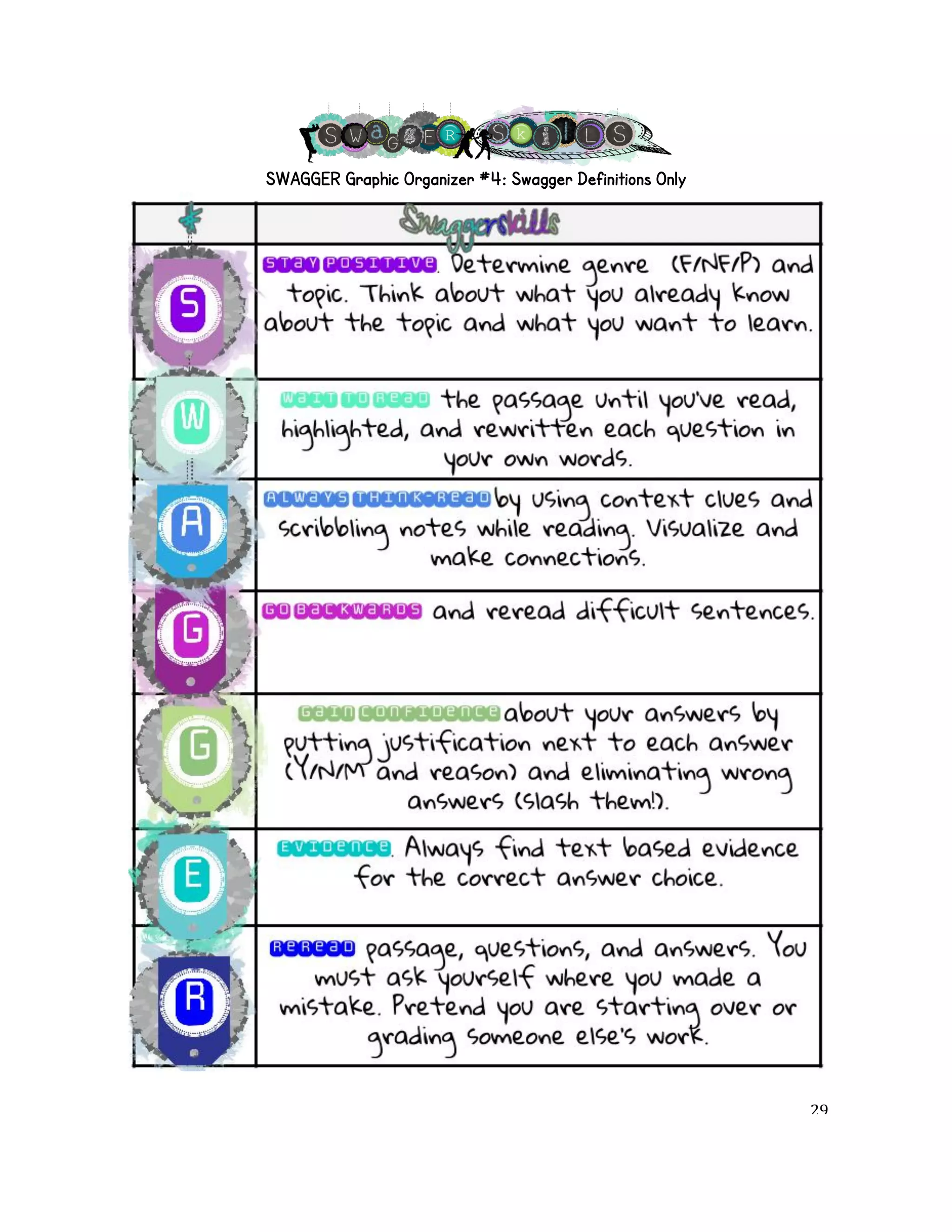
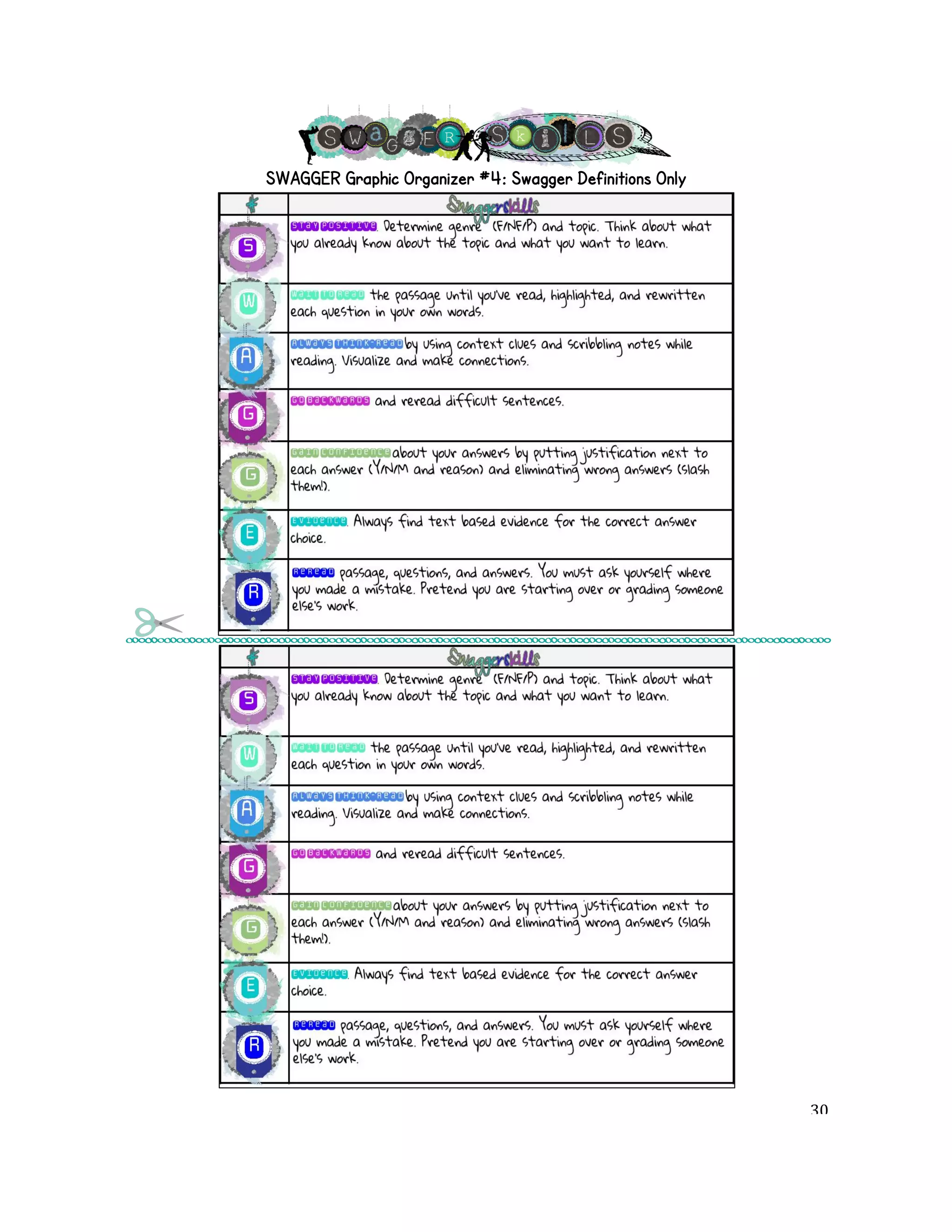



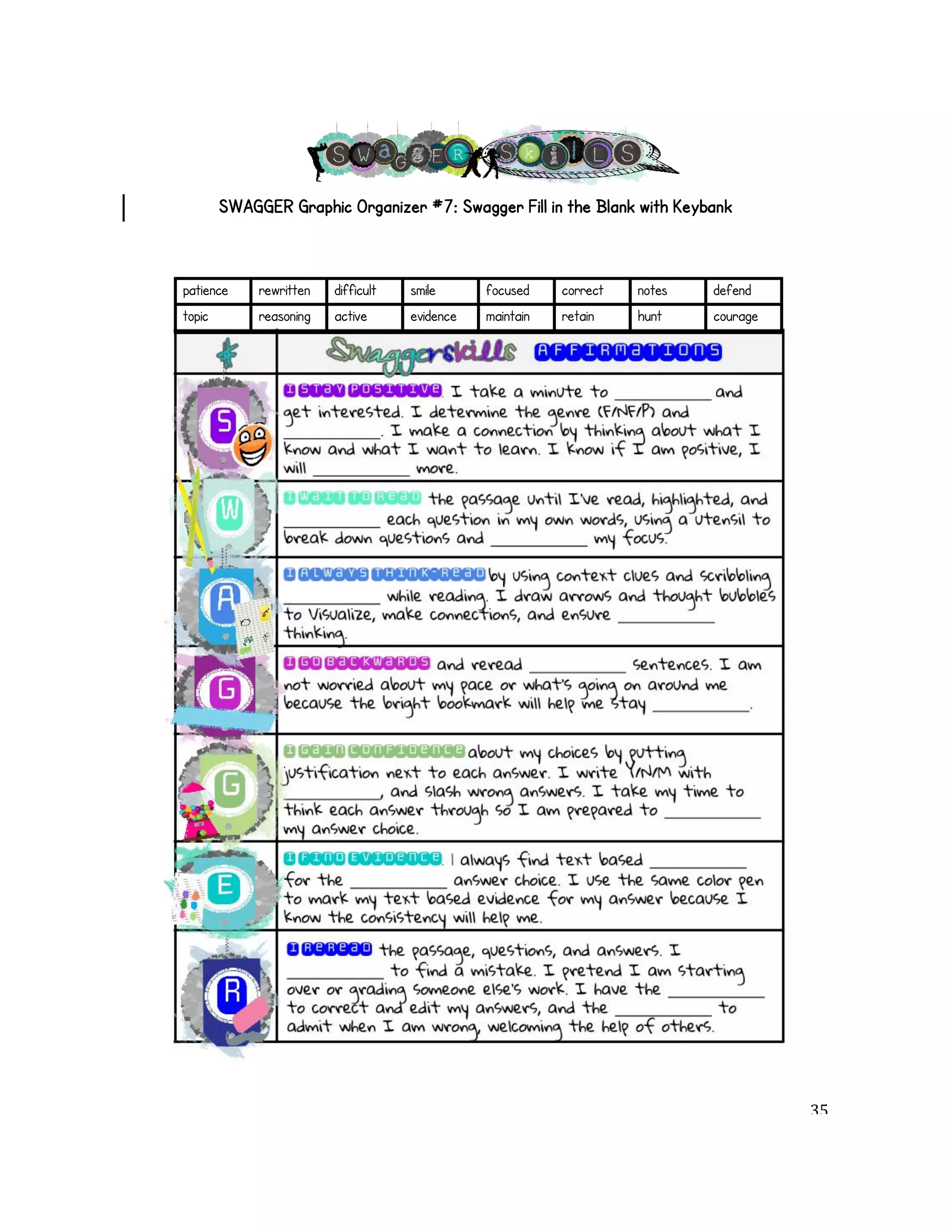

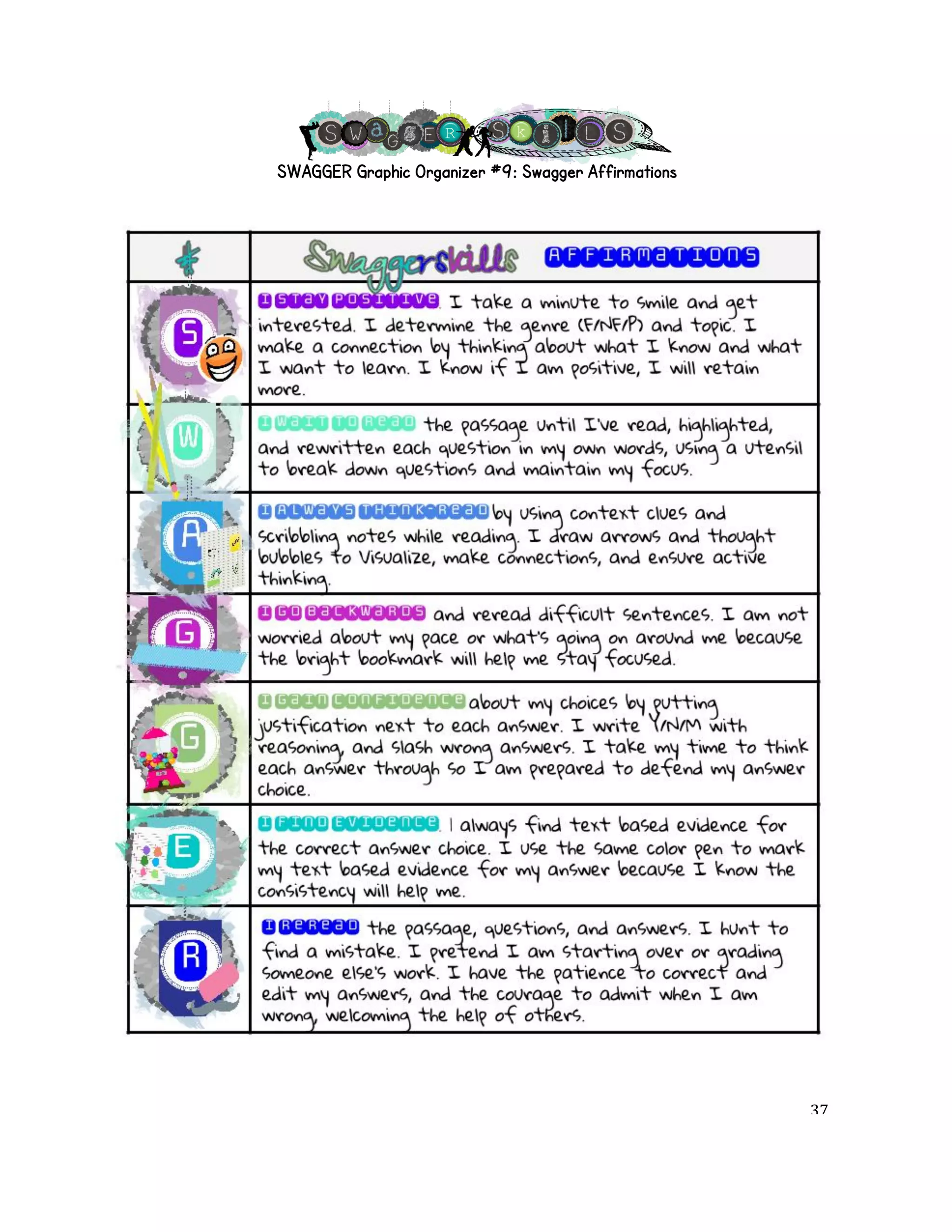
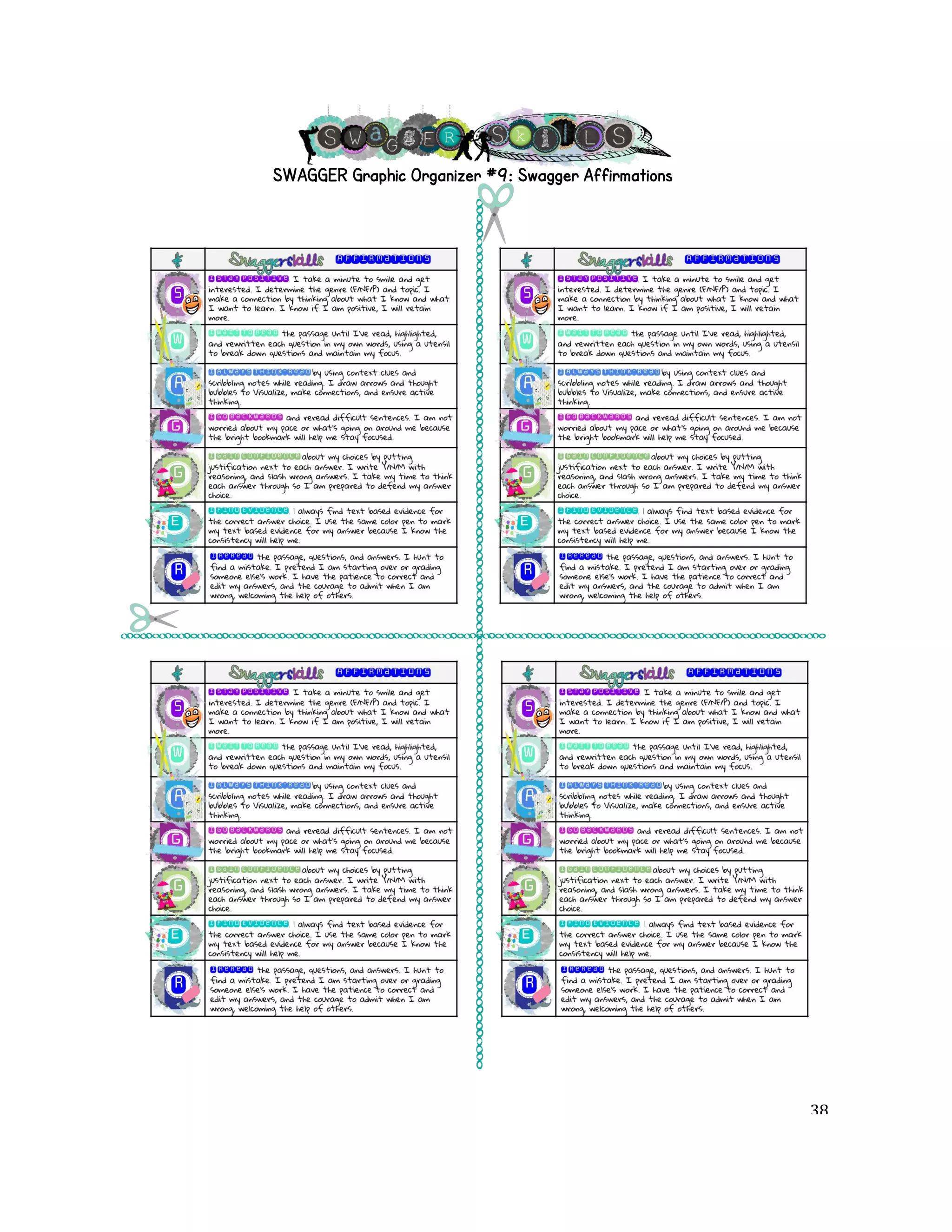
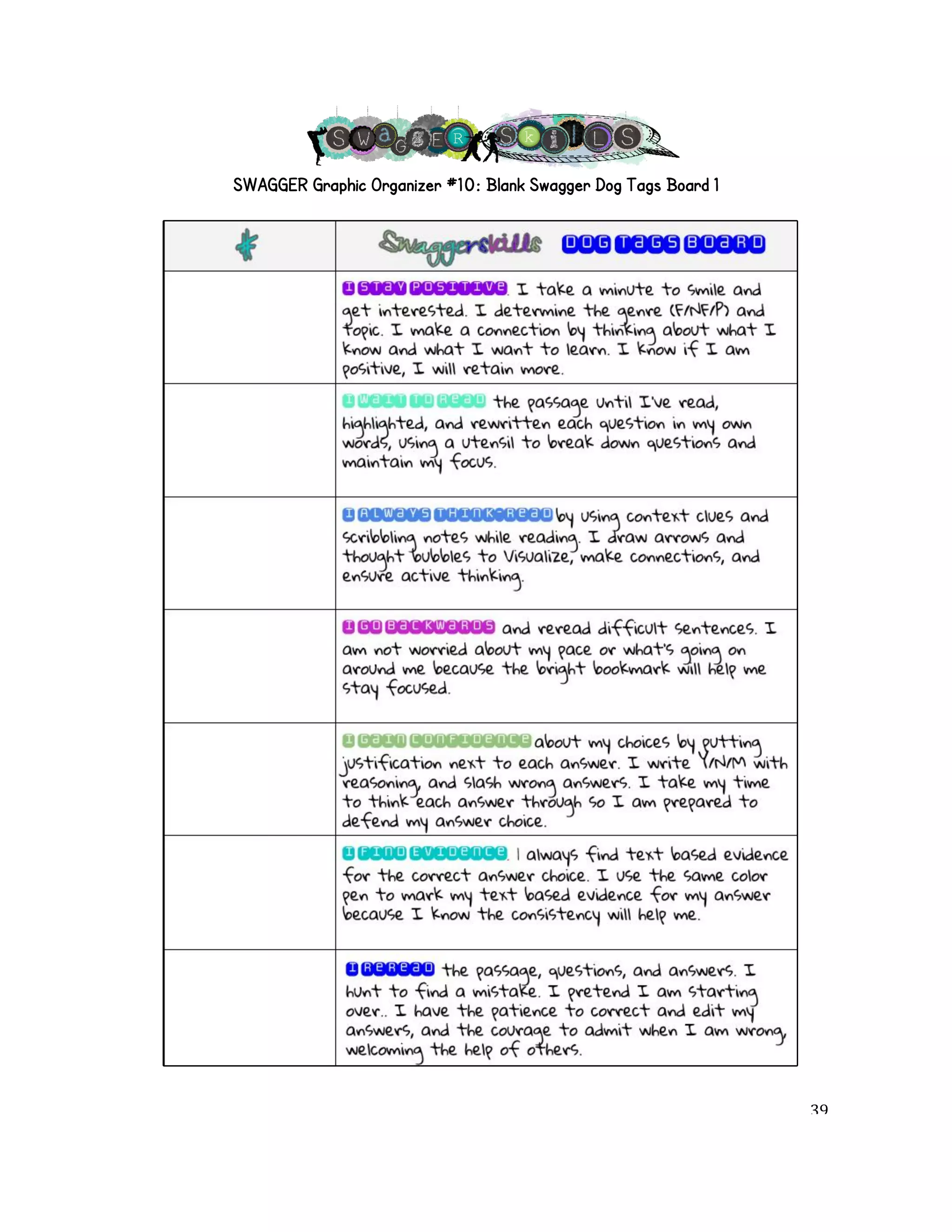
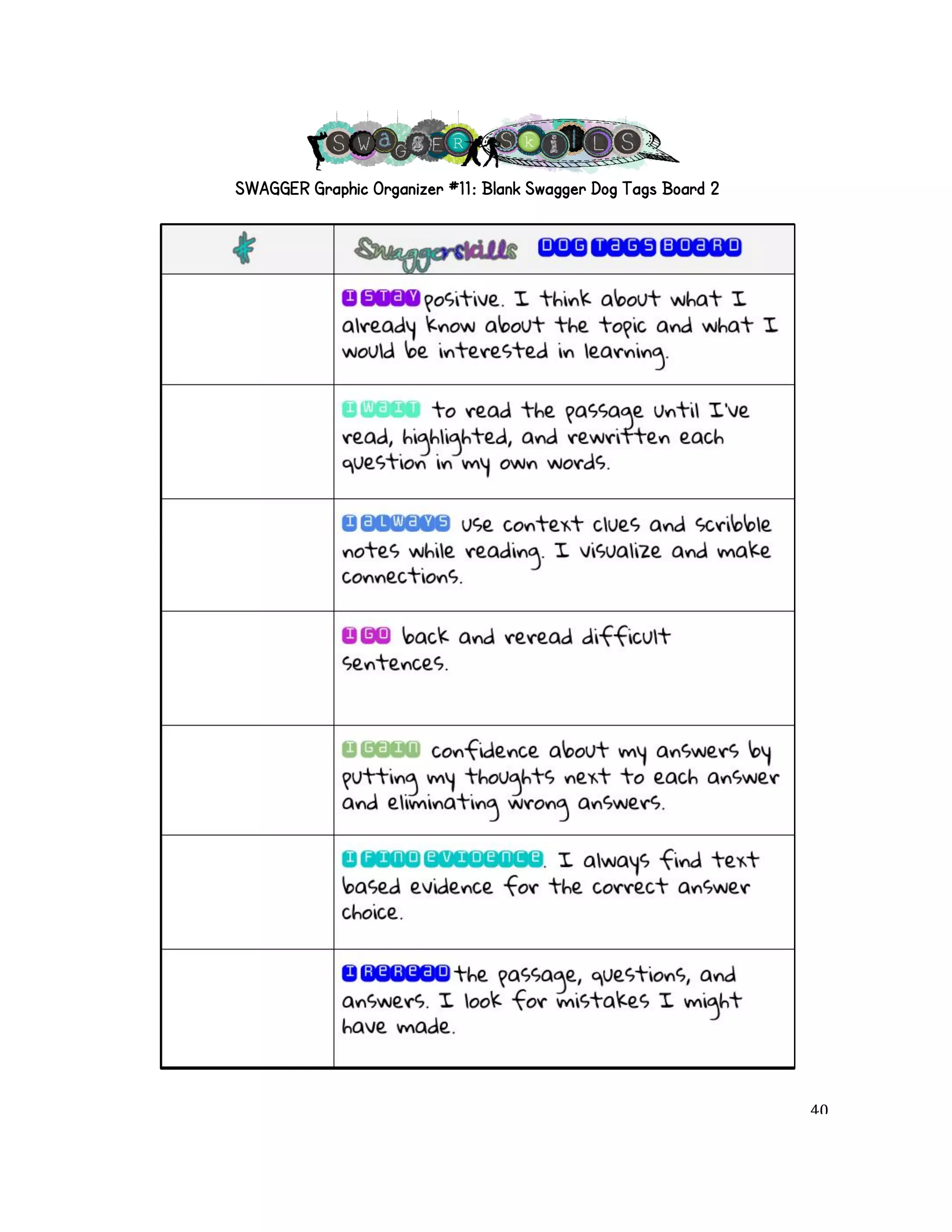
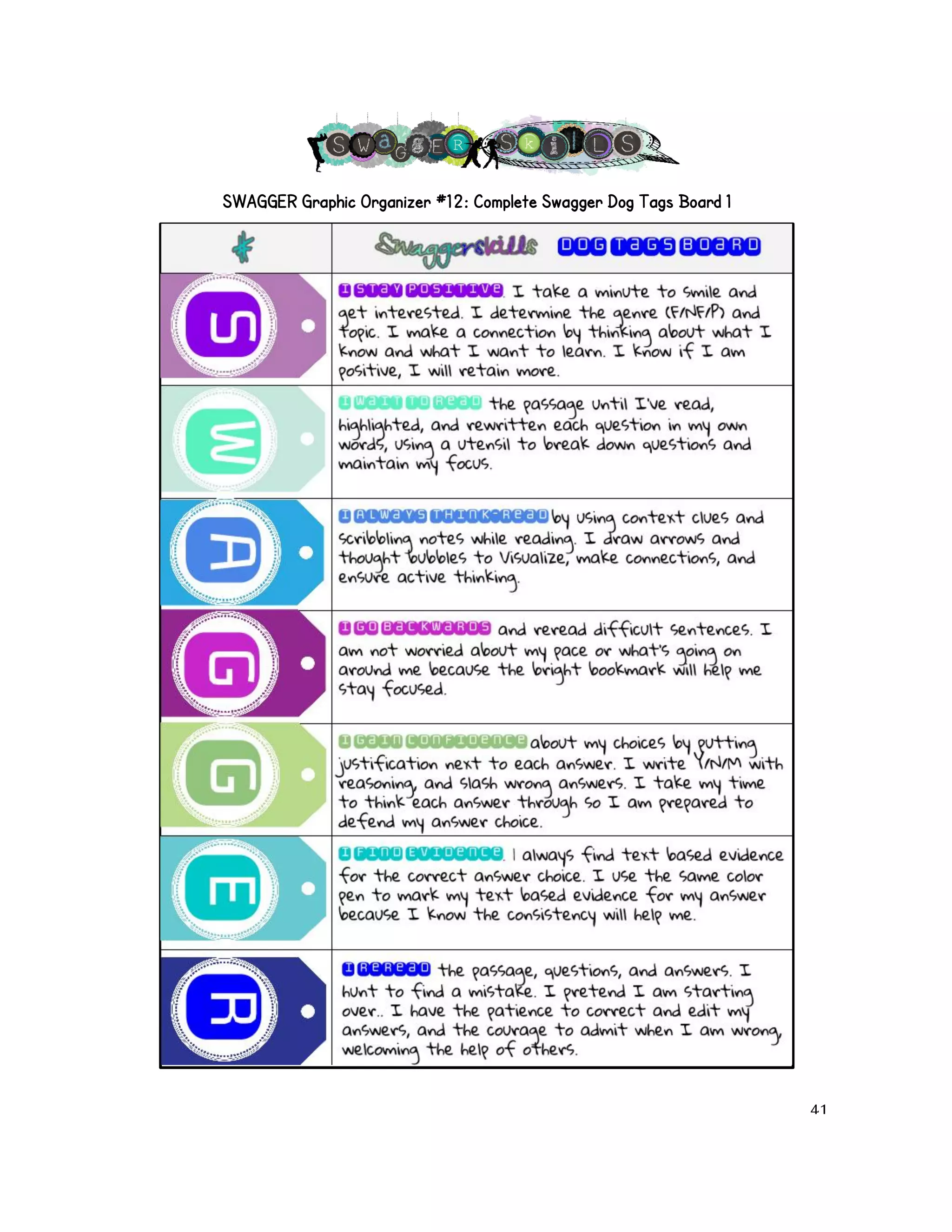
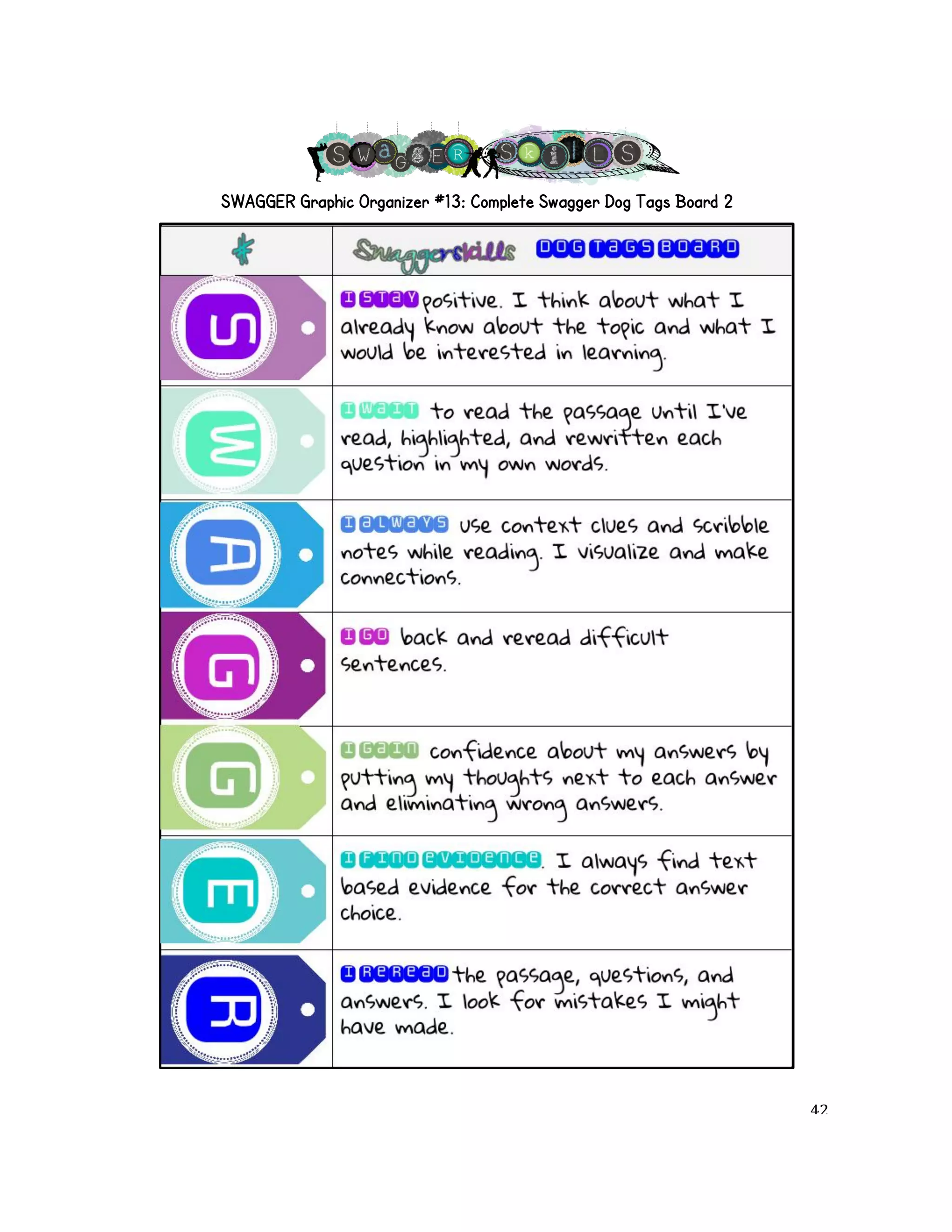
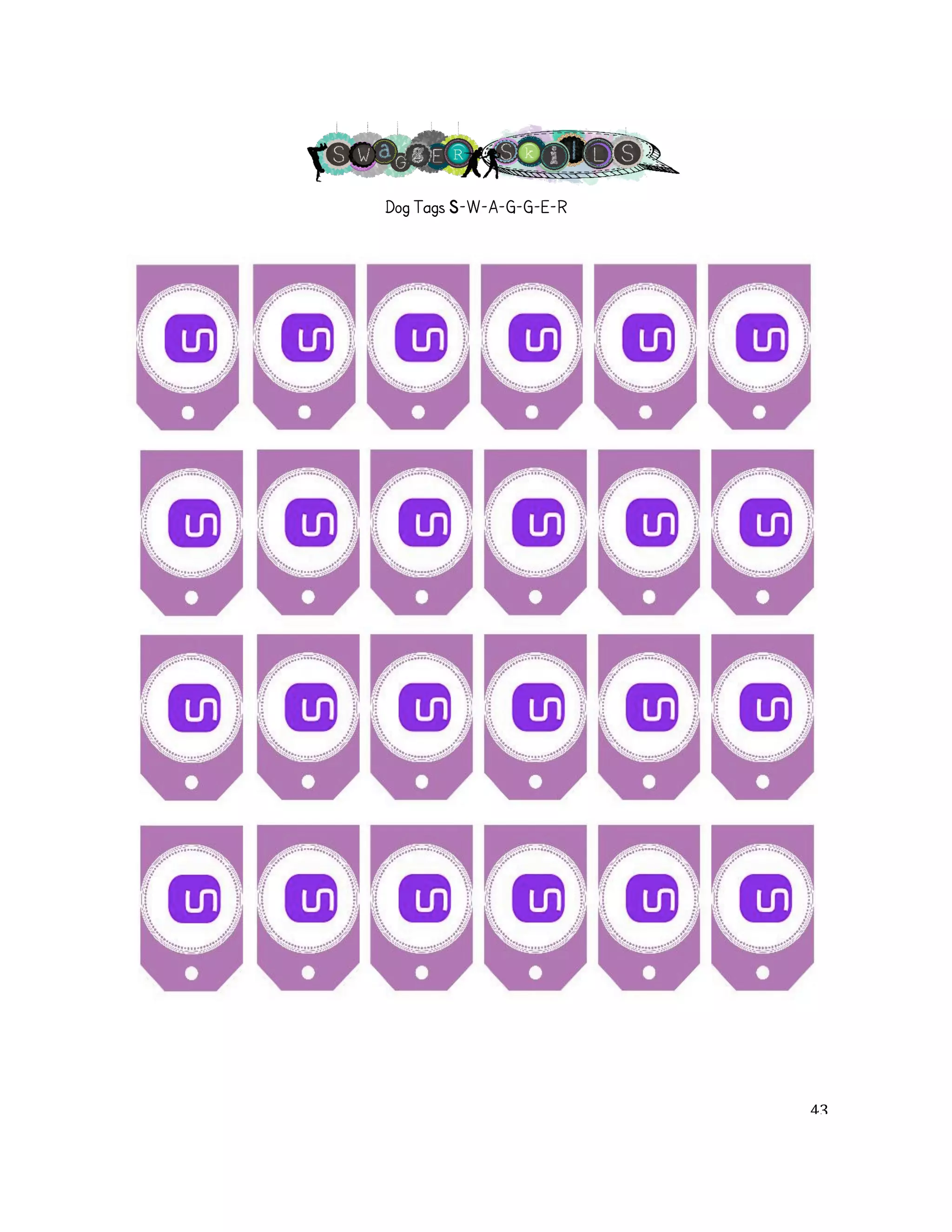


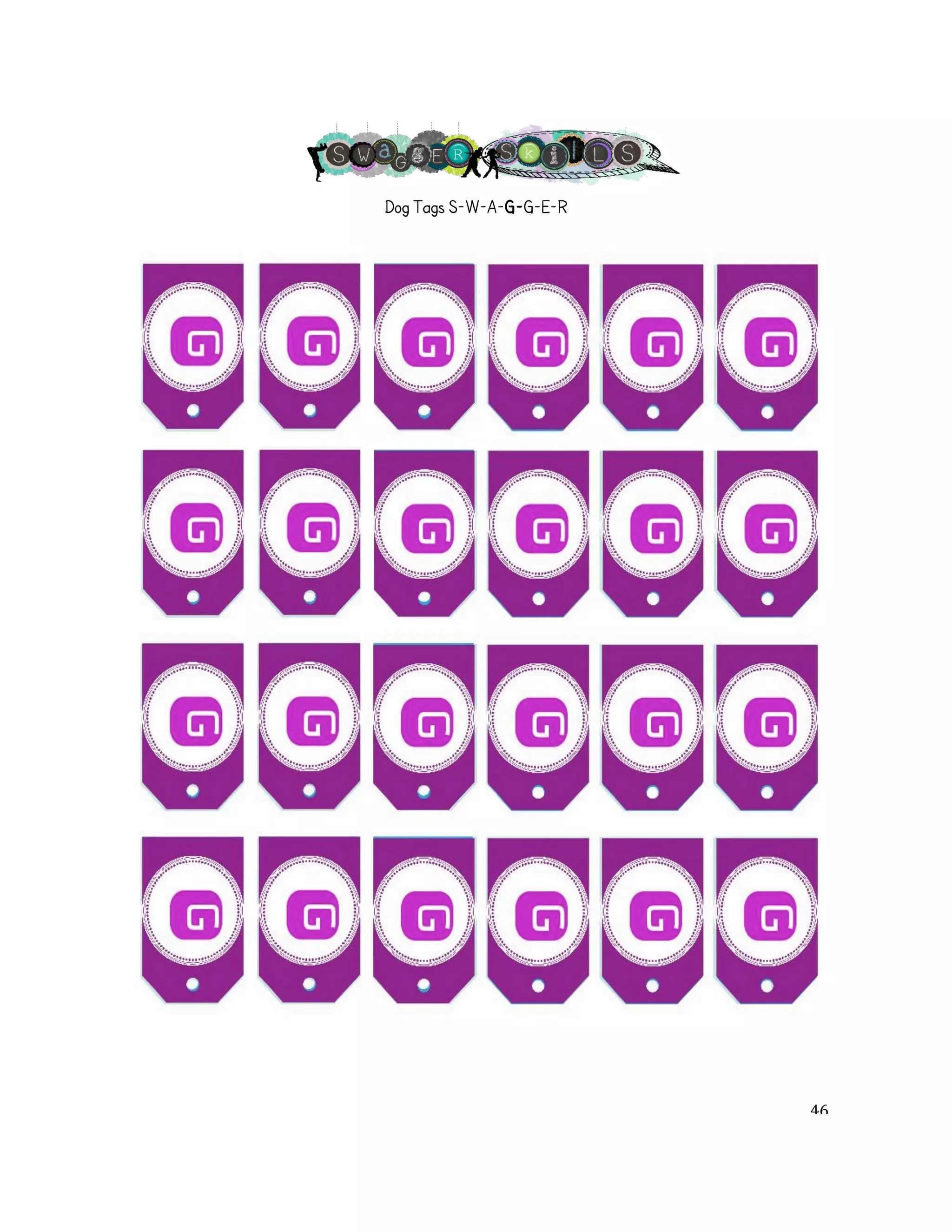


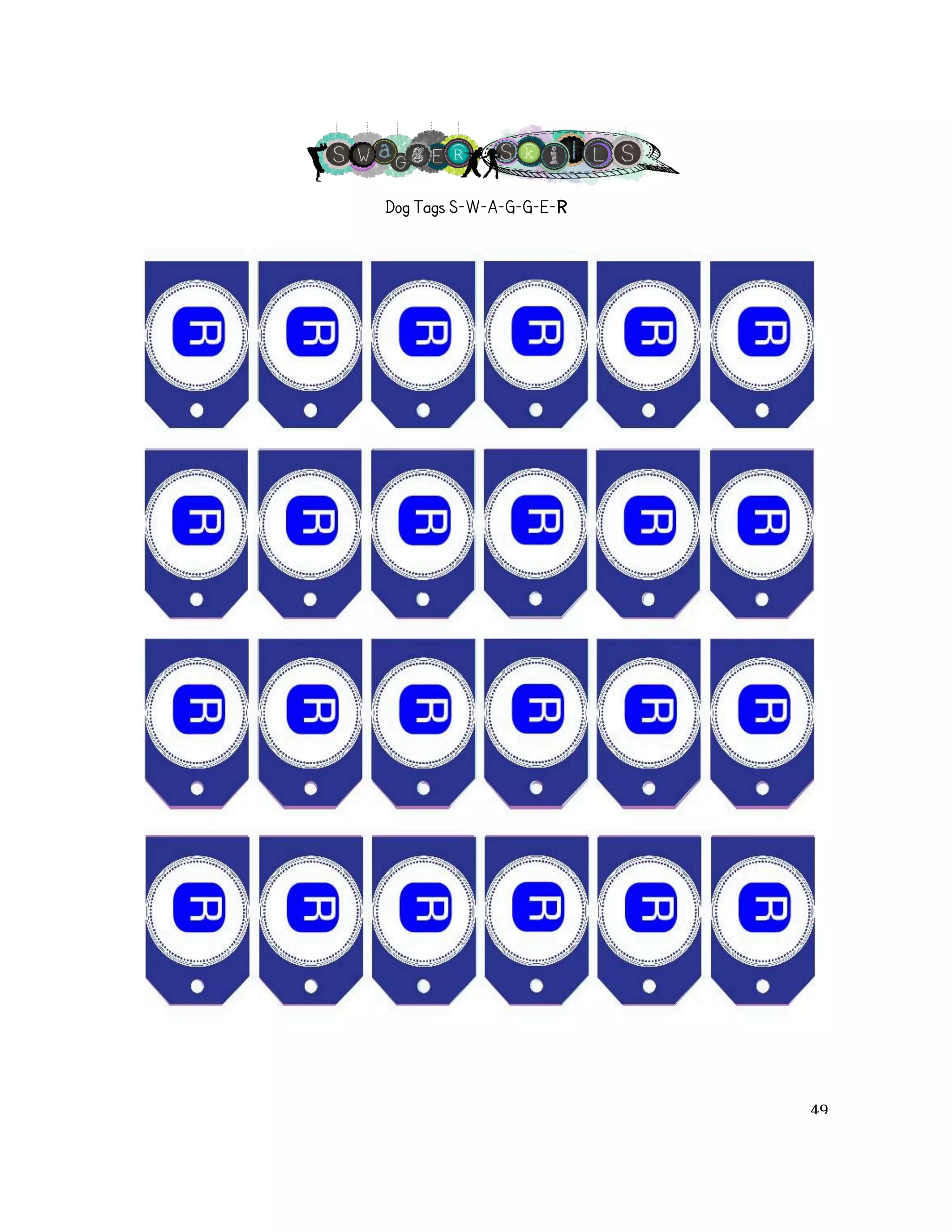
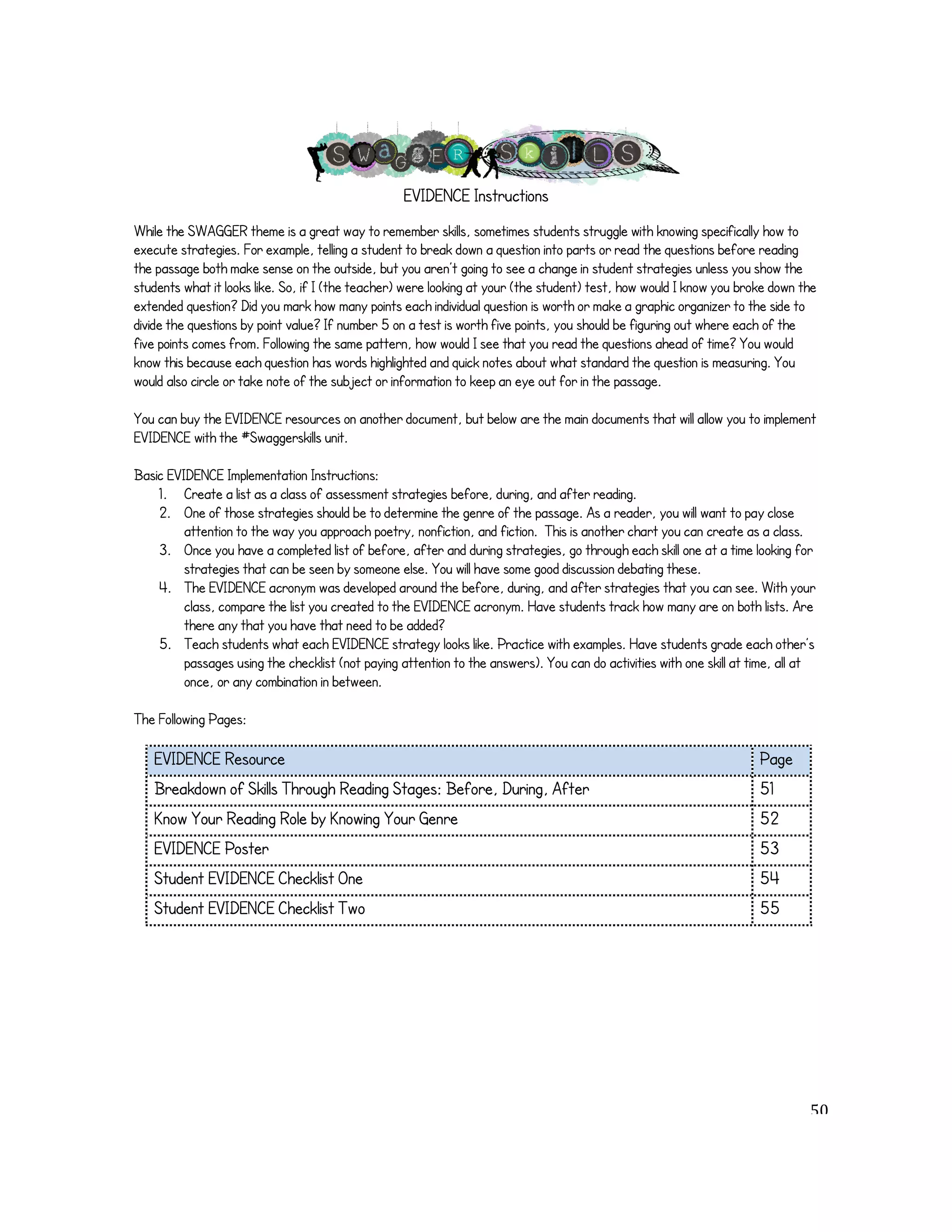
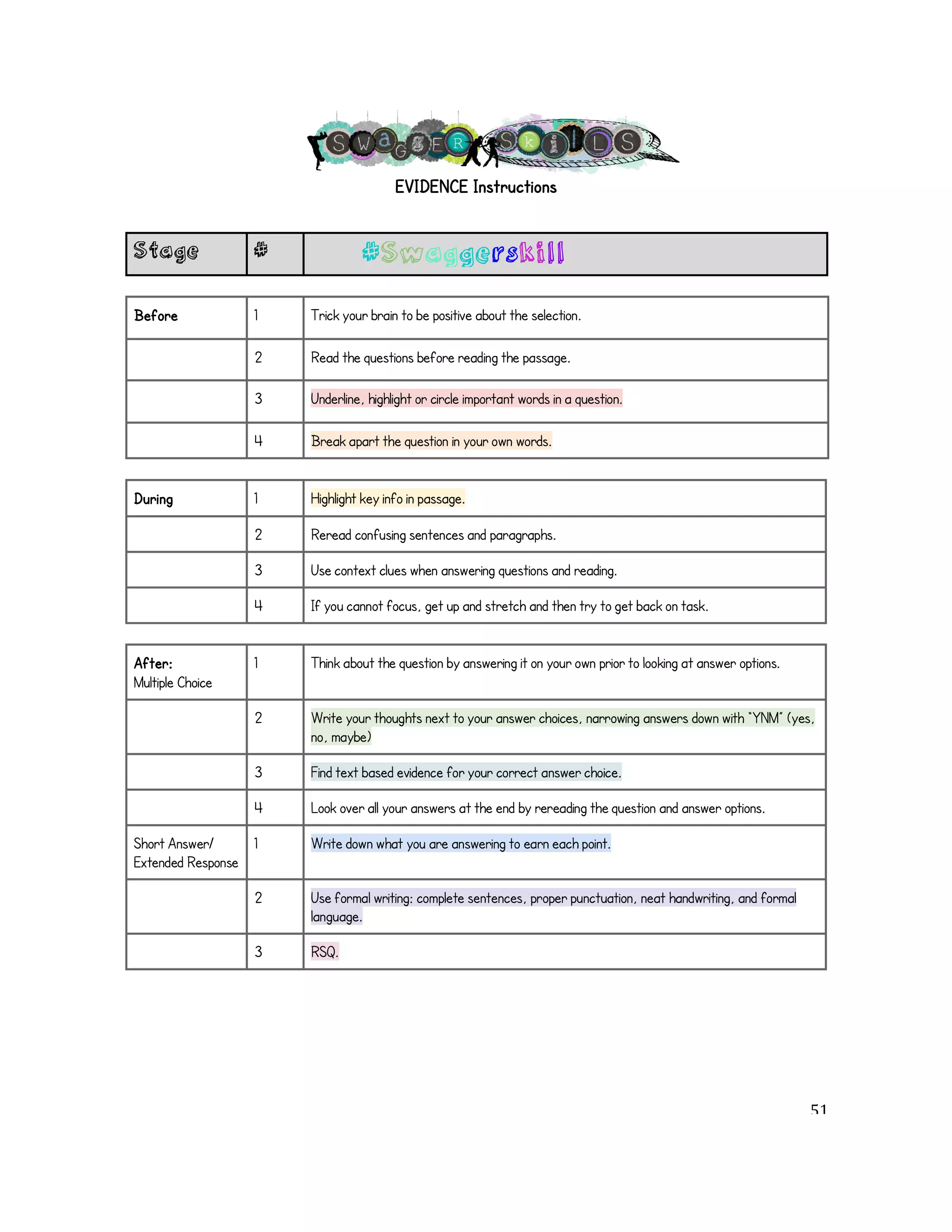
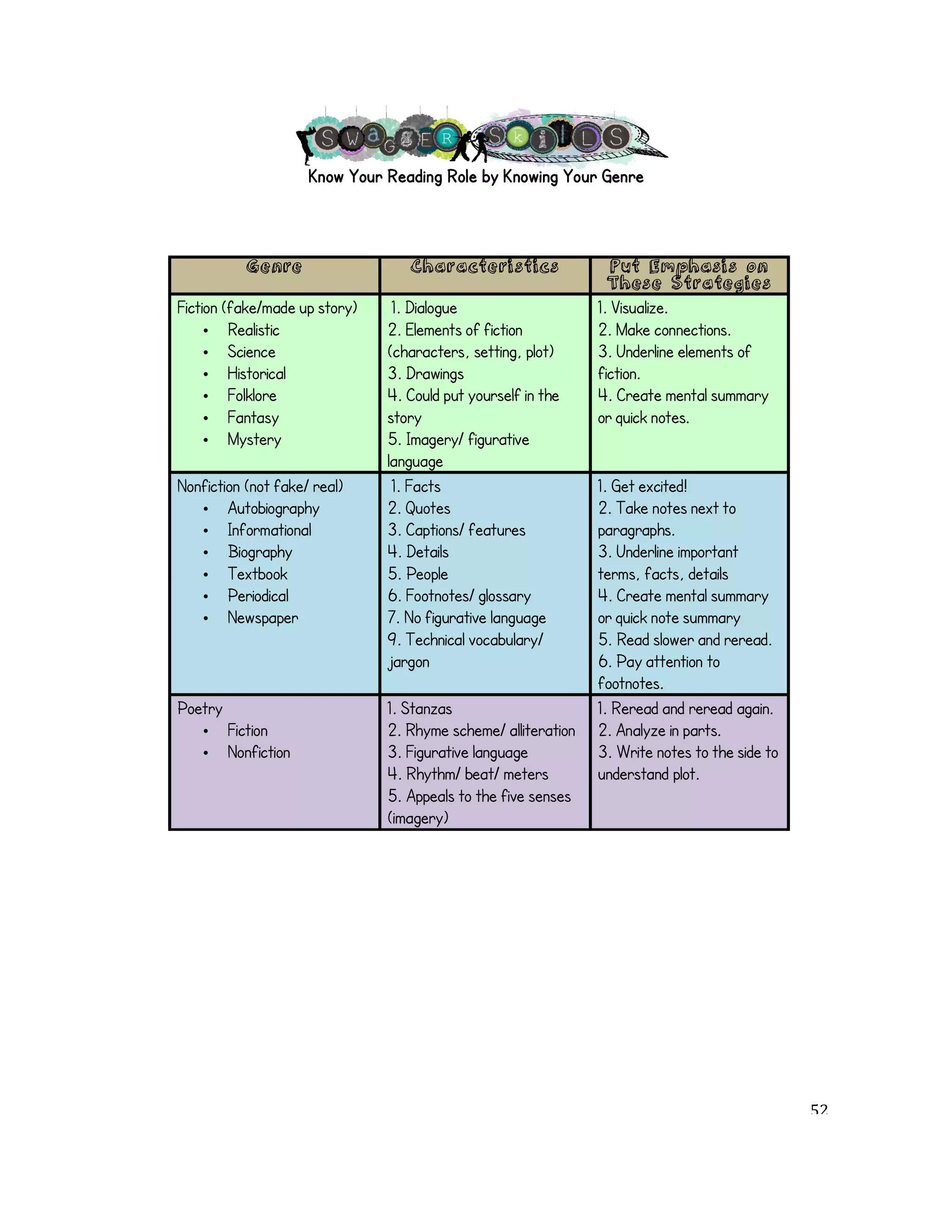



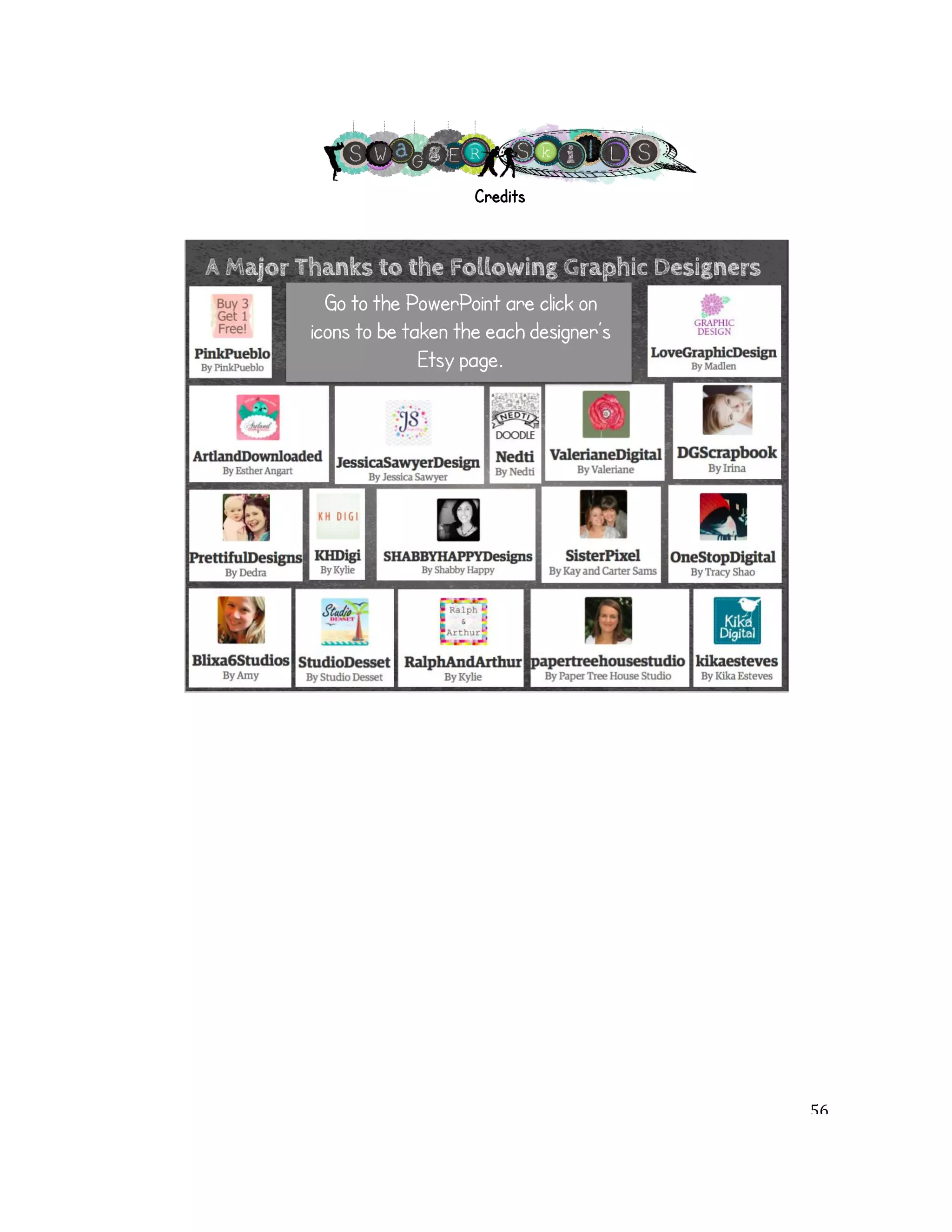




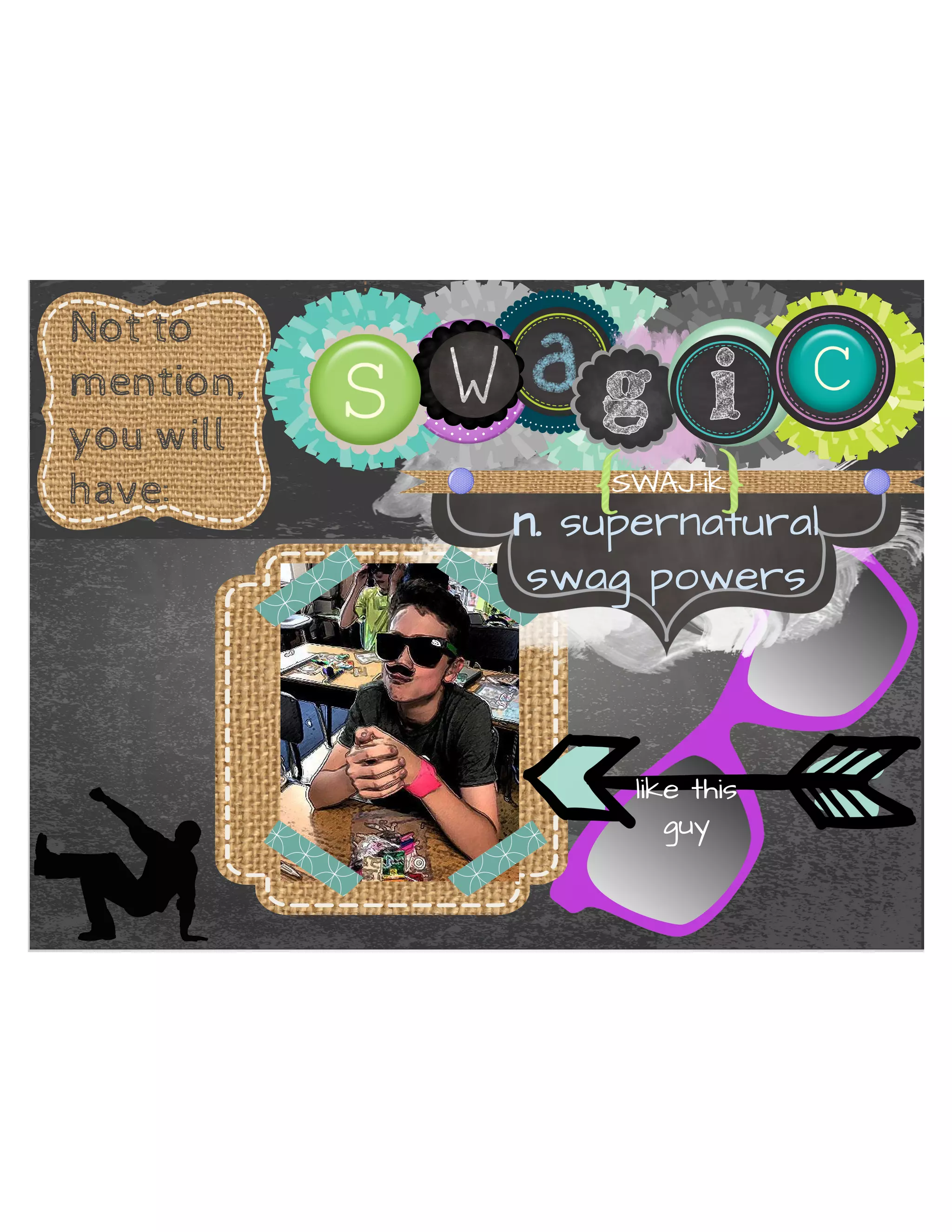
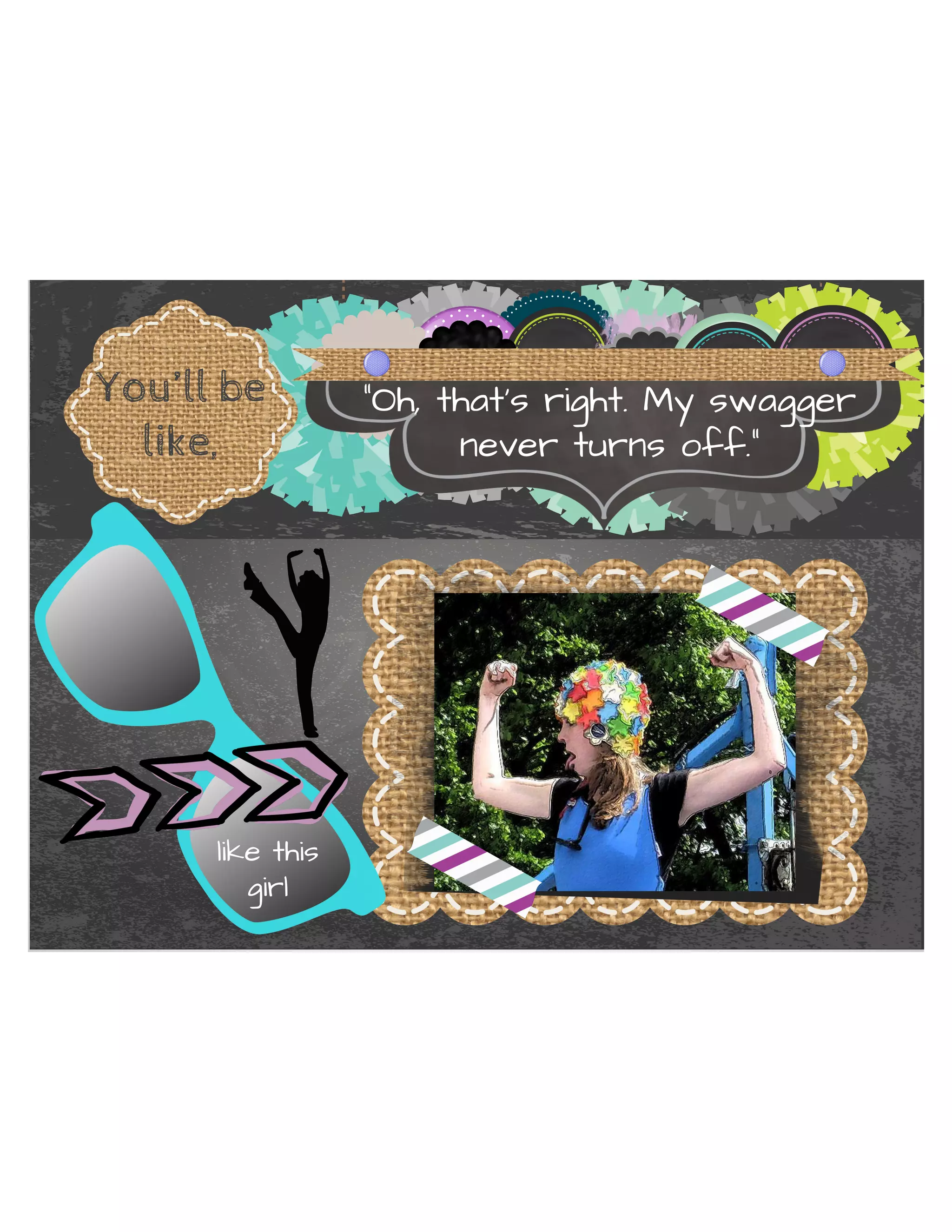
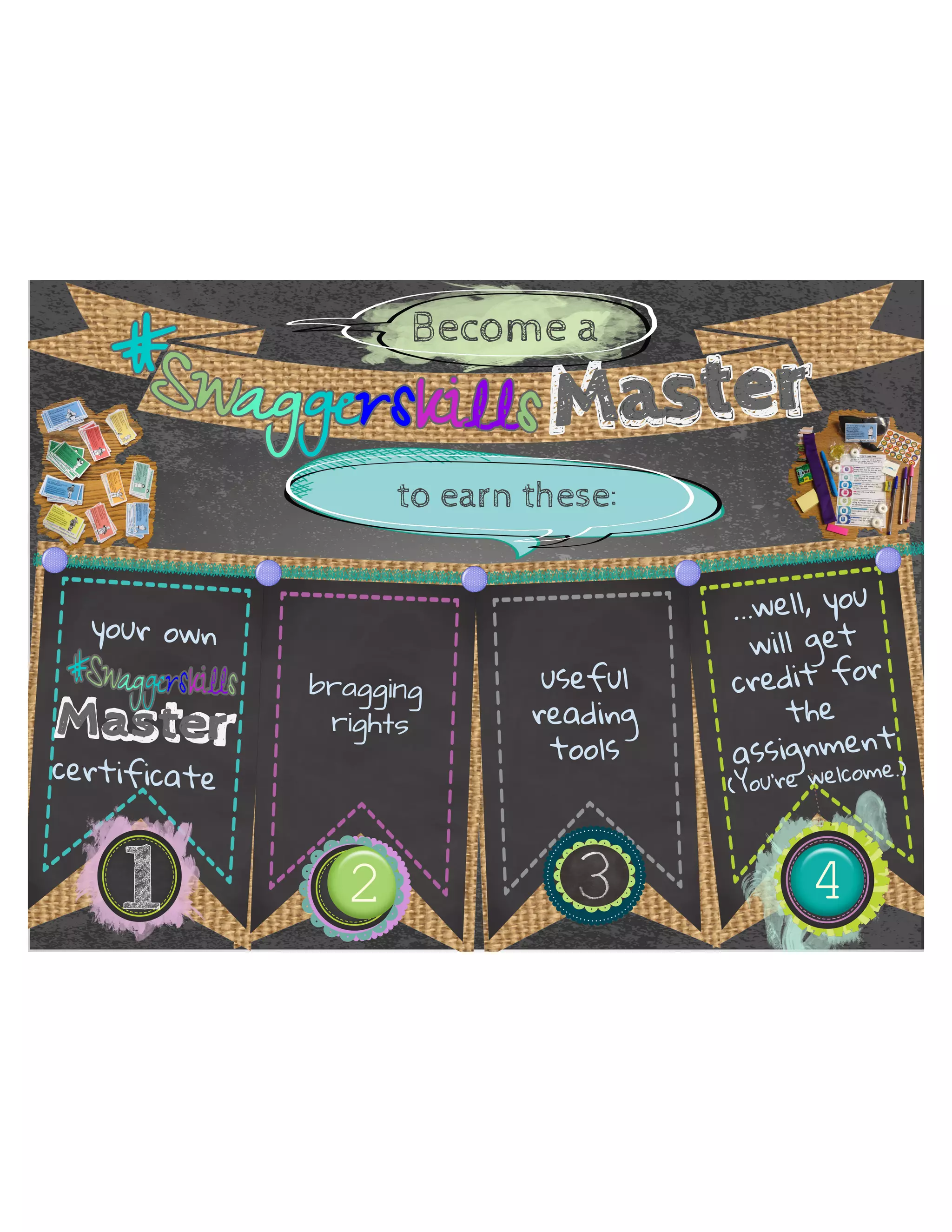
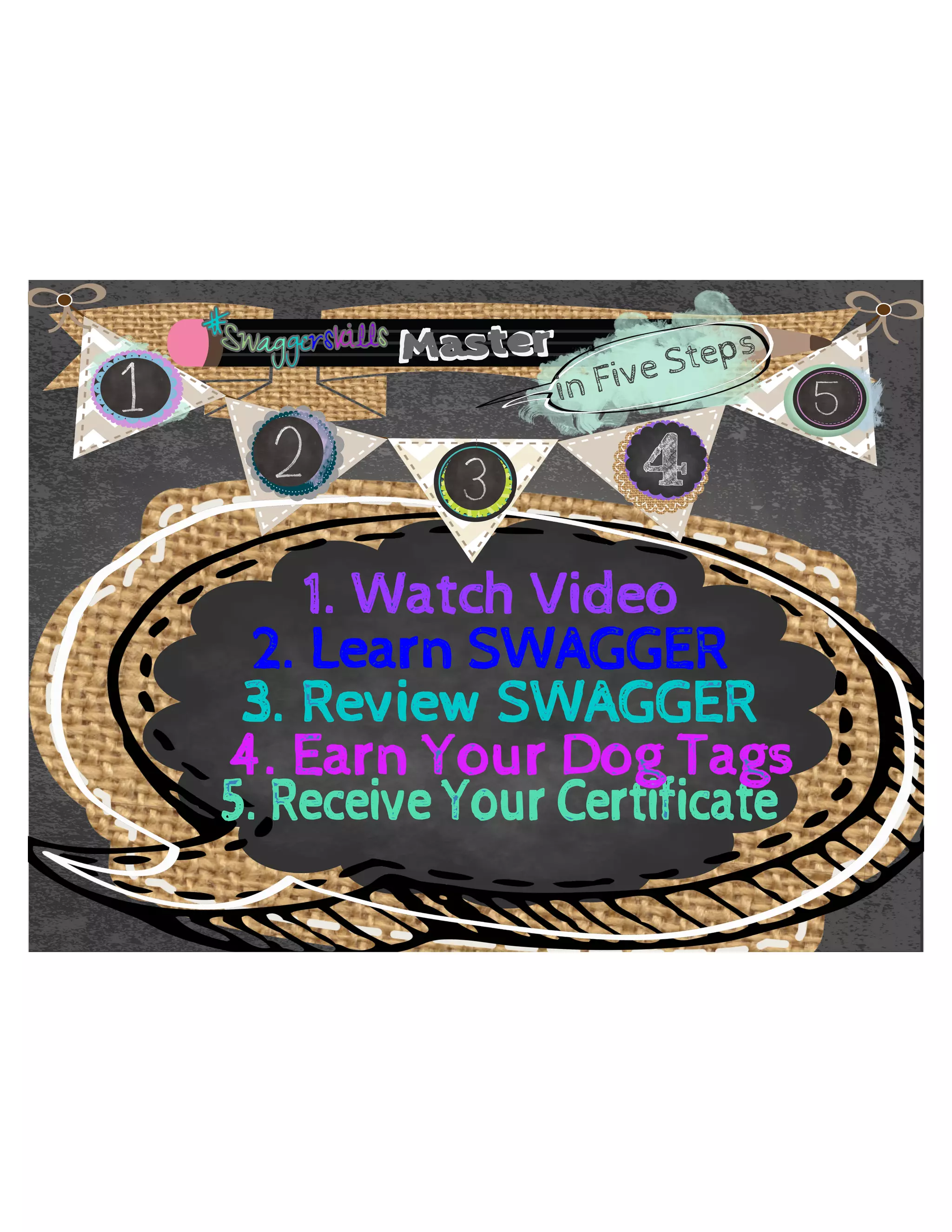
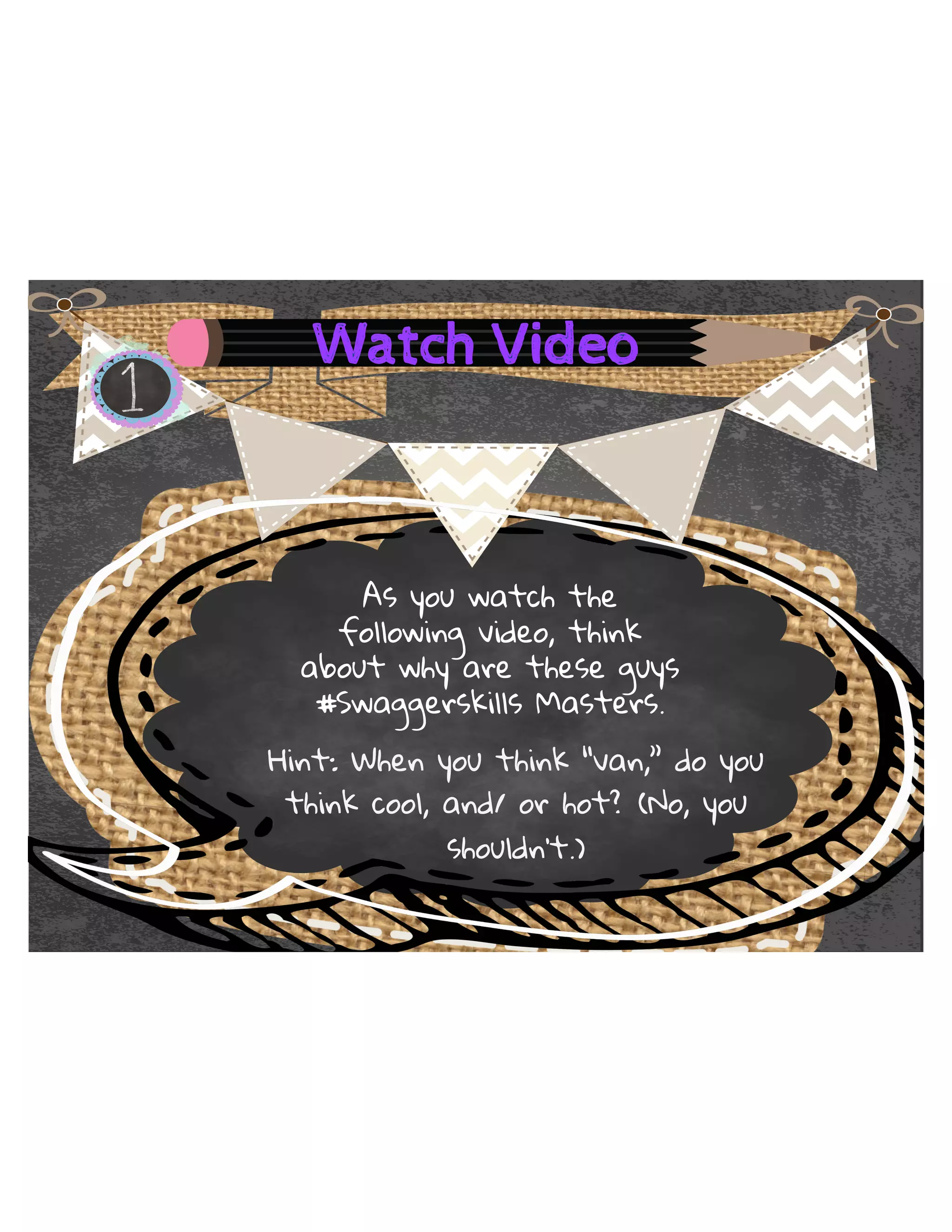
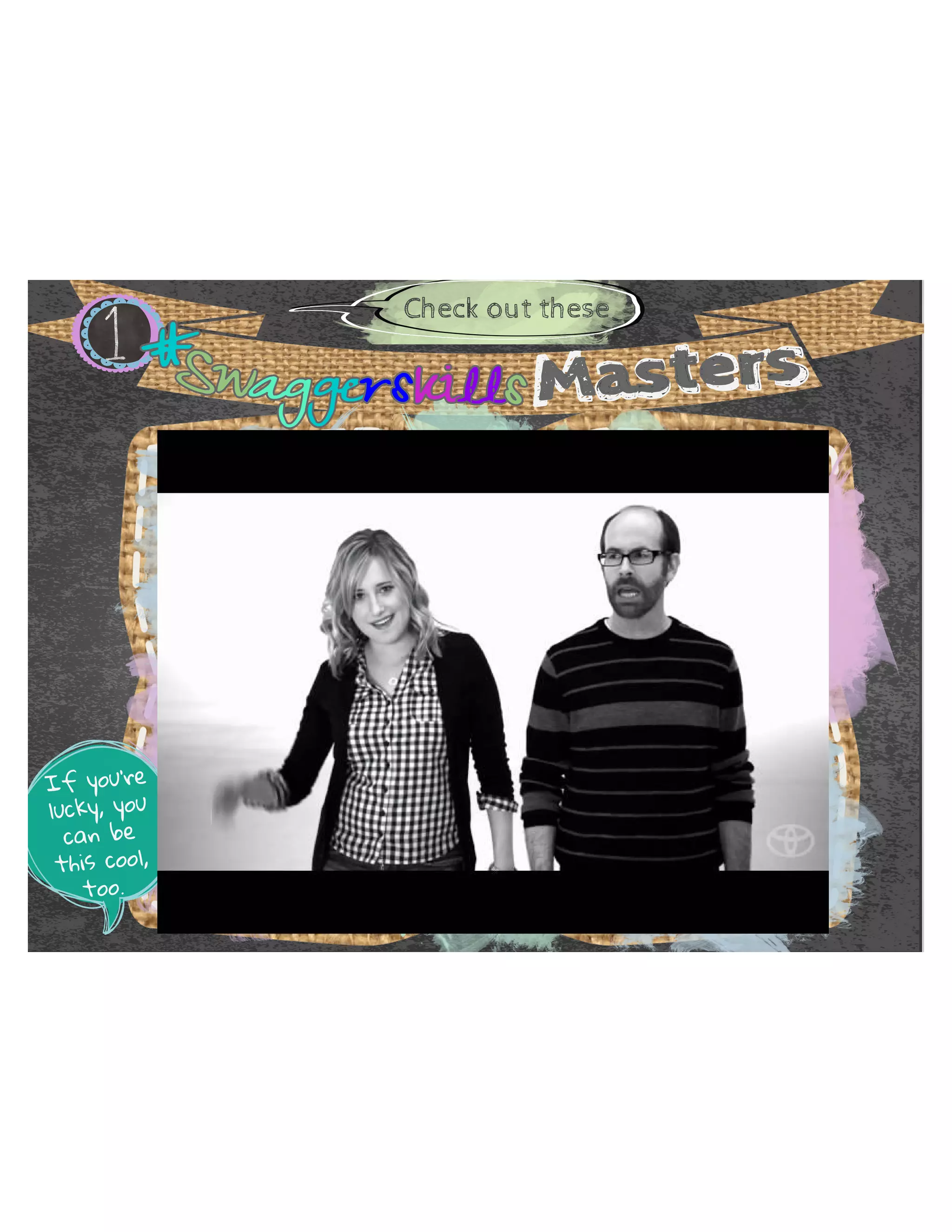
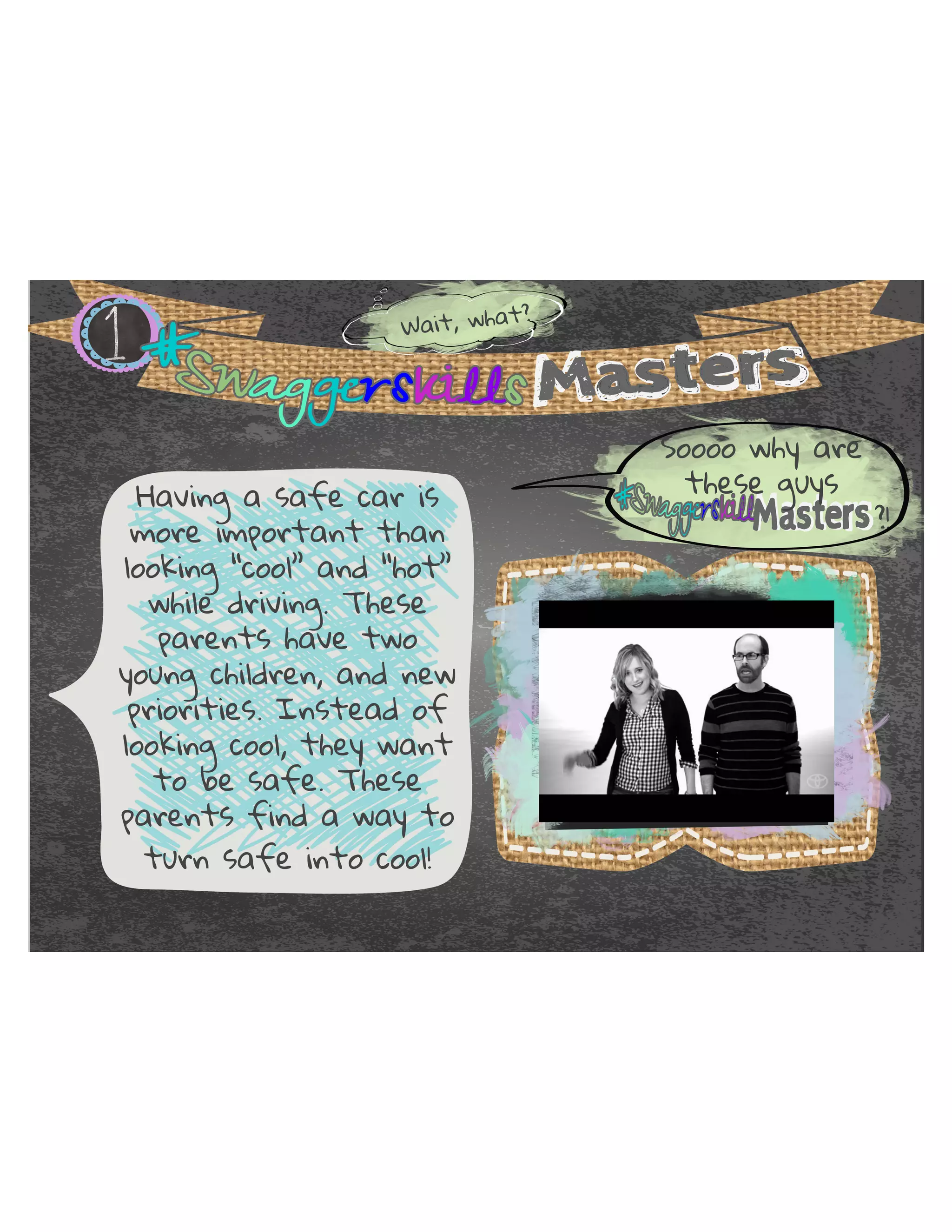
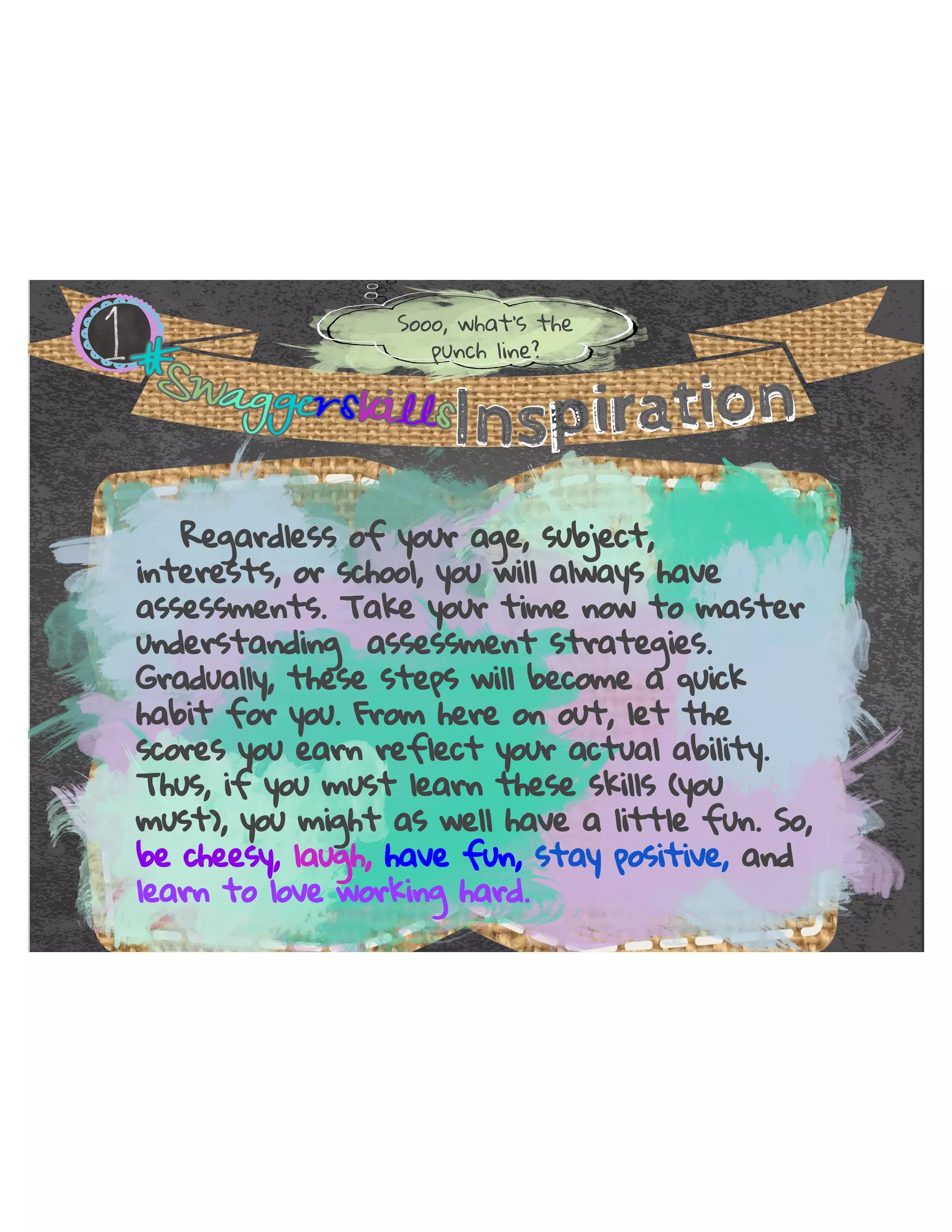
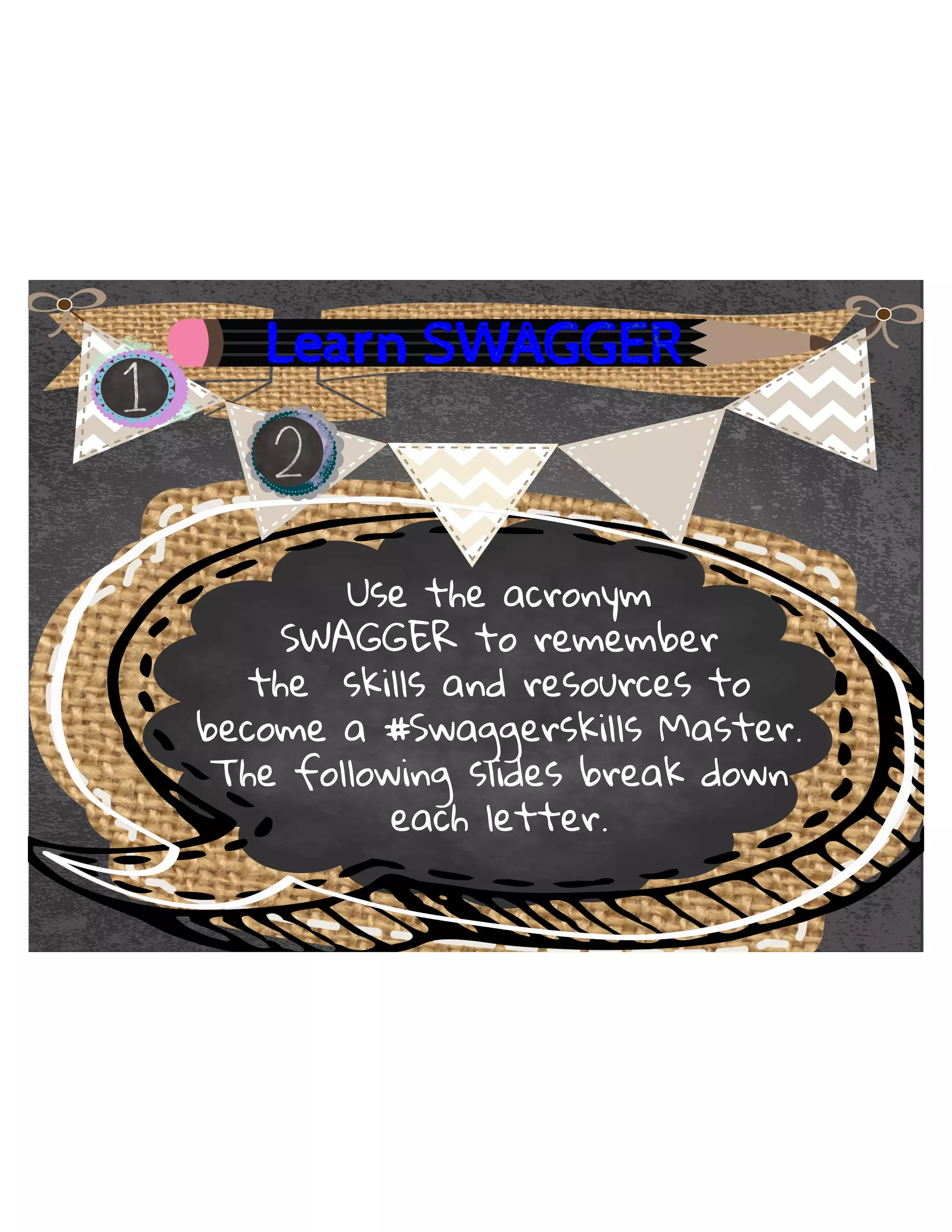
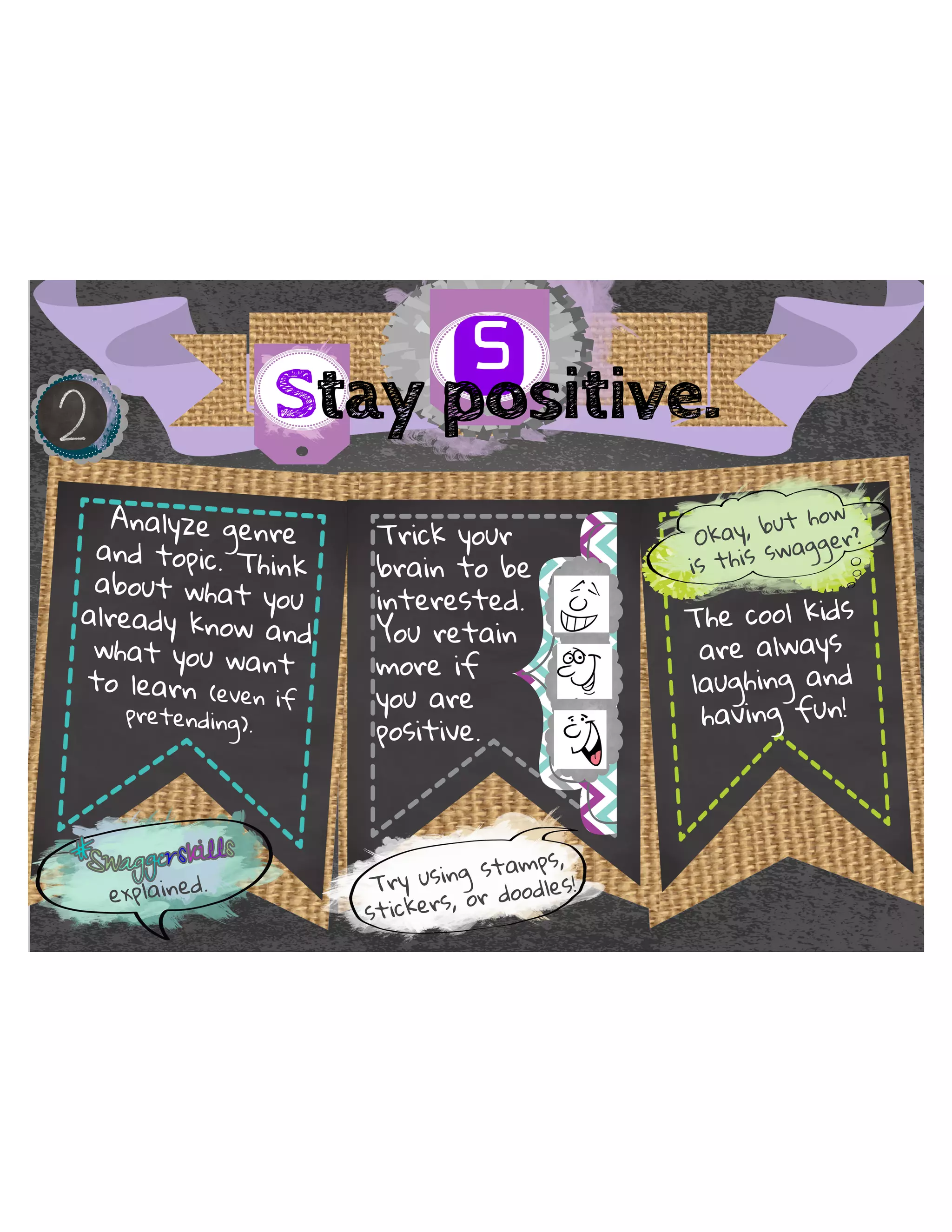

![6 6WDSRVLWLYH
$QDO]HJHQUH
DQGWRSLF7KLQN
DERXWZKDWRX
DOUHDGNQRZDQG
ZKDWRXZDQW
WROHDUQHYHQLI
SUHWHQGLQJ](https://image.slidesharecdn.com/swaggerassessmentskills-141113213247-conversion-gate02/75/Swagger-Assessment-Skills-Instructions-71-2048.jpg)
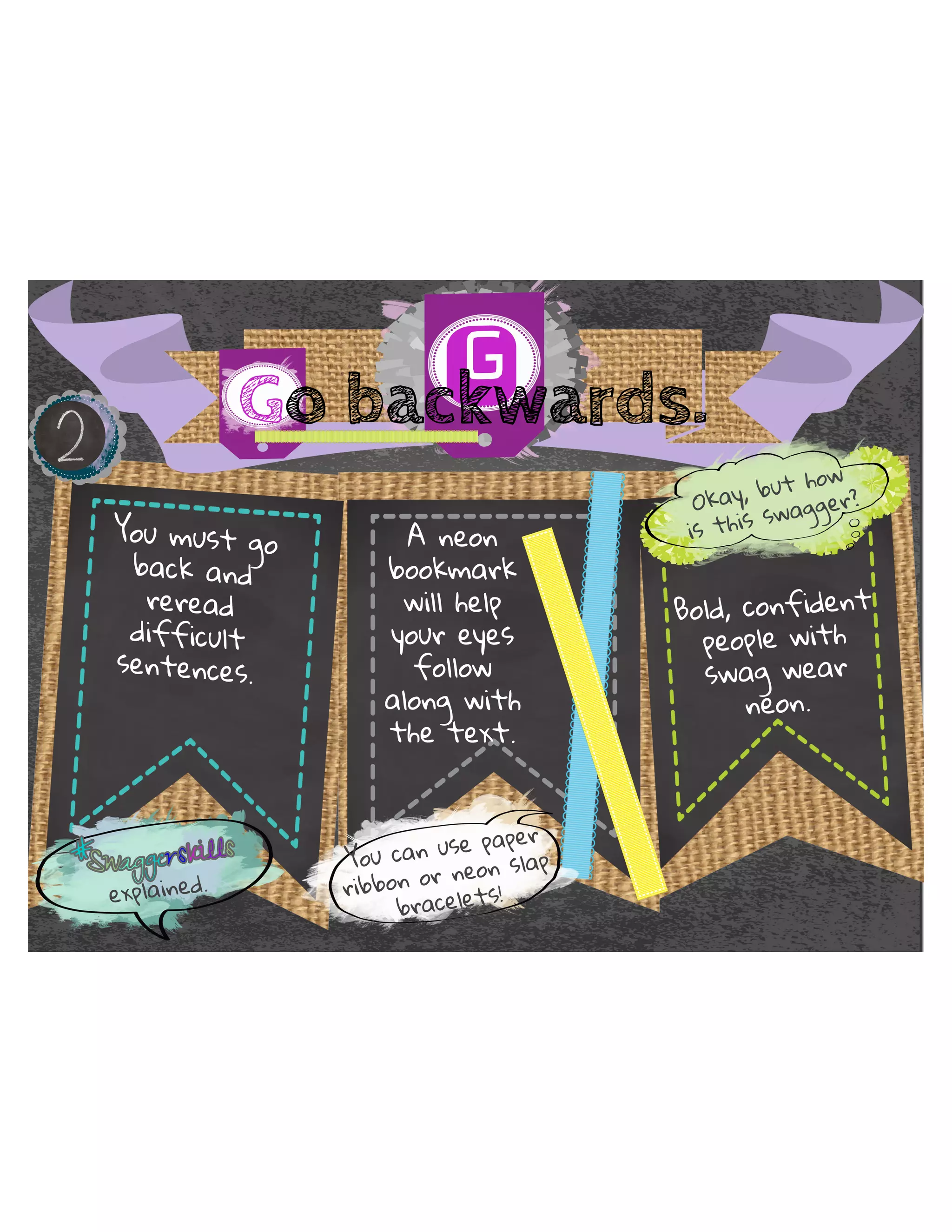
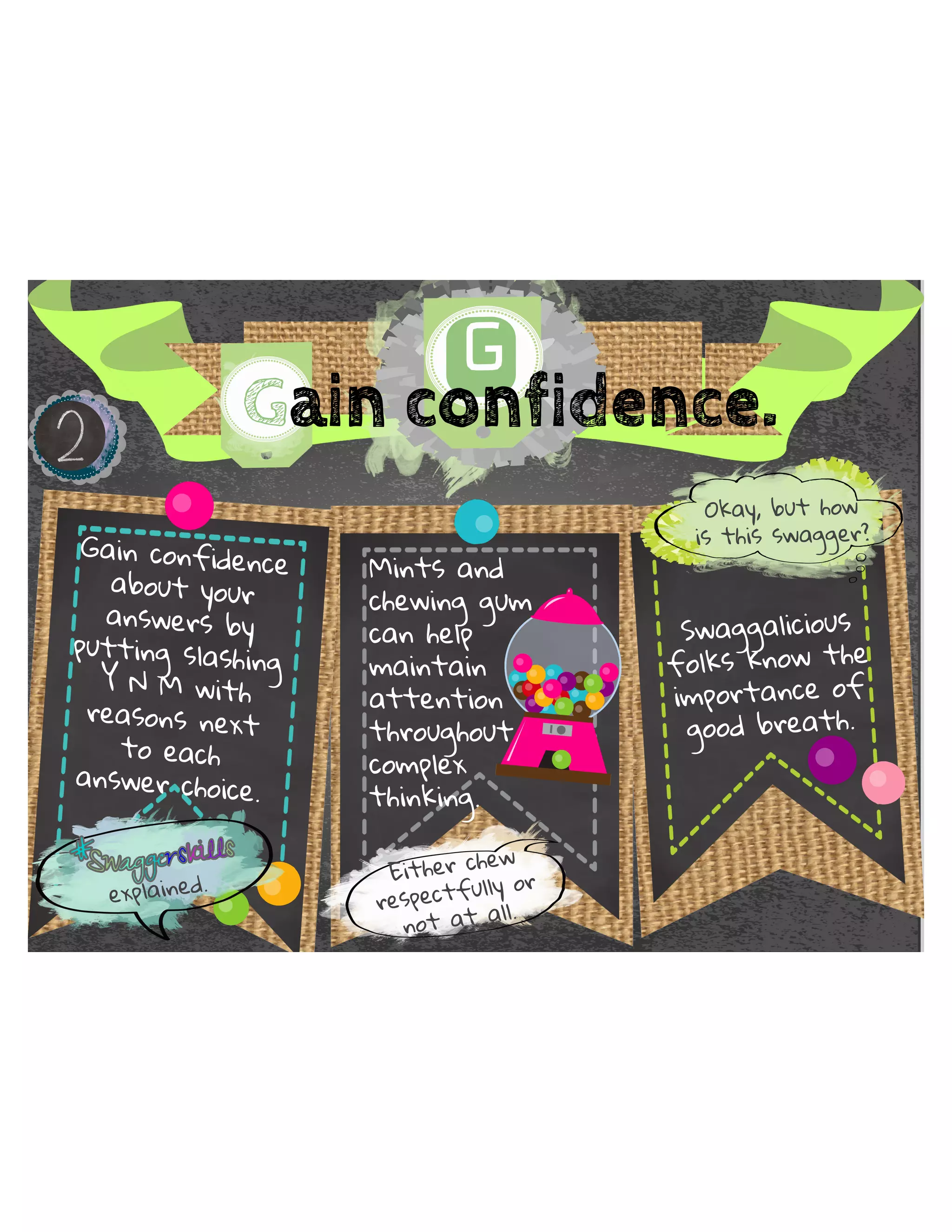
![$ $OZDVWKLQNUHDG
$OZDVXVH
FRQWH[WFOXHV
VFULEEOHWKRXJKWV
DQGLPSRUWDQW
QRWHVYLVXDOL]H
DQGPDNH
FRQQHFWLRQV
8VLQJVWLFN
QRWHVWKRXJKW
EXEEOHVDQG
FUHDWLYH
FDSWLRQV
ZLOOHQVXUH
DFWLYH
UHDGLQJ
2NDEXWKRZ
LVWKLVVZDJJHU
20*/2/
*QDUOH5DG
+8+1RZD
7RWHV
:KHQVWUXJJOLQJ
WRIRFXVWDNHWKH
PRVWQRWHV
H[SODLQHG](https://image.slidesharecdn.com/swaggerassessmentskills-141113213247-conversion-gate02/75/Swagger-Assessment-Skills-Instructions-74-2048.jpg)


![$OZDVILQG
WH[WEDVHG
HYLGHQFHDQG
VXPPDUL]HWKLV
QH[WWRRXU
FRUUHFWDQVZHU
FKRLFH
2NDEXWKRZ
LVWKLVVZDJJHU
7KHSUHWWLHVW
QRWHVDQG
FRROHVWGRRGOHV
DUHPDGHZLWK
FRORU
( (YLGHQFH
$OZDVXVLQJ
WKHVDPH
FRORUSHQWR
SURYHRXU
DQVZHUZLOO
SUHYHQW
GLVWUDFWLRQ
'LYLGHDVHWRI
FRORUHGSHQVZLWK
0)DYRULWH
3HQRORUV
IULHQGV
H[SODLQHG](https://image.slidesharecdn.com/swaggerassessmentskills-141113213247-conversion-gate02/75/Swagger-Assessment-Skills-Instructions-77-2048.jpg)

